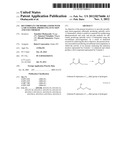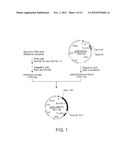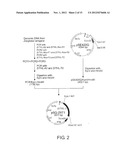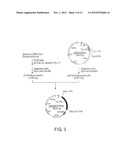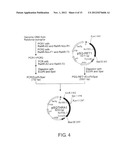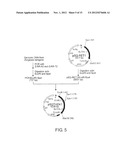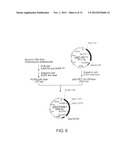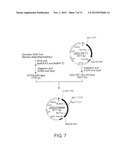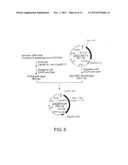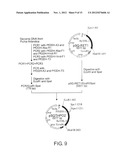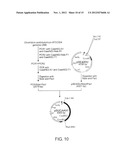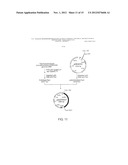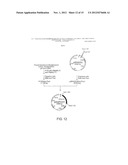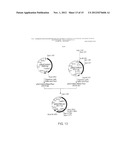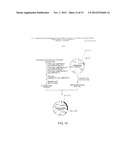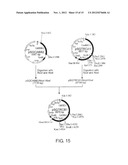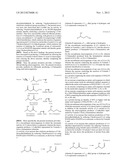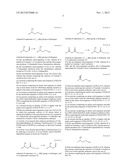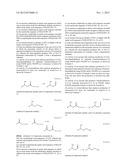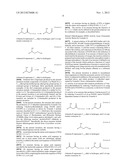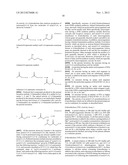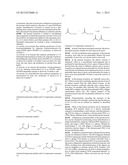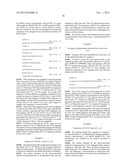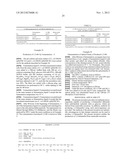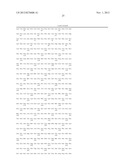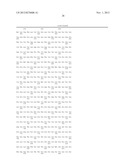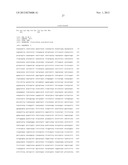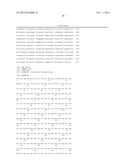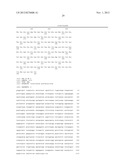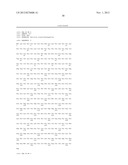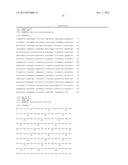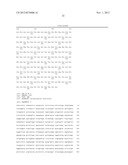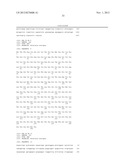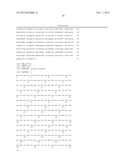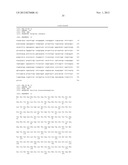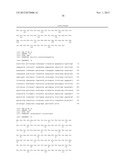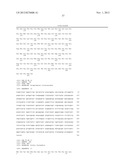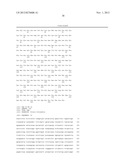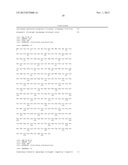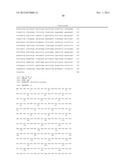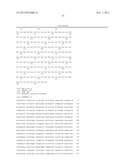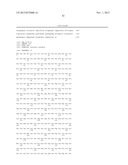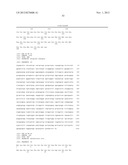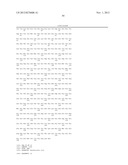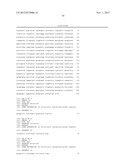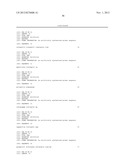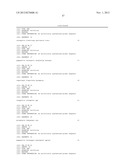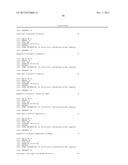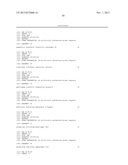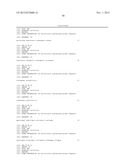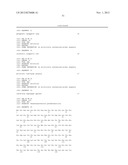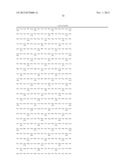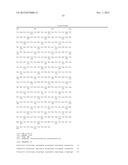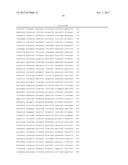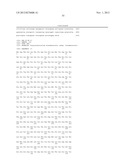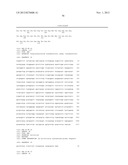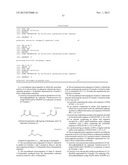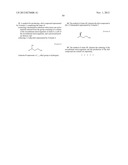Patent application title: RECOMBINANT MICROORGANISMS WITH 1,3-BUTANEDIOL-PRODUCING FUNCTION AND USES THEREOF
Inventors:
Tomohito Okabayashi (Hyogo, JP)
Takanori Nakajima (Niigata, JP)
Hiroaki Yamamoto (Niigata, JP)
Assignees:
DAICEL CORPORATION
IPC8 Class: AC12N121FI
USPC Class:
435158
Class name: Containing hydroxy group acyclic polyhydric
Publication date: 2012-11-01
Patent application number: 20120276606
Abstract:
An objective of the present invention is to provide recombinant
microorganisms efficiently producing optically active 1,3-butanediol,
which is useful as a material for synthesizing pharmaceuticals and such,
and provide methods for efficiently producing optically active
1,3-butanediol using the recombinant microorganisms. As a result of
dedicated research for achieving the above objective, the present
inventors succeeded in producing recombinant microorganisms in which the
activity of an enzyme catalyzing the reduction reaction represented by
Formula 1 is enhanced and which produce a diol compound represented by
Formula 2.
##STR00001## (wherein R represents a C1-3 alkyl group or
hydrogen)
##STR00002## (wherein R represents a C1-3 alkyl group or
hydrogen)Claims:
1. A recombinant microorganism in which the enzymatic activity of (1)
shown below is enhanced, wherein the microorganism produces 1,3-alkyldiol
represented by Formula 2 from a fermentation substrate: (1) activity of
an enzyme that catalyzes production of 3-hydroxyalkylaldehyde by reducing
3-hydroxyacyl-CoA using NADH and/or NADPH as a coenzyme, as shown by
Formula 1: ##STR00041## (wherein R represents a alkyl group or
hydrogen; and CoA represents coenzyme A) ##STR00042## (wherein R
represents a C1-3 alkyl group or hydrogen).
2. The recombinant microorganism of claim 1, wherein R is methyl in Formulas 1 and 2 recited in claim 1, and the microorganism produces 1,3-butanediol from a fermentation substrate.
3. The recombinant microorganism of claim 2, wherein 1,3-butanediol produced from the fermentation substrate recited in claim 2 is (R)-1,3-butanediol.
4. The recombinant microorganism of claim 1, wherein the enzyme catalyzing the reaction of Formula 1 recited in claim 1 (1) is classified as EC1.2.1.10 under the international classification of enzyme.
5. The recombinant microorganism of claim 1, wherein the enzyme catalyzing the reaction of Formula 1 recited in claim 1 (1) is any one of: (a) a protein comprising the amino acid sequence of SEQ ID NO: 1, 65, or 67; (b) an enzyme comprising an amino acid sequence in which one or more amino acids are substituted, deleted, inserted, or added in the amino acid sequence of SEQ ID NO: 1, 65, or 67; (c) an enzyme comprising an amino acid sequence encoded by the nucleotide sequence of SEQ ID NO: 2, 66, or 68; (d) an enzyme comprising an amino acid sequence encoded by a DNA which hybridizes under stringent conditions with a DNA comprising the nucleotide sequence of SEQ ID NO: 2, 66, or 68; and (e) a protein having an identity of 85% or higher with the amino acid sequence of SEQ ID NO: 1, 65, or 67.
6. The recombinant microorganism of claim 1, in which the enzymatic activity of (2) shown below is enhanced in addition to the enzymatic activity of (1) recited in claim 1, wherein the microorganism produces 1,3-alkyldiol represented by Formula 2 from a fermentation substrate: (1) activity of an enzyme that catalyzes production of 3-hydroxyalkylaldehyde by reducing 3-hydroxyacyl-CoA using NADH and/or NADPH as a coenzyme, as shown by Formula 1; and (2) activity of an enzyme that catalyzes production of 1,3-alkyldiol represented by Formula 2 by reducing 3-hydroxyalkylaldehyde using NADH and/or NADPH as a coenzyme, as shown by Formula 3 (Formula 3 does not show two reactions, but only shows the production of alcohol from aldehyde): ##STR00043## (wherein R represents a C1-3 alkyl group or hydrogen; and CoA represents coenzyme A) ##STR00044## (wherein R represents a C1-3 group or hydrogen) ##STR00045## (wherein R represents a C1-3 alkyl group or hydrogen).
7. The recombinant microorganism of claim 6, wherein R is methyl in Formulas 1 to 3 recited in claim 6, and the microorganism produces 1,3-butanediol from a fermentation substrate.
8. The recombinant microorganism of claim 7, wherein 1,3-butanediol produced from the fermentation substrate recited in claim 7 is (R)-1,3-butanediol.
9. The recombinant microorganism of claim 6, wherein the enzyme catalyzing the reaction or Formula 3 recited in claim 6 is any one of: (a) a protein comprising the amino acid sequence of SEQ ID NO: 3, 5, or 7; (b) an enzyme comprising an amino acid sequence in which one or more amino acids are substituted, deleted, inserted, or added in the amino acid sequence of SEQ ID NO: 3, 5, or 7; (c) an enzyme comprising an amino acid sequence encoded by the nucleotide sequence of SEQ ID NO: 4, 6, or 8; (d) an enzyme comprising an amino acid sequence encoded by a DNA whim hybridizes under stringent conditions with a DNA comprising the nucleotide sequence of SEQ ID NO: 4, 6, or 8; and (e) an enzyme having an identity of 85% or higher with the amino acid sequence of SEQ ID NO: 3, 5, or 7.
10. The recombinant microorganism of claim 1, in which the enzymatic activity of (3) shown below is enhanced in addition to the enzymatic activity of (1) recited in claim 1, wherein the microorganism produces 1,3-alkyldiol represented by Formula 2 from a fermentation substrate: (1) activity of an enzyme that catalyzes production of 3-hydroxyalkylaldehyde by reducing 3-hydroxyacyl-CoA using NADH and/or NADPH as a coenzyme, as shown by Formula 1: and (3) activity of an enzyme that produces 3-hydroxyacyl-CoA by reducing 3-oxoacyl-CoA in an NADH- and/or NADPH-dependent manner as shown by Formula 4: ##STR00046## (wherein R represents a C1-3 alkyl group or hydrogen; and CoA represents coenzyme A) ##STR00047## (wherein R represents a C1-3 alkyl group or hydrogen) ##STR00048## (wherein R represents a C1-3 alkyl group or hydrogen; and CoA represents coenzyme A).
11. The recombinant microorganism of claim 10, wherein R is methyl in Formulas 1 and 2 recited in claim 10, and the microorganism produces (R)-1,3-butanediol represented by Formula 5 from a fermentation substrate: ##STR00049##
12. The recombinant microorganism of claim 10, wherein the enzyme catalyzing the reaction of Formula 4 recited in claim 10 is an R-form-specific reductase, and is any one of: (a) a protein comprising the amino acid sequence of SEQ ID NO: 9, 11, 13, 15, or 17; (b) an enzyme comprising an amino acid sequence in which one or more amino acids are substituted, deleted, inserted, or added in the amino acid sequence of SEQ ID NO: 9, 11, 13, 15, or 17; (c) an enzyme comprising an amino acid sequence encoded by the nucleotide sequence of SEQ ID NO: 10, 12, 14, 16, or 18; (d) an enzyme comprising an amino acid sequence encoded by a DNA which hybridizes under stringent conditions with a DNA comprising the nucleotide sequence of SEQ ID NO: 10, 12, 14, 16, or 18, and (e) an enzyme having an identity of 85% or higher with the amino acid sequence of SEQ ID NO: 9, 11, 13, 15, or 17.
13. A method for producing a diol compound represented by Formula 2, comprising the steps of: contacting a fermentation substrate with at least one active material selected from the group consisting of a culture of the recombinant microorganism of claim 1, a cell of the recombinant microorganism, and a processed product thereof; and collecting 1,3-alkyodiol represented by Formula 2: ##STR00050## (wherein R represents a C1-3 alkyl group or hydrogen).
14. The method of claim 13, wherein the diol compound is (R)-1,3-butanediol represented by Formula 5 ##STR00051##
15. The method of claim 13, wherein the culturing of the recombinant microorganism and the production of the diol compound are carried out separately.
Description:
TECHNICAL FIELD
[0001] The present invention is related to recombinant microorganisms with a 1,3-butanediol-producing function, and methods for producing 1,3-butanediol using the microorganisms.
BACKGROUND ART
[0002] 1,3-Butanediol is useful as a chemical with various applications, such as moisturizers, resin materials, surfactants, moisture absorbents, and solvents, and as a raw material thereof. Also, its optically active molecules, (R)-1,3-butanediol and (S)-1,3-butanediol, are useful as raw materials for synthesizing pharmaceuticals, agrochemicals, and such.
[0003] Conventionally, 1,3-butanediol is made by chemical production in which acetaldehyde chemically manufactured from petroleum, a fossil resource, is used as a raw material to produce acetaldol, which is then hydrogenated. Meanwhile, optically active 1,3-butanediol can be produced by methods represented by Patent Document 1, in which (R)- or (S)-1,3-butanediol is produced by allowing a microorganism capable of preferentially assimilating either its (S)- or (R)-isomer, such as Candida palapsilosis or Kluyveromyces lacitis, to act on racemic 1,3-butanediol chemically synthesized from fossil resources, and then collecting the remaining enantiomer.
[0004] In other methods represented by Patent Document 2, (R)- or (S)-1,3-butanediol is produced by allowing a microorganism such as Kluyveromyces lactis or Candida palapsilosis to act on 4-hydroxy-2-butanone chemically synthesized from fossil resources, and utilizing the asymmetric reduction activity of the microorganism.
[0005] Furthermore, there are methods of producing optically active 1,3-butanediol in one or two steps using stereo-selective oxidoreductases or recombinant bacteria overexpressing such enzymes. Such methods include: the production of (R)-1,3-butanediol from the racemic form using a (S)-specific secondary alcohol dehydrogenase derived from Geotricum sp. (Non-patent Document 1); the production of (R)-1,3-butanediol from the racemic form using recombinant Escherichia coli expressing a (S)-specific secondary alcohol dehydrogenase derived from Candida palapsilosis (Patent Document 3), the production of (R)-1,3-butanediol from 4-hydroxy-2-butanone or the production of (S)-1,3-butanediol from the racemic form using recombinant E. coli expressing an (R)-specific 2,3-butanediol dehydrogenase derived from Kluyveromyces lactis (Patent Document 4). However, all these methods use a non-natural compound as a substrate, which needs to be chemically synthesized.
[0006] Meanwhile, in Non-patent Document 2, 1,3-butanediol was detected in the culture fluid of Geotricum fragrans cultured in a medium containing cassava waste. However, 1,3-butanediol was found as one of the volatile substances, and the culture was not intended to produce 1,3-butanediol.
[0007] In recent years, from the view point of the depletion of fossil resources and global warming, there has been an increasing social demand for establishment of chemical production systems that use biomass (botanical resource)--derived materials as renewable resources.
[0008] For example, it is known that solvents can be produced from glucose, one of the biomass-derived materials, via a CoA-derivative using the acetone-butanol fermentation pathway, as represented by Clostridium acetobutylicum. For the type strain of this species, C. acetobutylicum ATCC824, the entire genomic DNA sequence has been sequenced, and a solvent-producing gene characteristic of acetone-butanol fermentation bacteria, adhE (an aldehyde-alcohol dehydrogenase that has the functions of EC1.2.1.10 and EC1.1.1.1), has been revealed (Non-patent Document 3). There has been few enzymological reports for the gene product of adhE derived from C. acetobutylicum (aldehyde-alcohol dehydrogenase that has the functions of EC1.2.1.10 and EC1.1.1.1), and only the assessment of the cell-free extract of C. acetobutylicum DSM1732 has been performed for the butanol dehydrogenase activity using butanol or butylaldehyde as a substrate and for the butylaldehyde dehydrogenase activity using butylaldehyde or butyryl-CoA as a substrate, in Non-patent Document 4. The adhE gene product has never been used for other purposes than producing 1-butanol as represented by Non-patent Document 5.
[0009] There has been no report of producing 1,3-butanediol from biomass-derived materials, and there has been a demand for a method of producing 1,3-butanediol from renewable resources such as biomass.
PRIOR ART DOCUMENTS
Patent Documents
[0010] [Patent Document 1] Japanese Patent Application Kokai Publication No. (JP-A) H02-195897 (unexamined, published Japanese patent application) [0011] [Patent Document 2] JP-A (Kokai) H02-31684 [0012] [Patent Document 3] JP-A (Kokai) 2000-197485 [0013] [Patent Document 4] JP-A (Kokai) 2002-345479
Non-Patent Documents
[0013] [0014] [Non-patent Document 1] Biosci. Biotech. Biochem., 1996, 60(7), 1191-1192 [0015] [Non-patent Document 2] Proc. Biochem., 2003, 39, 411-414 [0016] [Non-patent Document 3] J. Bacteriol., 2001, 183(16), 4823-4838 [0017] [Non-patent Document 4] Appl. Microbial. Biotechnol., 1987, 26, 268-272 [0018] [Non-patent Document 5] Metabol. Engineer., 2008, 10, 305-311
SUMMARY OF THE INVENTION
Problems to be Solved by the Invention
[0019] An objective of the present invention is to provide microorganisms capable of producing 1,3-butanediol from renewable resources of biomass (botanical resources). Another objective of the present invention is to provide methods by which 1,3-butanediol can be produced using microorganisms having a desired function(s).
Means for Solving the Problems
[0020] As a result of dedicated research to develop a method for producing 1,3-butanediol from biomass, which is a renewable resource, the present inventors have discovered that AdhE derived from Clostridium acetobutylicum (CaAdhE) not only generates acetaldehyde and butylaldehyde by reducing acetyl-CoA and butyryl-CoA in an NADH-dependent manner, but also surprisingly generates 3-hydroxybutylaldehyde by reducing 3-hydroxybutyryl-CoA, which has a hydroxyl group at position 3. The present inventors have also discovered that CaAdhE has an activity of reducing 3-hydroxybutylaldehyde in an NADH-dependent manner, thereby catalyzing a reaction of producing 1,3-butanediol. They have successfully achieved efficient production of 1,3-butanediol by culturing, with glucose as a carbon source, recombinant E. coli capable of coexpressing CaAdhE with β-ketothiolase, which catalyzes the reaction of generating acetoacetyl-CoA from two molecules of acetyl-CoA, and 3-hydroxybutyryl-CoA dehydrogenase, which catalyzes the reaction of reducing the 3-carbonyl group of acetoacetyl-CoA in an NAD(P)H-dependent manner and thereby generating 3-hydroxybutyryl-CoA.
[0021] Based on the above findings, the present inventors have succeeded in producing 1,3-butanediol by allowing the reaction of Formula 8 shown below to occur in microorganisms carrying the above enzymes, thereby completing the present invention.
[0022] Thus, the present invention provides 1,3-butanediol-producing microorganisms. Also, the present invention provides methods for efficiently producing 1,3-butanediol using such microorganisms.
##STR00003##
[0023] More specifically, the present inventions provides:
[1] a recombinant microorganism in which the enzymatic activity of (1) shown below is enhanced, wherein the microorganism produces 1,3-alkyldiol represented by Formula 2 from a fermentation substrate: (1) activity of an enzyme that catalyzes production of 3-hydroxyalkylaldehyde by reducing 3-hydroxyacyl-CoA using NADH and/or NADPH as a coenzyme, as shown by Formula 1:
##STR00004##
(wherein R represents a C1-3 alkyl group or hydrogen; and CoA represents coenzyme A)
##STR00005##
(wherein R represents a C1-3 alkyl group or hydrogen); [2] the recombinant microorganism of [1], wherein R is methyl in Formulas 1 and 2 recited in [1], and the microorganism produces 1,3-butanediol from a fermentation substrate; [3] the recombinant microorganism of [1] or [2], wherein 1,3-butanediol produced from the fermentation substrate recited in [2] is (R)- or (S)-1,3-butanediol; [4] the recombinant microorganism of any one of [1] to [3], wherein the enzyme catalyzing the reaction of Formula 1 recited in [1] (1) is classified as EC1.2.1.10 under the international classification of enzyme; [5] the recombinant microorganism of any one of [1] to [4], wherein the enzyme catalyzing the reaction of Formula 1 recited in [1] (1) is any one of: (a) a protein comprising the amino acid sequence of SEQ ID NO: 1, 65, or 67; (b) an enzyme comprising an amino acid sequence in which one or more amino acids are substituted, deleted, inserted, or added in the amino acid sequence of SEQ ID NO: 1, 65, or 67; (c) an enzyme comprising an amino acid sequence encoded by the nucleotide sequence of SEQ ID NO: 2, 66, or 68; (d) an enzyme comprising an amino acid sequence encoded by a DNA Which hybridizes under stringent conditions with a DNA comprising the nucleotide sequence of SEQ ID NO: 2, 66, or 68; and (e) a protein having an identity of 85% or higher with the amino acid sequence of SEQ ID NO: 1, 65, or 67; [6] the recombinant microorganism of any one of [1] to [5], in which the enzymatic activity of (2) shown below is enhanced in addition to the enzymatic activity of (1) recited in [1], wherein the microorganism produces 1,3-alkyldiol represented by Formula 2 from a fermentation substrate: (1) activity of an enzyme that catalyzes production of 3-hydroxyalkylaldehyde by reducing 3-hydroxyacyl-CoA using NADH and/or NADPH as a coenzyme, as shown by Formula 1; and (2) activity of an enzyme that catalyzes production of 1,3-alkyldiol represented by Formula 2 by reducing 3-hydroxyalkylaldehyde using NADH and/or NADPH as a coenzyme, as shown by Formula 3 (Formula 3 does not show two reactions, but only shows the production of alcohol from aldehyde):
##STR00006##
(wherein R represents a C1-3 alkyl group or hydrogen; and CoA represents coenzyme A)
##STR00007##
(wherein R represents a C1-3 alkyl group or hydrogen)
##STR00008##
(wherein R represents a C1-3 alkyl group or hydrogen); [7] the recombinant microorganism of [6], wherein R is methyl in Formulas 1 to 3 recited in [6], and the microorganism produces 1,3-butanediol from a fermentation substrate; [8] the recombinant microorganism of [6] or [7], wherein 1,3-butanediol produced from the fermentation substrate recited in [7] is (R)- or (S)-1,3-butanediol; [9] the recombinant microorganism of any one of [6] to [8], wherein the enzyme catalyzing the reaction of Formula 3 recited in [6] is any one of: (a) a protein comprising the amino acid sequence of SEQ ID NO: 3, 5, or 7; (b) an enzyme comprising an amino acid sequence in which one or more amino acids are substituted, deleted, inserted, or added in the amino acid sequence of SEQ ID NO: 3, 5, or 7; (c) an enzyme comprising an amino acid sequence encoded by the nucleotide sequence of SEQ ID NO: 4, 6, or 8; (d) an enzyme comprising an amino acid sequence encoded by a DNA which hybridizes under stringent conditions with a DNA comprising the nucleotide sequence of SEQ ID NO: 4, 6, or 8; and (e) a protein having an identity of 85% or higher with the amino acid sequence of SEQ ID NO: 3, 5, or 7; [10] the recombinant microorganism of any one of [1] to [5], in which the enzymatic activity of (3) shown below is enhanced in addition to the enzymatic activity of (1) recited in [1], wherein the microorganism produces 1,3-alkyldiol represented by Formula 2 from a fermentation substrate: (1) activity of an enzyme that catalyzes production of 3-hydroxyalkylaldehyde by reducing 3-hydroxyacyl-CoA using NADH and/or NADPH as a coenzyme, as shown by Formula 1; and (3) activity of an enzyme that produces 3-hydroxyacyl-CoA by reducing 3-oxoacyl-CoA in an NADH- and/or NADPH-dependent manner as shown by Formula 4:
##STR00009##
(wherein R represents a C1-3 alkyl group or hydrogen; and CoA represents coenzyme A)
##STR00010##
(wherein R represents a C1-3 alkyl group or hydrogen)
##STR00011##
(wherein R represents a C1-3 alkyl group or hydrogen; and CoA represents coenzyme A); [11] the recombinant microorganism of [10], wherein R is methyl in Formulas 1 and 2 recited in [10], and the microorganism produces (R)-1,3-butanediol represented by Formula 5 from a fermentation substrate:
##STR00012##
[12] the recombinant microorganism of [10] or [11], wherein the enzyme catalyzing the reaction of Formula 4 recited in [10] is an R-form-specific reductase, and is any one of: (a) a protein comprising the amino acid sequence of SEQ ID NO: 9, 11, 13, 15, or 17; (b) an enzyme comprising an amino acid sequence in which one or more amino acids are substituted, deleted, inserted, or added in the amino acid sequence of SEQ ID NO: 9, 11, 13, 15, or 17; (c) an enzyme comprising an amino acid sequence encoded by the nucleotide sequence of SEQ ID NO: 10, 12, 14, 16, or 18; (d) an enzyme comprising an amino acid sequence encoded by a DNA which hybridizes under stringent conditions with a DNA comprising the nucleotide sequence of SEQ ID NO: 10, 12, 14, 16, or 18; and (e) an enzyme having an identity of 85% or higher with the amino acid sequence of SEQ ID NO: 9, 11, 13, 15, or 17; [13] the recombinant microorganism of [10], wherein R is methyl in Formulas 1 and 2 recited in [10], and the microorganism produces (S)-1,3-butanediol represented by Formula 6 from a fermentation substrate:
##STR00013##
[14] the recombinant microorganism of [10] or [13], wherein the enzyme catalyzing the reaction of Formula 4 recited in [10] is an S-form-specific reductase, and is any one of (a) a protein comprising the amino acid sequence of SEQ ID NO: 19; (b) an enzyme comprising an amino acid sequence in which one or more amino acids are substituted, deleted, inserted, or added in the amino acid sequence of SEQ ID NO: 19; (c) an enzyme comprising an amino acid sequence encoded by the nucleotide sequence of SEQ ID NO: 20: (d) an enzyme comprising an amino acid sequence encoded by a DNA which hybridizes under stringent conditions with a DNA comprising the nucleotide sequence of SEQ ID NO: 20; and (e) an enzyme having an identity of 85% or higher with the amino acid sequence of SEQ ID NO: 19; [15] the recombinant microorganism of any one of [1] to [5], in which the enzymatic activity of (4) shown below is enhanced in addition to the enzymatic activity of (1) recited in [1], wherein the microorganism produces (R)- or (S)-1,3-butanediol represented by Formula 2 from a fermentation substrate: (1) activity of an enzyme that catalyzes production of 3-hydroxybutylaldehyde by reducing 3-hydroxybutyryl-CoA using NADH and/or NADPH as a coenzyme, as shown by Formula 1; and (4) activity of a β-ketothiolase that catalyzes production of acetoacetyl-CoA from two molecules of acetyl-CoA as shown by Formula 7:
##STR00014##
(wherein R represents methyl; and CoA represents coenzyme A)
##STR00015##
(wherein R represents methyl)
##STR00016##
[0024] (wherein CoA represents coenzyme A);
[16] the recombinant microorganism of [15], wherein the enzyme catalyzing the reaction of Formula 7 recited in [15] is any one of: (a) a protein comprising the amino acid sequence of SEQ ID NO: 21, 23, or 25; (b) an enzyme comprising an amino acid sequence in which one or more amino acids are substituted, deleted, inserted, or added in the amino acid sequence of SEQ ID NO: 21, 23, or 25; (c) an enzyme comprising an amino acid sequence encoded by the nucleotide sequence of SEQ ID NO: 22, 24, or 26; (d) an enzyme comprising an amino acid sequence encoded by a DNA which hybridizes under stringent conditions with a DNA comprising the nucleotide sequence of SEQ ID NO: 22, 24, or 26; and (e) an enzyme having an identity of 85% or higher with the amino acid sequence of SEQ ID NO: 21, 23, or 25; [17] the recombinant microorganism of any one of [1] to [5], in which the enzymatic activities of (2) to (4) shown below are enhanced in addition to the enzymatic activity of (1) recited in [1], wherein the microorganism produces (R)- or (S)-1,3-butanediol represented by Formula 2 from a fermentation substrate: (1) activity of an enzyme that catalyzes production of 3-hydroxybutylaldehyde by reducing β-hydroxybutyryl-CoA using NADH and/or NADPH as a coenzyme, as shown by Formula 1; (2) activity of an enzyme that catalyzes production of 1,3-butanediol represented by Formula 2 by reducing 3-hydroxybutylaldehyde using NADH and/or NADPH as a coenzyme, as shown by Formula 3 (Formula 3 does not show two reactions, but only shows the production of alcohol from aldehyde); (3) activity of an enzyme that produces 3-hydroxybutyryl-CoA by reducing acetoacetyl-CoA in an NADH- and/or NADPH-dependent manner as shown by Formula 4; (4) activity of a β-ketothiolase that catalyzes production of acetoacetyl-CoA from two molecules of acetyl-CoA as shown by Formula 7:
##STR00017##
(wherein R represents methyl; and CoA presents coenzyme A)
##STR00018##
(wherein R represents methyl)
##STR00019##
(wherein R represents methyl)
##STR00020##
(wherein R represents methyl, and CoA represents coenzyme A)
##STR00021##
(wherein CoA represents coenzyme A); [18] the recombinant microorganism of any one of [1] to [17], wherein the host cell is Escherichia coli; [19] a method for producing a diol compound represented by Formula 2, comprising the steps of
[0025] contacting a fermentation substrate with at least one active material selected from the group consisting of a culture of the recombinant microorganism of any one of [1] to [18], a cell of the recombinant microorganism, and a processed product thereof; and
[0026] collecting 1,3-alkyodiol represented by Formula 2:
##STR00022##
(wherein R represents a C1-3 alkyl group or hydrogen); [20] the method of [19], wherein the diol compound is (R)-1,3-butanediol represented by Formula 5.
##STR00023##
[21] the method of [19], wherein the diol compound is (S)-1,3-butanediol represented by Formula 6; [22] the method of any one of [19] to [21], wherein the fermentation substrate is selected from the group consisting of sugars and glycerol; [23] the method of [22], wherein the fermentation substrate is selected from the group consisting of glucose, lactose, xylose, sucrose, and glycerol; and [24] the method of any one of [19] to [23], wherein the culturing of the recombinant microorganism and the production of the diol compound are carried out separately.
BRIEF DESCRIPTION OF THE DRAWINGS
[0027] FIG. 1 shows the production of a plasmid containing the entire ReTHL gene.
[0028] FIG. 2 shows the production of a plasmid containing the entire ZrTHL gene.
[0029] FIG. 3 shows the production of a plasmid containing the entire EcTHL gene.
[0030] FIG. 4 shows the production of a plasmid containing the entire ReTHL and ReAR1 genes.
[0031] FIG. 5 shows the production of a plasmid containing the entire ReTHL and ZrAR1 genes.
[0032] FIG. 6 shows the production of a plasmid containing the entire ReTHL and SvKR1 genes.
[0033] FIG. 7 shows the production of a plasmid containing the entire ReTHL and BstKR1 genes.
[0034] FIG. 8 shows the production of a plasmid containing the entire ReTHL and CaHBD genes.
[0035] FIG. 9 shows the production of a plasmid containing the entire ReTHL and PfODH genes.
[0036] FIG. 10 shows the production of a plasmid containing the entire CaAdhE gene.
[0037] FIG. 11 shows the production of a plasmid containing the entire TpAdhE gene.
[0038] FIG. 12 shows the production of a plasmid containing the entire PfALD gene.
[0039] FIG. 13 shows the production of a plasmid containing the entire ReTHL, ReAR1, and CaAdhE genes.
[0040] FIG. 14 shows the production of a plasmid containing the entire CaBDHB gene.
[0041] FIG. 15 shows the production of a plasmid containing the entire ReTHL, ReAR1, CaAdhE, and CaBDHB genes.
MODE FOR CARRYING OUT THE INVENTION
[0042] The present invention is related to recombinant microorganisms in which the enzymatic activity of (1) shown below is enhanced, and which produce a diol compound represented by Formula 2 (1,3-alkyldiol) from a fermentation substrate.
[0043] (1) activity of an enzyme that catalyzes production of 3-hydroxyalkylaldehyde by reducing 3-hydroxyacyl-CoA using NADH and/or NADPH as a coenzyme, as shown by Formula 1:
##STR00024##
[0044] In the present invention, the diol compound represented by Formula 2 is preferably produced via the reduction reaction of Formula 1. In the present invention, R in Formula 1 is preferably a C1-3 alkyl group (methyl group, ethyl group, propyl group, or isopropyl group) or hydrogen. In Formula 1, CoA represents coenzyme A.
[0045] Preferred diol compounds produced in the present invention include compounds of Formula 2 in which, for example, R is a C1-3 alkyl group (methyl group, ethyl group, propyl group, or isopropyl group) or hydrogen. More specifically, preferred examples of the diol compounds produced in the present invention include 1,3-butanediol (where R is methyl in both Formulas 1 and 2). The optical activity of 1,3-butanediol produced in the present invention is not particularly limited, and the R-form and S-form of 1,3-butanediol ((R)- and (S)-1,3-butanediol) are included in 1,3-butanediol produced in the present invention.
[0046] In the present invention, the enzymes that produce 3-hydroxybutylaldehyde by reducing 3-hydroxybutyryl-CoA using and/or NADPH as a coenzyme as shown by Formula 1 include enzymes classified as EC1.2.1.10, which have the systematic name "acetaldehyde:NAD.sup.+ oxidoreductase (CoA-acetylating)" given by the International Union of Biochemistry and Molecular Biology (IUBMB) (http://www.chem.qmul.ac.uk/iubmb/), and catalyze the following reaction: aldehyde+CoA+NAD.sup.+=acyl-CoA+NADH+H.sup.+. EC numbers are sets of four numbers for systematically classifying enzymes according to their reaction schemes, and are defined by the Enzyme Commission of IUBMB. Specifically, the above enzymes include those of microorganisms having a butanol fermentation pathway which catalyze the production of butylaldehyde by NADH- or NADPH-dependent reduction of butyryl-CoA (for example, butylaldehyde dehydrogenase) in the butanol biosynthesis pathway. Genes encoding these enzymes or enzymes catalyzing a similar reaction are generally termed adhE.
[0047] More specifically, the above enzymes include gene products of adhE derived from Clostridium bacteria such as Clostridium acetobutylicum, Clostridium beijerinekii, Clostridium saccharoacetobutylicum, and Clostridium saccharoperbutylacetonicum.
[0048] Preferred enzymes having the function of EC1.2.1.10 are enzymes with the recommended name "aldehyde-alcohol dehydrogenase" according to UniProt (http://www.uniprot.org/), including bifunctional enzymes catalyzing both the reaction of producing aldehyde from acyl-CoA and the reaction of producing alcohol from aldehyde, and enzymes only catalyzing the reaction of producing aldehyde from acyl-CoA. Specifically, the gene product of adhE1 for the gene product of adhE derived from Clostridium acetobutylicum can be used for the present purposes. The adhE gene and mhpF gene possessed by Escherichia coli, lactic acid bacteria, and such can also be used. Specifically, the adhE gene and mhpF gene derived from Escherichia coli, and the adhE gene product derived from Leuconostoc mesenteroides can be used. In addition to the above-described genes, genes suitable thr the present purposes can also be selected from microorganisms whose genomic DNA has been sequenced. Specifically, genes from Thermoanaerobacter pseudethanolicus and Propionibacterium freudenreichii subsp. freudenreichii can be suitably used.
[0049] In the present invention, the enzymes having a butylaldehyde dehydrogenase activity include:
[0050] (a) proteins having the amino acid sequence of SEQ ID NO: 1, 65, or 67;
[0051] (b) enzymes having an amino acid sequence in which one or more (2 or more, preferably 2 to 20, and more preferably 2 to 5) amino acids are substituted, deleted, inserted, or added in the amino acid sequence of SEQ ID NO: 1, 65, or 67;
[0052] (c) enzymes having an amino acid sequence encoded by the nucleotide sequence of SEQ ID NO: 2, 66, or 68;
[0053] (d) enzymes having an amino acid sequence encoded by a DNA which hybridizes under stringent conditions with a DNA comprising the nucleotide sequence of SEQ ID NO: 2, 66, or 68; and
[0054] (e) proteins having an identity of 85% or higher with the amino acid sequence of SEQ ID NO: 1, 65, or 67.
[0055] In the present invention, a homologue of an "enzyme comprising the amino acid sequence of a certain sequence identification number (SEQ ID NO)" can be rephrased as "an enzyme having an amino acid sequence in which one or more (2 or more, preferably 2 to 20, and more preferably 2 to 5) amino acids are substituted, deleted, inserted, or added in the amino acid sequence of a certain sequence identification number. This homologue refers to a protein that is functionally equivalent to an enzyme composed of the amino acid sequence of the specified sequence identification number. In the present invention, "functionally equivalent" means that a protein has the same enzymatic activity (catalytic reaction, chemical reaction, and such) of each enzyme described herein.
[0056] In the amino acid sequence of a certain sequence identification number, for example, 100 amino acid residues or less, usually 50 amino acid residues or less, preferably 30 amino acid residues or less, more preferably 15 amino acid residues or less, even more preferably 10 amino acid residues or less, or 5 amino acid residues or less may be mutated. Generally, in order to maintain the function of protein, an amino acid is preferably substituted with an amino acid having similar properties. Such amino acid substitution is referred to as conservative substitution. For example, Ala, Val, Leu, Ile, Pro, Met, Phe, and Trp are all classified as non-polar amino acids, and therefore possess similar properties. Uncharged amino acids include Gly, Ser, Thr, Cys, Tyr, Asn, and Gin. Acidic amino acids include Asp and Glu. Basic amino acids include Lys, Arg, and His. Substitution of amino acids within each group is acceptable.
[0057] A person skilled in the art can obtain a polynucleotide encoding a homologue of each enzyme by appropriately introducing substitution, deletion, insertion, and/or addition to the DNA of the enzyme which is composed of a nucleotide sequence disclosed herein, using methods such as site-specific mutagenesis (Nucleic Acid Res. 10, pp. 6487 (1982), Methods in Enzymol. 100, pp. 448 (1983), Molecular Cloning 2nd Edt., Cold Spring Harbor Laboratory Press (1989), PCR A Practical Approach IRL Press pp. 200 (1991)). The polynucleotide encoding a homologue of each enzyme can be introduced and expressed in a host to obtain the homologue.
[0058] Furthermore, in the present invention, a homologue of each enzyme refers to a protein which has an identity of at least 50%, preferably at least 70%, more preferably 80%, more preferably 85%, more preferably 90%, even more preferably 95% or higher (for example, 95%, 96%, 97%, 98%, or 99% or higher) with the amino acid sequence of SEQ ID NO corresponding to the enzyme. Protein homology searches can be carried out, for example, through the Internet by using a program such as BLAST and PASTA on amino acid sequence databases such as SWISS-PROT, PIR, and DAD, DNA sequence databases such as DDBJ, EMBL, and Genbank, databases of deduced amino acid sequences based on DNA sequences, or such.
[0059] Each of the enzymes described herein can be attached to an additional amino acid sequence as long as it retains an activity functionally equivalent to that of the enzyme. For example, a tag sequence such as histidine tag and HA tag can be added. Alternatively, the enzyme can be fused with another protein. Each enzyme of the present invention or a homologue thereof may be a fragment as long as it retains an activity functionally equivalent to that of the enzyme.
[0060] A polynucleotide encoding each of the enzymes described herein can be isolated by methods described below. For example, DNA of the present invention can be obtained by performing PCR using PCR primers designed based on the nucleotide sequence of SEQ ID NO corresponding to the enzyme, and using as a template a chromosomal DNA or a cDNA library from a strain producing the enzyme. Moreover, a polynucleotide of each enzyme can be obtained by performing colony hybridization or plaque hybridization using the obtained DNA fragment as a probe and using a cDNA library or a library obtained by transforming E. coli with phages or plasmids containing restriction enzyme digests of the chromosomal DNA of a strain producing the enzyme.
[0061] In addition, a polynucleotide of each enzyme can also be obtained as follows: The DNA, fragment obtained by PCR is sequenced, and the obtained nucleotide sequence is used to design PCR primers to extend outwardly from a known DNA. The chromosomal DNA of a strain producing the enzyme is digested by appropriate restriction enzymes, and DNAs resulting from self-circularization of the digests are used as templates to perform inverse PCR (Genetics 120, 621-623 (1988)). Alternatively, the RACE (Rapid Amplification of cDNA End) method ("PCR Experiment Manual", p. 25-33, HBJ Publication Office) and such can also be performed.
[0062] In the present invention, the polynucleotides of each enzyme include genomic DNAs and cDNAs cloned by the above methods, and synthetically produced DNAs.
[0063] Hybridization is performed on a subject nucleic acid by using as a probe a nucleic acid (DNA or RNA) consisting of a complementary sequence or a partial sequence thereof of the nucleotide sequence of SEQ ID NO corresponding to each enzyme, and the presence or absence of significant hybridization between the probe and the subject nucleic acid is confirmed after washes under stringent conditions. The length of a probe used is, for example, consecutive 20 nucleotides or more, preferably 25 nucleotides or more, more preferably 30 nucleotides or more, more preferably 40 nucleotides or more, more preferably 80 nucleotides or more, more preferably 100 nucleotides or more (for example, a full length of the nucleotide sequence of SEQ ID NO corresponding to the enzyme). If a probe contains a sequence irrelevant to the nucleotide sequence of SEQ ID NO corresponding to the enzyme or its complementary sequence (such as a vector-derived sequence), this sequence can be used alone as a negative control probe to perform hybridization in the same manner, and the absence of significant hybridization between the probe and the subject sequence may be confirmed after washes under the same conditions. Hybridization can be carried out by common methods using nitrocellulose or nylon membranes (Sambrook et al. (1989) Molecular Cloning, Cold Spring Harbor Laboratories; Ausubel, F. M. et al. (1994) Current Protocols in Molecular Biology, Greene Publishe Associates/John Wiley and Sons, New York. NY).
[0064] Specific examples of stringent hybridization conditions are, for example, overnight hybridization in a solution containing 6×SSC, 0.5% (w/v) SDS, 100 μg/ml denatured salmon sperm DNA, and 5×Denhardt's solution (1×Denhardt's solution contains 0.2% polyvinylpyrrolidone, 0.2% bovine serum albumin, and 0.2% Ficoll) at 45° C., preferably 55° C., more preferably 60° C., and even more preferably 65° C., followed by three 20-min post-hybridization washes in 4×SSC and 0.5% SDS at the same temperature as hybridization. More preferably, post-hybridization washes are carried out with two 20-min washes in 4×SSC and 0.5% SDS followed by one 20-min wash in 2×SSC and 0.5% SDS, at the same temperature as hybridization. More preferably, post-hybridization washes are carried out with two 20-min washes in 4×SSC and 0.5% SDS, followed by one 20-min wash in 1×SSC and 0.5% SDS, at the same temperature as hybridization. More preferably, post-hybridization washes are carried out with one 20-min wash in 2×SSC and 0.5% SDS, followed by one 20-min wash in 1×SSC and 0.5% SDS, and one subsequent 20-min wash in 0.5×SSC and 0.5% SDS, at the same temperature as hybridization. More preferably, post-hybridization washes are carried out with one 20-min wash in 2×SSC and 0.5% SDS, followed by one 20-min wash in 1×SSC and 0.5% SDS, one 20-min wash in 0.5×SSC and 0.5% SDS, and one 20-min wash in 0.1×SSC and 0.5% SDS, at the same temperature as hybridization.
[0065] The activity of an enzyme having the function of EC1.2.1.10 which can be utilized in the present purposes can be confirmed, for example, as described below.
Butylaldehyde Dehydrogenase (CoA-Acetylation) (BCDH) Activity Assay (Enzymatic Activity Shown by Formula 1)
[0066] A mixed solution of 100 mM Tris-HCl buffer (pH 6.5), 70 mM, semicarbazide (pH 6.5), 0.2 mM NADH, 0.2 mM 3-hydroxybutyryl-CoA or butyryl-CoA, and as necessary, 1 mM DTT, is equilibrated, at 30° C. for three minutes. A cell-free extract containing BCDH is added to the solution, and a decrease in absorbance at 340 nm associated with a decrease of NADH due to the reduction of acyl-CoA is measured. If an enzyme of interest may be inactivated in the presence of oxygen, the reaction solution is prepared and reacted under an anaerobic atmosphere (under a nitrogen atmosphere). One unit of an enzyme is defined as an amount of the enzyme which catalyzes a decrease of 1 μmol. NADH per minute under these conditions. Quantification of protein is carried out by a dye-binding assay using a protein assay kit manufactured by BioRad, and using bovine plasma albumin as a reference protein.
[0067] The present invention is related to recombinant microorganisms in which the enzymatic activity of (2) shown below is enhanced in addition to the enzymatic activity of (1) described above, and which produce 1,3-alkyldiol represented by Formula 2 from a fermentation substrate:
(1) activity of an enzyme that catalyzes production of 3-hydroxyalkylaldehyde by reducing 3-hydroxyacyl-CoA using NADH and/or NADPH as a coenzyme, as shown by Formula 1; and (2) activity of an enzyme that catalyzes production of 1,3-alkyldiol represented by Formula 2 by reducing 3-hydroxyalkylaldehyde using NADH and/or NADPH as a coenzyme, as shown by Formula 3 (Formula 3 does not show two reactions, but only shows the production of alcohol from aldehyde).
##STR00025##
(wherein R represents C1-3 alkyl or hydrogen; and CoA represents coenzyme A)
##STR00026##
(wherein R represents C1-3 alkyl or hydrogen)
##STR00027##
(wherein R represents C1-3 alkyl or hydrogen)
[0068] Preferred diol compounds produced in the present invention include compounds of Formula 2 in Which R is a C1-3 alkyl group (methyl group, ethyl group, propyl group, or isopropyl group) or hydrogen. More specifically, preferred examples of the diol compounds produced in the present invention include 1,3-butanediol (where R is methyl in Formulas 1 to 3). The optical activity of 1,3-butanediol produced in the present invention is not particularly limited, and the R-form and S-form of 1,3-butanediol ((R)- and (S)-1,3-butanediol) are included in 1,3-butanediol produced in the present invention.
[0069] In the present invention, the enzymes that catalyze the production of 1,3-alkyldiol represented by Formula 2 by reducing 3-hydroxyalkylaldehyde using NADH and/or NADPH as a coenzyme as shown by Formula 3 include enzymes classified as EC1.1.1.1, which have the systematic name of "alcohol: NAD.sup.+ oxidoreductase" given by the International Union of Biochemistry and Molecular Biology (IUBMB) (http://www.chem.qmul.ac.uk/iubmb/), and catalyze the following reaction: alcohol+NAD.sup.+=aldehyde or keton+NADH+H.sup.+. Specifically, the above enzymes include butanol dehydrogenase derived from Clostridium acetobutylicum.
[0070] In the present invention, the enzymes having a butanol dehydrogenase activity include:
[0071] (a) proteins having the amino acid sequence of SEQ ID NO: 3, 5, or 7;
[0072] (b) enzymes having an amino acid sequence in which one or more amino acids are substituted, deleted, inserted, or added in the amino acid sequence of SEQ ID NO: 3, 5, or 7;
[0073] (c) enzymes having an amino acid sequence encoded by the nucleotide sequence of SEQ ID NO: 4, 6, or 8;
[0074] (d) enzymes having an amino acid sequence encoded by a DNA which hybridizes under stringent conditions with a DNA comprising the nucleotide sequence of SEQ ID NO: 4, 6, or 8; and
[0075] (e) enzymes having an identity of 85% or higher with the amino acid sequence of SEQ ID NO: 3, 5, or 7.
[0076] The activity of an enzyme having the function of EC1.1.1.1 which can be utilized in the present purposes can be confirmed, for example, as described below.
Butanol Dehydrogenase (BDH) Activity Assay (Enzymatic Activity Shown by Formula 2)
[0077] A mixed solution of 50 mM MES buffer (pH 6.0), 0.2 mM NADH, 20 mM 3-hydroxybutylaldehyde or butylaldehyde, and as necessary, 1 mM. DTT, is equilibrated at 30° C. for three minutes. A cell-free extract containing BDH is added to the solution, and a decrease in absorbance at 340 nm associated with a decrease of NADH due to the reduction of alkylaldehyde is measured. If an enzyme of interest may be inactivated in the presence of oxygen, the reaction solution is prepared and reacted under an anaerobic atmosphere (under a nitrogen atmosphere). One unit of an enzyme is defined as an amount of the enzyme which catalyzes a decrease of 1 μmol NADH per minute. Quantification of protein is carried out by a dye-binding assay using a protein assay kit manufactured by BioRad, and using bovine plasma albumin as a reference protein.
[0078] The present invention is related to recombinant microorganisms in which the enzymatic activity of (3) shown below is enhanced in addition to the enzymatic activity of (1) described above, and which produce 1,3-alkyldiol represented by Formula 2 from a fermentation substrate:
(1) activity of an enzyme that catalyzes production of 3-hydroxyalkylaldehyde by reducing 3-hydroxyacyl-CoA using NADH and/or NADPH as a coenzyme, as shown by Formula 1; and (3) activity of an enzyme that produces 3-hydroxyacyl-CoA by reducing 3-oxoacyl-CoA in an NADH- and/or NADPH-dependent manner as shown by Formula 4.
##STR00028##
(wherein R represents C1-3 alkyl or hydrogen; and CoA represents coenzyme A)
##STR00029##
(wherein R represents C1-3 alkyl or hydrogen)
##STR00030##
(wherein R represents C1-3 alkyl or hydrogen; and CoA represents coenzyme A)
[0079] Preferred diol compounds produced in the present invention include compounds of Formula 2 in which R is a C1-3 alkyl group (methyl group, ethyl group, propyl group, or isopropyl group) or hydrogen. More specifically, preferred examples of the diol compounds produced in the present invention include 1,3-butanediol (where R is methyl in Formulas 1, 2, and 4). The optical activity of 1,3-butanediol produced in the present invention is not particularly limited, and the R-form and S-form of 1,3-butanediol ((R)- and (S)-1,3-butanediol) are included in 1,3-butanediol produced in the present invention.
[0080] In the present invention, any enzymes capable of catalyzing the reaction of producing 3-hydroxybutyryl-CoA by reducing the 3-carbonyl group of acetoacetyl-CoA can be used for the reaction of producing 3-hydroxyacyl-CoA by reducing 3-oxoacyl-CoA as shown by Formula 4 (for example, when R is methyl, the reaction of producing 3-hydroxybutyryl-CoA from acetoacetyl-CoA). Preferably, such enzymes are usually possessed by microorganisms having a poly(3-hydroxybutanoic acid) (PHB) synthesis pathway or a butanol fermentation pathway. Microorganisms having a PHB synthesis pathway include Ralstonia eutropha and Zoogloea ramigera, and the acetoacetyl-CoA reductases (whose genes are generally denoted as phaB or phbB) of such microorganisms are examples of preferred enzymes. Microorganisms having a butanol fermentation pathway include Clostridium bacteria, known as acetone-butanol fermentation bacteria as mentioned above, and the 3-hydroxybutyryl-CoA dehydrogenases (whose genes are generally denoted as hbd) of such microorganisms are included. Moreover, from the viewpoint of enzyme-substrate specificity, enzymes catalyzing a similar reaction can also be used. For example, β-ketoacyl-ACP reductases in fatty acid synthesis pathways, specifically, β-ketoacyl-ACP reductase (BstKR1) derived from Bacillus stearothermophilus, can be used. In addition, β-ketoacyl reductase derived from Streptomyces violaceoruber (SvKR1), an enzyme in the polyketide actinorhodin synthesis pathway, can also be used. As other examples, carbonyl reductases that reduce β-ketocarboxylic acid or the 3-carbonyl group of its ester can be used. More specifically, (R)-2-octanol dehydrogenase derived from Pichia finlandica (PfODH) can be used. If these reductases have high stereoselectivity, they are suitable for obtaining optically active 1,3-butanediol. To obtain (R)-1,3-butanediol, acetoacetyl-CoA reductase derived from Ralstonia eutropha (ReAR1), acetoacetyl-CoA reductase derived from Zoogloea ramigera (ZrAR1), BstKR1, SvKR1, and PfODH, which are highly (R)-selective, and more preferably, ReAR1, can be used as suitable enzymes for producing (R)-1,3-butanediol. To obtain (S)-1,3-butanediol, HBD derived from Clostridium, which is highly (S)-selective, and more preferably, 3-hydroxybutyryl-CoA dehydrogenase derived from Clostridium acetobutylicum (CaHBD), can be used as suitable enzymes for producing (S)-1,3-butanediol. These compounds are preferred optically-active alcohols that can be produced by the present invention.
[0081] Of the enzymes producing 3-hydroxyacyl-CoA by reducing 3-oxoacyl-CoA in the present invention (for example, when R is methyl, the reaction of producing 3-hydroxybutyryl-CoA from acetoacetyl-CoA), preferred enzymes for producing (R)-1,3-butanediol as a final product include:
[0082] (a) proteins having the amino acid sequence of SEQ ID NO: 9, 11, 13, 15, or 17;
[0083] (b) enzymes having an amino acid sequence in which one or more amino acids are substituted, deleted, inserted, or added in the amino acid sequence of SEQ ID NO: 9, 11, 13, 15, or 17;
[0084] (c) enzymes having an amino acid sequence encoded by the nucleotide sequence of SEQ ID NO: 10, 12, 14, 16, or 18;
[0085] (d) enzymes having an amino acid sequence encoded by a DNA which hybridizes under stringent conditions with a DNA comprising the nucleotide sequence of SEQ ID NO: 10, 12, 14, 16, or 18; and
[0086] (e) enzymes having an identity of 85% or higher with the amino acid sequence of SEQ ID NO: 9, 11, 13, 15, or 17.
[0087] Of the enzymes producing 3-hydroxyacyl-CoA by reducing 3-oxoacyl-CoA in the present invention (for example, when R is methyl, the reaction of producing 3-hydroxybutyryl-CoA from acetoacetyl-CoA), preferred enzymes for producing (s)-1,3-butanediol as a final product include:
[0088] (a) proteins having the amino acid sequence of SEQ ID NO: 19;
[0089] (b) enzymes having an amino acid sequence in which one or more amino acids are substituted, deleted, inserted, or added in the amino acid sequence of SEQ ID NO: 19;
[0090] (c) enzymes having an amino acid sequence encoded by the nucleotide sequence of SEQ ID NO: 20;
[0091] (d) enzymes having an amino acid sequence encoded by a DNA which hybridizes under stringent conditions with a DNA comprising the nucleotide sequence of SEQ ID NO: 20; and
[0092] (e) enzymes having an identity of 85% or higher with the amino acid sequence of SEQ ID NO: 19.
[0093] The activity of an enzyme reducing the 3-carbonyl group of 3-hydroxybutyryl-CoA which can be utilized in the present purposes can be confirmed, for example, as described below.
3-Hydroxybutyryl-CoA Dehydrogenase (3HBD) Activity Assay
[0094] A mixed solution of 100 mM potassium phosphate buffer (pH 6.5), 0.2 mM NAD(P)H, 0.2 mM acetoacetyl-CoA, and as necessary, 1 mM DTT, is equilibrated at 30° C. for three minutes. A cell-free extract containing 3HBD is added to the solution, and a decrease in absorbance at 340 nm associated with a decrease of NAD(P)H due to the reduction of acetoacetyl-CoA is measured. One unit of an enzyme is defined as an amount of the enzyme which catalyzes a decrease of 1 μmol NAD(P)H per minute. Quantification of protein is carried out by a dye-binding assay using a protein assay kit manufactured by BioRad, and using bovine plasma albumin as a reference protein.
[0095] The present invention is related to recombinant microorganisms in which the enzymatic activity of (4) shown below is enhanced in addition to the enzymatic activity of (1), and which produce (R)- or (S)-1,3-butanediol represented by Formula 2 from a fermentation substrate:
(1) activity of an enzyme that catalyzes production of 3-hydroxybutylaldehyde by reducing β-hydroxybutyryl-CoA using NADH and/or NADPH as a coenzyme, as shown by Formula 1; and (4) activity of a β-ketothiolase that catalyzes production of acetoacetyl-CoA from two molecules of acetyl-CoA, as shown by Formula 7.
##STR00031##
(wherein R represents methyl; and CoA represents coenzyme A)
##STR00032##
(wherein R represents methyl)
##STR00033##
(wherein CoA represents coenzyme A)
[0096] Preferred diol compounds produced in the present invention include 1,3-butanediol (where R is methyl in Formulas 1, 2, and 7). The optical activity of 1,3-butanediol produced in the present invention is not particularly limited, and the R-form and S-form of 1,3-butanediol ((R)- and (S)-1,3-butanediol) are included in 1,3-butanediol produced in the present invention.
##STR00034##
[0097] Of the reactions shown by Formula 9, the reaction from acetyl-CoA to acetoacetyl-CoA (the reaction of Formula 7) can be performed using any enzyme capable of producing acetoacetyl-CoA by condensing two molecules of acetyl-CoA. Preferred enzymes include enzymes classified as EC2.3.1.9, which have the systematic name of "acetyl-CoA:acetyl-CoA C-acetyltransferase" given by IUBMB and catalyze the following reaction: 2 acetyl-CoA CoA acetoacetyl-CoA; and enzymes classified as EC2.3.1.16, which have the systematic name of "acyl-CoA:acetyl-CoA C-acyltransferase" and catalyze the following reaction: acyl-CoA acetyl-CoA=CoA+3-oxoacyl-CoA (http://www.chem.qmul.ac.uk/iubmb/).
[0098] Specifically, enzymes of poly(3-hydroxybutanoic acid) (PHB) synthesis pathways, butanol fermentation pathways, and such, which are possessed by microorganisms and the like, can be usually used. More specifically, microorganisms having a PHB synthesis pathway include Ralstonia eutropha and Zoogloea ramigera, and acetyl-CoA acetyltransferases or β-ketothiolase of such microorganisms (whose genes are generally denoted as phaA and phbA) are examples of preferred enzymes. In addition, microorganisms having a butanol fermentation pathway include Clostridium bacteria, which are known as acetone-butanol fermentation bacteria as described above, and acetyl-CoA acetyltransferases or β-ketothiolases of such microorganisms (whose genes are generally denoted as thl and thi) are examples of preferred enzymes. Other examples include the product of a gene generally denoted as atoB, which is produced by Escherichia coli and such. Moreover, β-ketoacyl-ACP synthases of fatty acid biosynthesis systems, which are typically possessed by microorganisms, can also be used.
[0099] In the present invention, the enzymes having an acetyl-CoA acetyltransferase activity include:
[0100] (a) proteins having the amino acid sequence of SEQ ID NO: 21, 23, or 25;
[0101] (b) enzymes having an amino acid sequence in which one or more amino acids are substituted, deleted, inserted, or added in the amino acid sequence of SEQ ID NO: 21, 23, or 25;
[0102] (c) enzymes having an amino acid sequence encoded by the nucleotide sequence of SEQ ID NO: 22, 24, or 26;
[0103] (d) enzymes having an amino acid sequence encoded by a DNA which hybridizes under stringent conditions with a DNA comprising the nucleotide sequence of SEQ ID NO: 22, 24, or 26; and
[0104] (e) enzymes having an identity of 85% or higher with the amino acid sequence of SEQ ID NO: 21, 23, or 25.
[0105] The activity of an acetyl-CoA acetyltransferase (or β-ketothiolase) which can be utilized in the present purposes can be confirmed, for example, as described below.
β-Ketothiolase (THL) Activity Assay-1
[0106] A mixed solution of 100 mM Tris-HCl buffer (pH 8.0), 10 mM magnesium chloride, 0.2 mM CoA, 0.05 mM acetoacetyl-CoA, and as necessary, 1 mM DTT, is equilibrated at 30° C. for three minutes. A cell-free extract containing β-ketothiolase is added to the solution, and degradation of Mg2+-acetoacetyl-CoA complex is measured as a decrease in absorbance at 303 nm. One unit of an enzyme is defined as an amount of the enzyme which catalyzes a decrease of 1 mol acetoacetyl-CoA per minute. Quantification of protein is carried out by a dye-binding assay using a protein assay kit manufactured by BioRad, and using bovine plasma albumin as a reference protein.
β-Ketothiolase (THL) Activity Assay-2
[0107] A mixed solution of 100 mM Tris-HCl buffer (pH 7.5), 2.0 mM NADH, 0.2 mM acetyl-CoA, and 2.0 U of 3-hydroxybutyryl-CoA dehydrogenase derived from Clostridium acetobutylicum, is equilibrated at 30° C. for three minutes. A cell-free extract containing β-ketothiolase is added to the solution, and a decrease in absorbance at 340 nm associated with a decrease of NADH during the reduction of acetoacetyl-CoA following the condensation of acetyl-CoA, is measured. One unit of an enzyme is defined as an amount of the enzyme which catalyzes a decrease of 1 μmol NADH per minute. Quantification of protein is carried out by a dye-binding assay using a protein assay kit manufactured by BioRad, and using bovine plasma albumin as a reference protein.
[0108] The present invention is related to recombinant microorganisms in which the enzymatic activities of (2) to (4) shown below are enhanced in addition to the enzymatic activity of (1) shown below, and which produce (R)- or (S)-1,3-butanediol represented by Formula 2 from a fermentation substrate:
(1) activity of an enzyme that catalyzes production of 3-hydroxybutylaldehyde by reducing β-hydroxybutyryl-CoA using NADH and/or NADPH as a coenzyme, as shown by Formula 1; (2) activity of an enzyme that catalyzes production of 1,3-butanediol represented by Formula 2 by reducing 3-hydroxybutylaldehyde using NADH and/or NADPH as a coenzyme, as shown by Formula 3 (Formula 3 does not show two reactions, but only shows the production of alcohol from aldehyde); (3) activity of an enzyme that produces 3-hydroxybutyryl-CoA by reducing acetoacetyl-CoA in an NADH- and/or NADPH-dependent manner as shown by Formula 4; and (4) activity of a β-ketothiolase that catalyzes production of acetoacetyl-CoA from two molecules of acetyl-CoA as shown by Formula 7.
##STR00035##
(wherein R represents methyl; and CoA represents coenzyme A)
##STR00036##
(wherein R represents methyl)
##STR00037##
(wherein R represents methyl)
##STR00038##
(wherein R represents methyl; and CoA represents coenzyme A)
##STR00039##
(wherein CoA represents coenzyme A)
[0109] In each of the above enzymatic reactions, the above-described enzymes suitable for each step can be used.
[0110] For the recombinant microorganisms of the present invention, host cells are not particularly limited, but more preferably, Escherichia coli can be used as a host cell.
[0111] In the present invention, the phrase "activity is enhanced" refers to a recombinant microorganism that is produced by introducing into a host a gene of interest that is derived from the same or different species and is not possessed by or is expressed at an extremely low level by the host, such that the recombinant microorganism has twice or more, preferably three times or more, more preferably five times or more, even more preferably 10 times or more the activity of the host.
[0112] In the present invention, an "optically active alcohol" refers to an alcohol containing a greater amount of one of its optical isomers than the other optical isomers. In the present invention, preferred optically active amine derivatives have, for example, 60%, typically 70% or higher, preferably 80% or higher, and still more preferably 90% or higher enantiomeric excess (ee). The "optical isomers" of the present invention may also be generally referred to as "enantiomers".
[0113] Polynucleotides encoding the enzymes of the present invention (for example, enzymes having the function of EC1.2.1.10) can be isolated by methods as described below.
[0114] DNAs of the present invention can be obtained by designing PCR primers based on a known nucleotide sequence corresponding to each enzyme, and then performing PCR by using as a template a chromosomal DNA or a cDNA library obtained from a strain producing the enzyme.
[0115] Furthermore, polynucleotides of the present invention can be obtained by performing colony hybridization or plaque hybridization using the obtained DNA fragment as a probe and using a cDNA library or a library obtained by transforming E. coli with phages or plasmids containing restriction enzyme digests of the chromosomal DNA of an enzyme-producing strain.
[0116] In addition, polynucleotides of the present invention can also be obtained as follows: The DNA fragment obtained by PCR is sequenced, and the obtained nucleotide sequence is used to design PCR primers to extend outwardly from a known DNA. The chromosomal DNA of an enzyme-producing strain is digested by appropriate restriction enzymes, and DNAs resulting from self-circularization of the digests are used as templates to perform inverse PCR (Genetics 120, 621-623 (1988)). Alternatively, the RACE (Rapid Amplification of cDNA End) method ("PCR Experiment Manual", p. 25-33, HBJ Publication. Office) and such can also be performed.
[0117] The polynucleotides of the present invention include genomic DNAs and cDNAs cloned by the above methods, and synthetically produced DNAs.
[0118] Expression vectors for the enzymes of the present invention (for example, enzymes having the function of EC1.2.1.10) are provided by introducing a polynucleotide encoding each enzyme isolated as described above into known expression vectors. Preferably, a polynucleotide encoding the above enzyme and a polynucleotide(s) encoding acetyl-CoA-acetyltransferase (or β-ketothiolase) and/or stereoselective 3-hydroxybutyryl-CoA dehydrogenase and/or butanol dehydrogenase as obtained by the same methods described above are inserted into a known vector at the same time.
[0119] In the present invention, microorganisms subjected to transformation at least for expressing each enzyme (for example, an enzyme having the function of EC1.2.1.10) are not particularly limited as long as they can be transformed with a recombinant vector containing a polynucleotide encoding a polypeptide having the enzyme (for example, an enzyme having the function of EC1.2.1.10), and can express the activity of the enzyme (for example, an enzyme having the function of EC1.2, 1.10). Microorganisms that can be used include, for example:
Escherichia;
Bacillus;
Pseudomonas;
Serratia;
Brevibacterium;
Corynebacterium;
Streptococcus;
[0120] Bacteria for which host-vector systems have been developed, such as Lactobacillus;
Rhodococcus;
[0121] Actinomycetes for which host-vector systems have been developed, such as Streptomyces;
Saccharomyces;
Kluyveromyces;
Schizosaccharomyces;
Zygosaccharomyces;
Yarrowia;
Trichosporon;
Rhodosporidium;
Pichia;
[0122] Yeasts for which host-vector systems have been developed, such as Candida;
Neurospora;
Aspergillus;
Cephalosporium; and
[0123] Fungi for which host-vector systems have been developed, such as Trichoderma.
[0124] Preparation of transformants and construction of recombinant vectors adapted to hosts can be carried out according to techniques commonly used in the fields of molecular biology, bioengineering, and genetic engineering (for example, Sambrook et al., Molecular Cloning, Cold Spring Harbor Laboratories).
[0125] In order to express a gene of each enzyme of the present invention (for example, an enzyme having the function of EC1.2.1.10) in microbial cells or such, DNA of the present invention is first introduced into a plasmid or phage vector that can be stably present within a microorganism and allow the organism to transcribe and translate its genetic information. To achieve this, a promoter, which is a regulatory unit for transcription/translation, is inserted 5'-upstream of the DNA strand of the present invention, and more preferably, a terminator is inserted 3'-downstream of the DNA. Any promoters or terminators known to be functional in a microorganism to be used as a host are used. Vectors, promoters, terminators, and such that can be used in various microorganisms are described in detail in, for example, "Fundamental Microbiology (Biseibutsugaku Kiso-kouza) 8: Genetic Engineering, KYORITSU SHUPPAN CO., LTD.". In particular, those to be used with yeasts are described in detail in Adv. Biochem. Eng. 43, 75-102 (1990); Yeast 8, 423-488 (1992); and such. For the genus Escherichia, in particular Escherichia coli, available plasmid vectors include the pBR series and pUC series plasmids. Available promoters include promoters derived from lac (β-galactosidase), trp (tryptophan operon), tac and trc (fusion of lac and trp), and PL and PR of λ phage. Available terminators are those derived from trpA, phages, rmB ribosomal RNA, etc.
[0126] For the genus Bacillus, available vectors include pUB110 series and pC194 series plasmids, and they can be integrated into a chromosome. Available promoters and terminators are those derived from apr (alkaline protease), npr (neutral protease), amy (α-amylase), etc.
[0127] For the genus Pseudomonas, host-vector systems have been developed for Pseudomonas putida, Pseudomonas cepacia, and such. It is possible to use wide host-range vectors such as pKT240 (containing genes required for autonomous replication derived from RSF1010 and such) constructed based on the TOL plasmid, which is involved in the degradation of toluene compounds. Available promoters and terminators include those from the lipase gene (JP-A (Kokai) H05-284973).
[0128] For the genus Brevibacterium, in particular Brevibacterium lactofermentum, it is possible to use plasmid vectors such as pAJ43 (Gene 39, 281 (1985)). Promoters and terminators used for E. coli can be used without modification.
[0129] For the genus Corynebacterium, in particular Corynebacterium glutamicum, it is possible to use plasmid vectors such as pCS11 (JP-A (Kokai) S57-183799) and pCB101 Gen. Genet. 196, 175 (1984)).
[0130] For the genus Streptococcus, it is possible to use plasmid vectors such as pHV1301 (FEMS Microbiol. Lett. 26, 239 (1985)) and pGK1 (Appl. Environ. Microbiol. 50, 94 (1985)).
[0131] For the genus Lactobacillus, it is possible to use pAMβ1 (J. Bacteriol. 137, 614 (1979)), which has been developed for Streptococcus, and such. Promoters used for E. coli can be used.
[0132] For the genus Rhodococcus, it is possible to use plasmid vectors and such isolated from Rhodococcus rhodochrous (J. Gen. Microbiol. 138, 1003 (1992)).
[0133] For the genus Streptomyces, plasmids can be constructed by the method described in Hopwood et al., Genetic Manipulation of Streptomyces: A Laboratory Manual, Cold Spring Harbor Laboratories (1985). In particular, for Streptomyces lividans, it is possible to use pIJ486 (Mol. Gen. Genet. 203, 468.478, 1986), pKC1064 (Gene 103, 97-99 (1991)), pUWL-KS (Gene 165, 149-150 (1995)), and such. The same plasmids can also be used for Streptomyces virginiae (Actinomycetol. 11, 46-53 (1997)).
[0134] For the genus Saccharomyces, in particular Saccharomyces cerevisiae, it is possible to use YRp series plasmids, YEp series plasmids, YCp series plasmids, Ylp series plasmids and such. Integration vectors that can be homologously recombined with ribosomal DNA (e.g. EP 537456), multiple copies of which are present within chromosomes, are highly useful since they allow multiple copies of a gene to be introduced and stably maintained. In addition, promoters and terminators such as those derived from ADH (alcohol dehydrogenase), GAPDH (glyceraldehyde-3-phosphate dehydrogenase), PHO (acid phosphatase), GAL (β-galactosidase), PGK (phosphoglycerate kinase), and ENO (enolase) can be used.
[0135] For the genus Kluyveromyces, in particular Kluyveromyces lactis, it is possible to use Saccharomyces cerevisiae-derived 2 μm plasmids, pKD1 series plasmids (J. Bacteriol. 145, 382-390 (1981)), plasmids derived from pGK11 which is involved in the killer activity, plasmids based on KARS which is an autonomously replicating gene in Kluyveromyces, vector plasmids that can be integrated into chromosomes by homologous recombination with ribosome DNA or such (e.g. EP 537456), and the like. Promoters and terminators derived from ADH, PGK, and such can also be used.
[0136] For the genus Schizosaccharomyces, it is possible to use ARS (a gene involved in autonomous replication) derived from Schizosaccharomyces pombe, plasmid vectors derived from Saccharomyces cerevisiae that contain an auxotrophy-complementing selection marker (Mol. Cell. Biol. 6, 80 (1986)), and such. In addition, the ADH promoter derived from Schizosaccharomyces pombe and such can be used (EMBO J. 6, 729 (1987)). In particular, pAUR224 is commercially available from Takara and can be readily used.
[0137] For the genus Zygosaccharomyces, it is possible to use plasmid vectors derived from pSB3 derived from Zygosaccharomyces rouxii (Nucleic Acids Res. 1.3, 4267 (1985)), and such. The PHO5 promoter derived from Saccharomyces cerevisiae, the promoter of GAP-Zr (glyceraldehyde-3-phosphate dehydrogenase) (Agri. Biol. Chem. 54, 2521 (1990)), and such can be used.
[0138] For the genus Pichia, host-vector systems have been developed for Pichia angusta (previously called Hansenula polymorpha). Although Pichia angusta-derived genes involved in autonomous replication (HARS1 and HARS2) are available as vectors, they are rather unstable and thus multicopy chromosomal integration is effective (Yeast 7, 431-443 (1991)). In addition, methanol-inducible promoters of alcohol oxidase (AOX) and formate dehydrogenase (FDH) and the like are available. Furthermore, host-vector systems based on Pichia-derived genes involved in autonomous replication (PARS1, PARS2) have been developed (Mol. Cell. Biol., 5, 3376 (1985)). Strong promoters such as AOX promoter, which is inducible by high-cell-density-culture and methanol, can also be employed (Nucleic Acids Res. 15, 3859 (1987)).
[0139] In the genus Candida, host-vector systems have been developed for Candida maltosa, Candida albicans, Candida tropicalis, Candida utilis, etc. An ARS originating from Candida maltosa has been cloned (Agri. Biol. Chem. 51, 51, 1587 (1987)), and a vector using this sequence has been developed thr Candida maltosa. Furthermore, a strong promoter for a chromosomal integration vector has been developed for Candida utilis (JP-A (Kokai) Hei 08-173170).
[0140] For the genus Aspergillus, Aspergillus niger and Aspergillus oryzae are the most studied fungi, and plasmid vectors and chromosome-integration vectors are available. Promoters derived from an extracellular protease gene and amylase gene can be used (Trends in Biotechnology 7, 283-287 (1989)).
[0141] For the genus Trichoderma, host-vector systems have been developed for Trichoderma reesei, and promoters such as those derived from extracellular cellulase genes are available (Biotechnology 7, 596-603 (1989)).
[0142] Various host-vector systems have also been developed for plants and animals. In particular, systems for expressing a large amount of foreign protein in insects such as silkworm (Nature 315, 592-594 (1985)), and plants such as rapeseed, maize, and potato, have been developed and they can be suitably used.
[0143] The present invention is related to methods for producing 1,3-butanediol using a recombinant microorganism in which the above-mentioned enzymatic activity(ies) is enhanced, and which produces an alcohol compound represented by Formula 2. More specifically, the present invention is related to methods for producing a diol compound represented by Formula 2, comprising the steps of contacting a fermentation substrate with at least one active material selected from the group consisting of a culture of a recombinant microorganism which functionally expresses the above enzymatic activity(ies), a cell of the microorganism, and a processed product thereof, and collecting 1,3-alkyldiol represented by Formula 2.
##STR00040##
(wherein R represents C1-3 alkyl or hydrogen)
[0144] Preferred diol compounds produced in the present invention include compounds of Formula 2 in which, for example, R is a C1-3 alkyl group (methyl group, ethyl group, propyl group, or isopropyl group) or hydrogen. More specifically, preferred examples of the diol compounds produced in the present invention include 1,3-butanediol (where R is methyl in Formulas 1, 2, and 4). The optical activity of 1,3-butanediol produced in the present invention is not particularly limited, and the R-form and S-form of 1,3-butanediol ((R)- and (S)-1,3-butanediol) are included in 1,3-butanediol produced in the present invention.
[0145] Production of 1,3-butanediol can be carried out by contacting a fermentation substrate with, for example, a recombinant microorganism that functionally expresses the above enzyme(s), thereby allowing the recombinant microorganism to assimilate the fermentation substrate and perform a desired enzymatic reaction(s). The mode of contact between the recombinant microorganism and the fermentation substrate is not limited to these specific examples. The fermentation substrate is dissolved in a suitable solvent to provide a desirable environment for the recombinant microorganism to assimilate the fermentation substrate and express the desired enzymatic activity.
[0146] Preferred microorganisms used in the above methods include transformants that functionally express an enzyme(s) suitable for the above-mentioned step(s).
[0147] In the present invention, processed products of a transformant in which the enzymatic activity catalyzing the reduction reaction of Formula 1 is enhanced include, specifically, a microorganism with cellular membrane permeability altered by treatment with surfactant or organic solvent such as toluene; dried cells prepared by lyophilization or spray drying; a cell-free extract obtained by disrupting cells with glass beads or by enzymatic treatment, or a partially-purified product thereof; a purified enzyme; and an immobilized enzyme or immobilized microorganism.
[0148] Fermentation substrates used as a raw material in the methods for producing 1,3-butanediol in the present invention include sugars such as glucose, lactose, xylose, and sucrose. In addition, depending on the host microorganism used, it is possible to use any substrates such as glycerol and CO2 which can be catabolized by the microorganism into acetyl-CoA and/or acetoacetyl-CoA and/or 3-hydroxybutyryl-CoA.
[0149] 3-Hydroxybutylaldehyde, a substrate used in the activity assay for enzymes having only the function of EC1.1.1.1 according to the present invention, can be synthesized by, for example, reacting two equivalents of acetaldehyde in an ether solvent.
[0150] Furthermore, 1,3-butanediol can be produced more efficiently by simultaneously introducing an acetyl-CoA acetyltransferase (or β-ketothiolase) gene and/or 3-hydroxybutyryl-CoA dehydrogenase gene into a transformant in which the enzymatic activity catalyzing the reduction reaction of Formula 1 is enhanced. Moreover, butyrylaldehyde dehydrogenase and/or butanol dehydrogenase genes may be introduced simultaneously. Two or more of these genes can be introduced into a host by methods such as the following: transforming the host with genes that have been separately inserted into multiple recombinant vectors having different replication origins in order to avoid incompatibility; introducing all genes into a single vector; and introducing one or more genes into chromosomes.
[0151] When multiple genes are introduced into a single vector, each gene can be ligated to expression regulatory regions such as a promoter and terminator. Multiple genes can also be expressed as a polycistronic operon like the lactose operon.
[0152] When 1,3-butanediol is produced by contacting a fermentation substrate with a transformant of the present invention in which the enzymatic activity catalyzing the reduction reaction of Formula 1 is enhanced, or with a processed product thereof, it is possible to select conditions preferred for the activity and stability of the enzyme catalyzing the reduction reaction of Formula 1, and/or for the activity of the transformant to assimilate the fermentation substrate.
[0153] The concentration of a fermentation substrate used as a raw material for producing 1,3-butanediol is not particularly limited, but is usually about 0.1-30%, preferably 0.5-15%, and more preferably 1-10%.
[0154] In the present invention, "%" always means "weight/volume (w/v)". In the case of (R)-1,3-butanediol, "%e.e." refers to a value calculated by (([concentration of (R)-1,3-butanediol]-[concentration of (S)-1,3-butanediol])/([concentration of (R)-1,3-butanediol]+[concentration of (S)-1,3-butanediol]))×100. Likewise, in the case of (S)-1,3-butanediol, "%e.e." refers to a value calculated by (([concentration of (S)-1,3-butanediol]-[concentration of (R)-1,3-butanediol])/([concentration of (S)-1,3-butanediol]+[concentration of (R)-1,3-butanediol]))×100.
[0155] A raw material may be added all at once when starting fermentation, but may also be added continuously or intermittently to the fermentation liquid.
[0156] As a recombinant microorganism of the present invention, preferably, it is possible to use recombinant E. coli prepared by isolating a gene of an enzyme catalyzing the reduction reaction of Formula 1 and enhancing its activity in host E. coli. Recombinant E. coli used for the present purposes can be cultured in media that are commonly used to culture E. coli, and induced to overexpress the gene by known methods. For example, E. coli cells in which the above-mentioned enzymatic activity is enhanced are cultured in 2×YT medium (2.0% Bacto-tryptone, 1.0% Bacto-yeast extract, 1.0% sodium chloride, pH 7.2), and are induced to express the enzyme by isopropyl-thio-β-D-galactopyranoside (IPTG). After the cells are proliferated sufficiently, the culture itself or cells harvested therefrom can be used for 1,3-butanediol production.
[0157] Recombinant microorganisms used for 1,3-butanediol production in the present invention may be allowed to produce 1,3-butanediol while being grown in a fermentation liquid for 1,3-butanediol production which contains a fermentation substrate as described below. It is possible to use a previously-grown culture or harvested cells. The amount of a previously-grown culture or harvested cells is usually about 0.1%-100%, preferably 0.5%-50%, and more preferably 1-20%, relative to the amount of the fermentation liquid for 1,3-butanediol production containing a fermentation substrate ("%" mentioned here refers to the ratio of inoculated cells to the fermentation liquid for 1,3-butanediol production, which is represented by [previously-gown culture]/[fermentation liquid for 1,3-butanediol production] (v/v)).
[0158] In addition to a fermentation substrate for 1,3-butanedial production, the fermentation liquid for 1,3-butanediol production preferably contains, as necessary, materials that promote the production of 1,3-butanediol. It may contain culture medium components that serve as nutrients for recombinant E. coli used for the present purposes. Specifically, such components include those of media used for culturing E. coli such as LB (1.0% Bacto-tryptone, 0.5% Bacto-yeast extract, 1.0% sodium chloride, pH 7.2), 2×YT (2.0% Bacto-tryptone, 1.0% Bacto-yeast extract, 1.0% sodium chloride, pH 7.2), and M9 medium (6.8 g/L Na2HPO4, 3.0 g/L KH2PO4, 0.5 g/L NaCl, 1.0 g/L NH4Cl, 0.493 g/L MgSO4.7H2O, 14.7 mg/L CaCl2.2H2O, pH7.5). When a sufficient amount of previously-grown cells are provided in the fermentation liquid for 1,3-butanediol production, 1,3-butanediol can be produced in the presence of a higher concentration of a fermentation substrate, and it is also possible to remove the above-mentioned media. In addition, the fermentation liquid may also contain a component to maintain pH suitable for the 1,3-butanediol production during fermentation, such as a buffer agent at a concentration of 10 mM to 800 mM, preferably 50 mM to 500 mM, and more preferably 100 mM to 250 mM. Specifically, such buffer agents include MOPS buffer, HEPES buffer, MES buffer, Tris buffer, and phosphate buffer. Fermentation may be performed at any temperature that allows a recombinant microorganism of the present invention to exhibit its ability to assimilate a fermentation substrate, express the enzymatic activity to catalyze the reduction reaction of Formula 1, and thereby produce 1,3-butanediol. Such temperature may be usually in the range of 5° C. to 60° C., preferably 10° C. to 50° C., and more preferably 20° C. to 40° C. Also, fermentation may be performed at any pH that allows the expression of the enzymatic activity catalyzing the reduction reaction of Formula 1 and the production of 1,3-butanediol. Such pH may be usually in the range of pH 4 to 12, preferably pH 5 to 11, and more preferably pH 6 to 9. Fermentation can be performed while stirring or standing still. In addition, in order to efficiently convert a fermentation substrate into 1,3-butanediol, fermentation can be performed in a reaction medium under aerobic conditions in which a sufficient amount of oxygen is supplied, under microaerobic conditions in which the supply of oxygen is limited, or under anaerobic conditions in which no oxygen is supplied.
[0159] The production of 1,3-butanediol in the present invention can be performed in water, in a water-insoluble organic solvent such as ethyl acetate, butyl acetate, toluene, chloroform, n-hexane, methyl isobutyl ketone, methyl tertiary butyl ether, and diisopropyl ether; in a two-phase system with an aqueous medium, or in a mixture system with a water-soluble organic solvent such as methanol, ethanol, isopropyl alcohol, acetonitrile, acetone, and dimethyl sulfoxide. The reaction in the present invention may be performed in hatch, fed-batch, or continuous systems, and it is also possible to use immobilized cells, immobilized enzymes, or membrane reactors.
[0160] Purification of 1,3-butanediol produced by the reaction can be performed by appropriately combining the following: separation by centrifugation, filtration etc., organic solvent extraction, chromatographies such as ion exchange chromatography, adsorption using adsorbents, dehydration or agglomeration using dehydrating or agglomerating agents, crystallization, distillation, etc.
[0161] For example, after a fermentation liquid containing microorganism cells is subjected to centrifugation or membrane filtration to remove microorganism cells and proteins, 1,3-butanediol can be purified from this aqueous solution by known methods such as concentration and distillation.
[0162] All prior art documents cited in the present specification are incorporated herein by reference.
EXAMPLE
[0163] Hereinbelow, the present invention will be specifically described using Examples, but it is not to be construed as being limited thereto.
Example 1
Cloning of β-Ketothiolase Gene Derived from Ralstonia Eutropha
[0164] Ralstonia eutropha DSM 531 was inoculated in 50 mL of liquid medium consisting of 5 g/L, peptone and 3 g/L meat extract, which had been adjusted to pH 7.0. The cells were cultured with shaking at 30'C. for 21 hours.
[0165] The cells were collected from the resulting culture by centrifugation, and genomic DNA was obtained from the cells. The genomic DNA was prepared using Genomic Tip-100/G Kit (QIAGEN).
[0166] In order to clone the phbA gene present in the genomic DNA obtained from Ralstonia eutropha DSM 531 (hereinafter referred to as ReTHL gene; DDBJ ID=J04987; amino acid sequence: SEQ ID NO: 21; nucleotide sequence: SEQ ID NO: 22), two PCR primers (ReTHL-A3 and ReTHL-T3) were designed. The nucleotide sequences of the designed sense and antisense primers are shown below:
TABLE-US-00001 ReTHL-A3 (SEQ ID NO: 27) gacggtacctatatATGACTGATGTTGTCATCGTATCC ReTHL-T3 (SEQ ID NO: 28) cacaagettaTTATTTACGTTCAACTGCCAGCGC
[0167] The ReTHL gene was cloned using the two PCR primers and the genomic DNA of Ralstonia eutropha DSM 531 as a template. Specifically, a 50 μL solution containing the two PCR primers, the genomic DNA, 0.2 mM dNTP, and 2.5 U PfuUltra in PfuUltra reaction buffer was prepared, and subjected to 30 cycles of 95° C. for 30 seconds; 55° C. for 30 seconds; and 72° C. for 1 minute 10 seconds. As a result, a DNA fragment of about 1.2 kb was amplified.
[0168] A plasmid containing the whole ReTHL gene was prepared as shown in FIG. 1. Specifically, the DNA fragment obtained by PCR was double-digested with KpnI and HindIII, and ligated with KpnI-HindIII-treated pSE420Q vector (WO 2006-132145) to prepare pSQ-RET1, an expression plasmid for the ReTHL gene.
Example 2
Expression of ReTHL gene in E. coli
[0169] The plasmid pSQ-RET1 prepared in Example 1 was introduced into E. coli JM109 by the Hanahan method to obtain a transformant E. coli JM109 (pSQ-RET1). This transformant was cultured by the following method:
[0170] The transformant was inoculated into a 21 mm diameter test tube containing 7 ml of LB medium consisting of 10 g/L tryptone, 5 g/L yeast extract, and 10 g/L NaCl, which had been adjusted to pH 7.2. The cells were cultured at 30.0° C. for 18 hours while stirring at 250 rpm under aerobic conditions. IPTG was then added at a final concentration of 0.1 mM and incubated at 30.0° C. for 4 hours while stirring at 250 rpm under aerobic conditions to induce the expression of the introduced gene.
[0171] The resulting culture was dispensed into a 2 ml Eppendorf tube, and centrifuged to collect the cells. Then, 50 mM potassium phosphate buffer (pH 7.0) containing 1 mM DTT was added to the cells, and subjected to ultrasonication to disrupt the cells. Intact cells and cell debris were removed by centrifugation to obtain a cell-free extract.
[0172] The ReTHL activity of the obtained cell-free extract was measured by THL activity assay-1, and determined to be 47.1 U/mg.
Example 3
Cloning of β-Ketothiolase Gene Derived from Zoogloea Ramigera
[0173] Genomic DNA was obtained from Zoogloea ramigera DSM 287 in the same manner as in Example 1.
[0174] In order to clone the phbA gene present in the genomic DNA (hereinafter referred to as ZrTHL gene; DDBJ ID=J02631; amino acid sequence: SEQ ID NO: 23; nucleotide sequence: SEQ ID NO: 24), six PCR primers (ZrTHL-A2, ZrTHL-T2, ZrTHL-Nco-F1, ZrTHL-Nco-F2, ZrTHL-Nco-R1, and ZrTHL-Nco-R2) were designed. The nucleotide sequences of the designed sense and antisense primers are shown below:
TABLE-US-00002 ZrTHL-A2 (SEQ ID NO: 29) gacggtacctatatATGAGTACTCCATCAATCGTC ZrTHL-T2 (SEQ ID NO: 30) cacaagcttaTTAAAGACTTTCGATGCACATCGC ZrTHL-Nco-F1 (SEQ ID NO: 31) GGAATCCATGTCAATCTGCCCCG ZrTHL-Nco-F2 (SEQ ID NO: 32) GCTCGATITCAATGGCGAAGC ZrTHL-Nco-R1 (SEQ ID NO: 33) CAATGCGGGGCCATTGACATGG ZrTHL-Neo-R2 (SEQ ID NO: 34) CGGAGCTTCGCCATTGAATCGAG
[0175] DNA fragments were amplified using the genomic DNA of Zoogloea ramigera DSM 287 as a template. Specifically, a 50 μL solution containing two PCR primers (ZrTHL-A2 and ZrTHL-Nco-R1), the genomic DNA, 0.2 mM dNTP, and 2.5 U PfuUltra in PfuUltra reaction buffer was prepared, and subjected to 30 cycles of 95° C. for 30 seconds; 55° C. for 30 seconds; and 72° C. for 30 seconds. As a result, DNA fragment 1 of about 400 bp was amplified. Another PCR was carried out using two primers (ZrTHL-Nco-F1 and ZrTHL-Nco-R2) in the same manner to amplify DNA fragment 2 of about 300 bp. Another PCR was carried out using two primers (ZrTHL-Nco-F2 and ZrTHL-T2) in the same manner to amplify DNA fragment 3 of about 500 bp.
[0176] These three DNA fragments were used as templates to construct the entire ORF of the ZrTHL gene. Specifically, a 50 μL solution, containing the three DNA fragments, two PCR primers (ZrTHL-A2 and ZrTHL-T2), 0.2 mM dNTP, and 3.0 U PfuUltra in PfuUltra reaction buffer was prepared, and subjected to 30 cycles of 95° C. for 30 seconds; 55° C. for 30 seconds; and 72° C. for 1 minute 20 seconds. As a result, a DNA fragment of about 1.2 kb was amplified.
[0177] A plasmid containing the ZrTHL, gene was prepared as shown in FIG. 2. Specifically, the DNA fragment obtained by PCR was double-digested with KpnI and HindIII, and ligated with KpnI-HindIII-treated pSE420Q vector (WO 2006-132145) to prepare pSQ-ZRT1, an expression plasmid for the ZrTHL gene.
Example 4
Expression of ZrTHL Gene in E. Coli
[0178] The plasmid pSQ-ZRT1 prepared in Example 3 was introduced into E. coli JM109 by the Hanahan method to obtain a transformant E. coli JM109 (pSQ-ZRT1). This transformant was cultured by the method described in Example 2.
[0179] The culture obtained by the above-described method was dispensed into a 2 ml Eppendorf tube, and centrifuged to collect the cells. Then, 50 mM potassium phosphate buffer (pH 7.0) containing 1 mM DTT was added to the cells, and subjected to ultrasonication to disrupt the cells. Intact cells and cell debris were removed by centrifugation to obtain a cell-free extract.
[0180] The ZrTHL activity of the obtained cell-free extract was measured by THL activity assay-1, and determined to be 31.8 U/mg.
Example 5
Cloning of β-Ketothiolase Derived from Escherichia Coli
[0181] Genomic DNA was obtained from Escherichia coli by the method described in Example 1.
[0182] In order to clone the atoB gene present in the obtained genomic DNA (hereinafter referred to as EcTHL gene; DDBJ ID=AP009048; amino acid sequence: SEQ ID NO: 25; nucleotide sequence: SEQ ID NO: 26), two PCR primers (EcTHL-A1 and EcTHL-T1) were designed. The nucleotide sequences of the designed sense and antisense primers are shown below:
TABLE-US-00003 EcTHL-A1 (SEQ ID NO: 35) gacggtacctatatATGAAAAATTGTGTCATCGTCAG EcTHL-T1 (SEQ ID NO: 36) cacaagcttaTTAATTCAAGCGTTCAATCACCATC
[0183] The EcTHL gene was cloned using the two PCR primers and the genomic DNA of E. coli JM109 as a template. Specifically, a 50 μL solution containing the two PCR primers (EcTHL-A1 and EcTHL-T1), the genomic DNA, 0.2 mM dNTP, and 2.5 U PfuUltra in PfuUltra reaction buffer was prepared, and subjected to 30 cycles of 95° C. for 30 seconds; 50° C. for 30 seconds; and 72° C. for 1 minute 20 seconds. As a result, a DNA fragment of about 1.2 kb was amplified.
[0184] A plasmid containing the EcTHL gene was prepared as shown in FIG. 3. Specifically, the DNA fragment obtained by PCR was double-digested with KpnI and Hindu, and ligated with KpnI-HindIII-treated pSE420Q vector (WO 2006-132145) to prepare pSQECTH1, an expression plasmid for the EcTHL gene.
Example 6
Expression of EcTHL Gene in E. coli
[0185] The plasmid pSQECTH1 prepared in Example 5 was introduced into E. coli JM109 by the Hanahan method to obtain a transformant E. coli JM109 (pSQECTH1). This transformant was cultured by the method described in Example 2.
[0186] The culture obtained by the above-described method was dispensed into a 2 ml. Eppendorf tube, and centrifuged to collect the cells. Then, 50 mM potassium phosphate buffer (pH 7.0) containing 1 mM DTT was added to the cells, and subjected to ultrasonication to disrupt the cells. Intact cells and cell debris were removed by centrifugation to obtain a cell-free extract.
[0187] The activity of the obtained cell-free extract was measured by THL activity assay-2, and determined to be 5.61 U/mg
Example 7
Cloning of phbB Gene Derived from Ralstonia Eutropha
[0188] In order to clone the phbB gene present in the genomic DNA of Ralstonia eutropha DSM 531 prepared in Example 1 thereinafter referred to as ReAR1 gene; DDBJ ID=J04987; amino acid sequence: SEQ ID NO: 9; nucleotide sequence: SEQ ID NO: 10), four PCR primers (ReAR1-A3, ReAR-T3, ReAR-Nco-F1, and ReAR-Nco-R1) were designed. The nucleotide sequences of the designed sense and antisense primers are shown below:
TABLE-US-00004 ReAR-A3 (SEQ ID NO: 37) gaggaattcatatATGACTCAACGTATTGCGTATGTG ReAR-T3 (SEQ ID NO: 38) cagactagtaTTAGCCCATGTGCAGGCCG ReAR-Nco-F1 (SEQ ID NO: 39) CATGGCTTCACTATGGCACTGGC RAR-Nco-R1 (SEQ ID NO: 40) GCCAGTGCCATAGTGAAGCCATG
[0189] DNA fragments were amplified using the genomic DNA of Ralstonia eutropha DSM 531 as a template. Specifically, a 50 μL solution containing two PCR primers (ReAR-A3 and ReAR-Nco-R1), the genomic DNA, 0.2 mM dNTP, and 2.5 U PfuUltra in PfuUltra reaction buffer was prepared, and subjected to 30 cycles of 95° C. for 30 seconds; 55° C. for 30 seconds; and 72° C. for 40 seconds. As a result, DNA fragment 1 of about 500 bp was amplified. Another PCR was carried out using two primers (ReAR-Nco-F1 and ReAR-T3) to amplify DNA fragment 2 of about 300 bp.
[0190] These two DNA fragments were used as templates to construct the entire ORF of the ZrTHL gene. Specifically, a 50 μL solution containing the two DNA fragments, two PCR primers (ReAR-A3 and ReAR-T3), 0.2 mM dNTP, and 3.0 U PfuUltra in PfuUltra reaction buffer was prepared, and subjected to 30 cycles of 95° C. for 30 seconds; 55° C. for 30 seconds; and 72° C. for 1 minute. As a result, a DNA fragment of about 800 bp was amplified.
[0191] A plasmid containing the ReAR1 gene was prepared as shown in FIG. 4. Specifically, the DNA fragment obtained by PCR was double-digested with EcoRI and SpeI, and ligated with the pSQ-RET1 vector prepared in Example 1 after treating it with EcoRI and SpeI, to prepare pSQTHRA1, a coexpression plasmid carrying the ReTHL gene and ReAR1 gene.
Example 8
Expression of ReTHL Gene and ReAR1 Gene in E. coli
[0192] The plasmid pSQTHRA1 prepared in Example 7 was introduced into E. coli JM109 by the Hanahan method to obtain a transformant E. coli JM109 (pSQTHRA1). This transformant was cultured by the method described in Example 2.
[0193] The obtained culture was dispensed into a 2 ml Eppendorf tube, and centrifuged to collect the cells. Then, 50 mM potassium phosphate buffer (pH 8.0) containing 1 mM DTT was added to the cells, and subjected to ultrasonication to disrupt the cells. Intact cells and cell debris were removed by centrifugation to obtain a cell-free extract.
[0194] The obtained cell-free extract was assayed for ReTHL activity by THL activity assay-1 and for ReAR1 activity by the 3HBD activity assay, and the results were 41.3 U/mg and 6.12 U/mg, respectively.
Example 9
Cloning of phbB Gene Derived from Zoogloea Ramigera
[0195] In order to clone the phbB gene present in the genomic DNA of Zoogloea ramigera DSM 287 prepared in Example 3 (hereinafter referred to as ZrAR1 gene; WO 9100917; amino acid sequence: SEQ ID NO: 11; nucleotide sequence: SEQ ID NO: 12), two PCR primers (ZrAR-A2 and ZrAR-T2) were designed. The nucleotide sequences of the designed sense and antisense primers are shown below:
TABLE-US-00005 ZrAR-A2 (SEQ ID NO: 41) gaggaattcatatATGAGTCGTGTAGCATTGGTAAC ZrAR-T2 (SEQ ID NO: 42) cagactagtaTTAGACCEAAGAACTGGCCG
[0196] The ZrAR1 gene was cloned using the two PCR primers and the genomic DNA of Zoogloea ramigera as a template. Specifically, a 50 μL solution containing the two PCR primers (ZrAR-A2 and ZrAR-T2), the genomic DNA, 0.2 mM dNTP, and 2.5 U PfuUltra in PfuUltra reaction buffer was prepared, and subjected to 30 cycles of 95° C. for 30 seconds; 53° C. for 30 seconds; and 72° C. for 40 seconds. As a result, a DNA fragment of about 700 bp was amplified.
[0197] A plasmid containing the ZrAR1 gene was prepared as shown in FIG. 5. Specifically, the DNA fragment obtained by PCR was double-digested with EcoRI and SpeI, and ligated with the pSQ-RET1 vector prepared in Example 1 after treating it with EcoRI and SpeI, to prepare pSQTHZA1, a coexpression plasmid carrying the ReTHL gene and ZrAR1 gene.
Example 10
Expression of ReTHL Gene and ZrAR1 Gene in E. Coli
[0198] The plasmid pSQTHZA1 prepared in Example 9 was introduced into E. coli JM109 by the Hanahan method to obtain a transformant E. coli JM109 (pSQTHZA1). This transformant was cultured by the method described in Example 2.
[0199] The obtained culture was dispensed into a 2 ml Eppendorf tube, and centrifuged to collect the cells. Then, 50 mM potassium phosphate buffer (pH 8.0) containing 1 mM DTT was added to the cells, and subjected to ultrasonication to disrupt the cells. Intact cells and cell debris were removed by centrifugation to obtain a cell-free extract.
[0200] The obtained cell-free extract was assayed for ReTHL activity by THL, activity assay-1 and for ZrAR1 activity by the 3HBD activity assay, and the results were 72.9 U/mg and 0.582 U/mg, respectively.
Example 11
Cloning of actIII Gene Derived from Streptomyces Violaceoruber
[0201] Streptomyces violaceoruber IFO 15146 was inoculated in 50 mL of liquid medium consisting of 4 g/L glucose, 4 g/L yeast extract, and 10 malt extract (YM medium), which had been adjusted to pH 7.2. The cells were cultured with shaking at 28° C. for 24 hours.
[0202] The cells were collected from the resulting culture by centrifugation, and genomic DNA was obtained from the cells. The genomic DNA was prepared using Genomic Tip-100/G Kit (QIAGEN).
[0203] In order to clone the actin gene present in the obtained genomic DNA (hereinafter referred to as SvKR1 gene; DDBJ ID=M19536; amino acid sequence: SEQ ID NO: 15; nucleotide sequence: SEQ ID NO: 16), two PCR primers (SvKR-A4 and SvKR-T4) were designed. The nucleotide sequences of the designed sense and antisense primers are shown below:
TABLE-US-00006 SvKR-A4 (SEQ ID NO: 43) gaggaattcatatATGGCCACGCAGGACTCC SyKR-T4 (SEQ ID NO: 44) cagactagtaTTAGTAGTTCCCCAGCCCG
[0204] The SvKR1 gene was cloned using the two PCR primers and the genomic DNA of Streptomyces violaceoruber as a template. Specifically, a 50 μL solution containing the two PCR primers (SvKR-A4 and SvKR-T4), the genomic DNA, 0.2 mM dNTP, and 2.5 U PfuUltra in PfuUltra reaction buffer was prepared, and subjected to 30 cycles of 95° C. for 30 seconds; 55° C. for 30 seconds; and 72° C. for 1 minute. As a result, a DNA fragment of about 800 bp was amplified.
[0205] A plasmid containing the SvKR1 gene was prepared as shown in FIG. 6. Specifically, the DNA fragment obtained by PCR was double-digested with EcoRI and SpeI, and ligated with the pSQ-RET1 vector prepared in Example 1 after treating it with EcoRI and SpeI, to prepare pSQTHSK1, a coexpression plasmid carrying the ReTHL gene and the SvKR1 gene.
Example 12
Expression of ReTHL Gene and SvKR1 Gene in E. coli
[0206] The plasmid pSQTHSK1 prepared in Example 11 was introduced into E. coli JM109 by the Hanahan method to obtain a transformant E. coli JM109 (pSQTHSK1). This transformant was cultured by the method described in Example 2.
[0207] The obtained culture was dispensed into a 2 ml Eppendorf tube, and centrifuged to collect the cells. Then, 50 mM potassium phosphate buffer (pH 8.0) containing 1 mM DTT was added to the cells, and subjected to ultrasonication to disrupt the cells. Intact cells and cell debris were removed by centrifugation to obtain a cell-free extract.
[0208] The obtained cell-free extract was assayed for ReTHL activity by THL activity assay-1 and for SvKR1 activity by the 3HBD activity assay, and the results were 7.71 U/mg and 0.0547 U/mg, respectively.
Example 13
Cloning of β-Ketoacyl-ACP Reductase Gene Derived from Geobacillus Stearothermophilus
[0209] Geobacillus stearothermophilus NBRC 12550 was inoculated in 50 mL of liquid medium consisting of 10 g/L polypeptone, 2 g/L yeast extract, and 1 g/L MgSO4.H2O, which had been adjusted to pH 7.0. The cells were cultured with shaking at 50° C. for 21 hours.
[0210] The cells were collected from the resulting culture by centrifugation, and genomic DNA was obtained from the cells. The genomic DNA was prepared using Genomic Tip-100/G Kit (QIAGEN).
[0211] In order to clone the β-ketoacyl-ACP reductase gene present in the obtained genomic DNA (hereinafter referred to as BstKR1 gene; JP-A (Kokai) 2002-209592; amino acid sequence: SEQ ID NO: 13; nucleotide sequence: SEQ ID NO: 14), two PCR primers (BstKR-A3 and BstKR-T3) were designed. The nucleotide sequences of the designed sense and antisense primers are shown below:
TABLE-US-00007 BstKR-A3 (SEQ ID NO: 45) gaggaattcatatATGTCTCAACGTTTTGCAGGTC BstKR-T3 (SEQ ID NO: 46) cagactcgtaTTAACATTITGGACCACCTGC
[0212] The BstKR1 gene was cloned using the two PCR primers and the genomic DNA of Geobacillus stearothermophilus as a template. Specifically, a 50 μL solution containing the two PCR primers (BstKR-A3 and BstKR-T3), the genomic DNA, 0.2 mM dNTP, and 2.5 U PfuUltra in PfuUltra reaction buffer was prepared, and subjected to 30 cycles of 95° C. for 30 seconds; 50° C. for 30 seconds; and 72° C. for 1 minute. As a result, a DNA fragment of about 800 bp was amplified.
[0213] A plasmid containing the BstKR1 gene was prepared as shown in FIG. 7. Specifically, the DNA fragment obtained by PCR was double-digested with EcoRI and SpeI, and ligated with the pSQ-RET1 vector prepared in Example 1 after treating it with EcoRI and SpeI, to prepare pSQTHBSK, a coexpression plasmid carrying the ReTHL gene and the BstKR1 gene.
Example 14
Expression of ReTHL Gene and BstKR1 Gene in E. coli
[0214] The plasmid pSQTHBSK prepared in Example 13 was introduced into E. coli JM109 by the Hanahan method to obtain a transformant E. coli JM109 (pSQTHBSK). This transformant was cultured by the method described in Example 2.
[0215] The culture obtained by the above-mentioned method was dispensed into a 2 ml Eppendorf tube, and centrifuged to collect the cells. Then, 50 mM potassium phosphate buffer (pH 8.0) containing 1 mM DTT was added to the cells, and subjected to ultrasonication to disrupt the cells. Intact cells and cell debris were removed by centrifugation to obtain a cell-free extract.
[0216] The obtained cell-free extract was assayed for ReTHL activity by THL activity assay-1 and for BstKR1 activity by the 3HBD activity assay, and the results were 99.0 U/mg and 1.494 U/mg, respectively.
Example 15
Cloning of 3-Hydroxybutyryl-CoA Dehydrogenase Gene Derived from Clostridium Acetobutylicum
[0217] In order to clone the 3-hydroxybutyryl-CoA dehydrogenase gene present in the genomic DNA purchased from ATCC (hereinafter referred to as CaHBD gene; DDBJ ID=AE001437; amino acid sequence: SEQ ID NO: 13; nucleotide sequence: SEQ ID NO: 14), two PCR primers (CaHBD-A1 and CaHBD-T1) were designed. The nucleotide sequences of the designed sense and antisense primers are shown below:
TABLE-US-00008 CaHBD-A1 (SEQ ID NO: 47) gaggaattcatatATGAAAAAGGTATGTGTTATAGGTGC CaHBD-T1 (SEQ ID NO: 48) cagactagtaTTATTTTGAATAATCGTAGAAACCTTTTCC
[0218] The CaHBD gene was cloned using the two PCR primers and the genomic DNA of Clostridium acetobutylicum as a template. Specifically, a 50 μL solution containing the two PCR primers (CaHBD-A1 and CaHBD-T1), the genomic DNA, 0.2 mM dNTP, and 2.5 U PfuUltra in PfuUltra reaction buffer was prepared, and subjected to 30 cycles of 95° C. for 30 seconds; 50° C. for 30 seconds; and 72° C. for 1 minute. As a result, a DNA fragment of about 900 bp was amplified.
[0219] A plasmid containing the CaHBD gene was prepared as shown in FIG. 8. Specifically, the DNA fragment obtained by PCR was double-digested with EcoRI and SpeI, and ligated with the pSQ-RET1 vector prepared in Example 1 after treating it with EcoRI and SpeI, to prepare pSQRTCH1, a coexpression plasmid carrying the ReTHL gene and the CaHBD gene.
Example 16
Expression of ReTHL Gene and CaHBD Gene in E. coli
[0220] The plasmid pSQRTCH1 prepared in Example 15 was introduced into E. coli JM109 by the Hanahan method to obtain a transformant E. coli JM109 (pSQRTCH1). This transformant was cultured by the method described in Example 2.
[0221] The culture obtained by the above-mentioned method was dispensed into a 2 ml Eppendorf tube, and centrifuged to collect the cells. Then, 50 mM potassium phosphate buffer (pH 8.0) containing 1 mM DTT was added to the cells, and subjected to ultrasonication to disrupt the cells. Intact cells and cell debris were removed by centrifugation to obtain a cell-free extract.
[0222] The obtained cell-free extract was assayed for ReTHL activity by THL activity assay-1 and for ReAR1 activity by the 3HBD activity assay, and the results were 13.8 U/mg and 63.2 U/mg, respectively.
Example 17
Cloning of (R)-2-Octanol Dehydrogenase Gene Derived from Pichia Finlandica
[0223] Pichia finlandica DSM 70280 was inoculated in 50 mL of liquid medium consisting of 10 g/L, glucose, 5 g/L peptone (derived from soybean), 3 g/L yeast extract, and 3 g/L malt extract, which had been adjusted to pH 7.0. The cells were cultured with shaking at 25° C. for 24 hours.
[0224] The cells were collected from the resulting culture by centrifugation, and genomic DNA was obtained from the cells. The genomic DNA was prepared using Genomic Tip-100/G Kit (QIAGEN).
[0225] In order to clone the (R)-2-octanol dehydrogenase gene present in the obtained germane DNA (hereinafter referred to as PfODH gene; DDBJ ID=AB259114; amino acid sequence: SEQ ID NO: 17; nucleotide sequence: SEQ ID NO: 18), six PCR primers (PfODH-A3, PfODH-T3, PfODH-Xba-F1, PfODH-Xba-R1, PfODH-Hind-F1, and PfOHD-Hind-R1) were designed. The nucleotide sequences of the designed sense and antisense primers are shown below:
TABLE-US-00009 PfODH-A3 (SEQ ID NO: 49) gaggAATTCTAAAATGTCTTATAATTTCCATAACAAGGTTGC PfODH-T3 (SEQ ID NO: 50) tcgACTAGTATTATTGTGCTGTGTACCCACCGTCAACC PfODH-Xba-F1 (SEQ ID NO: 51) GGCTCTGGAGTACGCATCTCATGGTATTCGTGTAAATTC PfODH-Xba-R1 (SEQ ID NO: 52) GAATTTACACGAATACCATGAGATGCGTACTCCAGAGCC PfODH-Hind-F1 (SEQ ID NO: 53) GTAAGCCTGCACCCTATTGGGCGTCIGGGTCGTC PfODH-Hind-R1 (SEQ ID NO: 54) GACGACCCAGACGCCCAATAGGOTGCAGGCTTAC
[0226] DNA fragments were amplified using the genomic DNA of Pichia finlandica DSM 70280 as a template. Specifically, a 50 μL solution containing two PCR primers (PfODH-A3 and PfODH-Xba-R1), the genomic DNA, 0.2 mM dNTP, and 2.5 U PfuUltra in PfuUltra reaction buffer was prepared, and subjected to 30 cycles of 95° C. for 30 seconds; 55° C. for 30 seconds; and 72° C. for 30 seconds. As a result. DNA fragment 1 of about 500 bp was amplified. Another PCR was performed using two PCR primers (PfODH-Xba-F1 and PfODH-Hind-R1) to amplify DNA fragment 2. Another PCR was performed using two PCR primers (PfODH-Hind-F1 and PfODH-T3) to amplify DNA fragment 3 of about 200 bp.
[0227] These three DNA fragments were used to construct the entire ORF of the PfODH gene. Specifically, a 50 μL solution containing the three DNA fragments, two PCR primers (PfODH-A3 and PfODH-T3), 0.2 mM dNTP, and 3.0 U PfuUltra in PfuUltra reaction buffer was prepared, and subjected to 30 cycles of 95° C. for 30 seconds; 55° C. for 30 seconds; and 72° C. for 1 minute. As a result, a DNA fragment of about 800 bp was amplified.
[0228] A plasmid containing the PfODH gene was prepared as shown in FIG. 9. Specifically, the DNA fragment obtained by PCR was double-digested with EcoRI and SpeI, and ligated with the pSQ-RET1 vector prepared in Example 1 after treating it with EcoRI and SpeI, to prepare pSQTHPO2, a coexpression plasmid carrying the ReTHL gene and the PfODH gene.
Example 18
Expression of ReTHL Gene and PfODH Gene in E. Coli
[0229] The plasmid pSQTHPO2 prepared in Example 17 was introduced into E. coli JM109 by the Hanahan method to obtain a transformant E. coli JM109 (pSQTHPO2). This transformant was cultured by the method described in Example 2.
[0230] The culture obtained by the above-mentioned method was dispensed into a 2 ml Eppendorf tube, and centrifuged to collect the cells. Then, 50 mM potassium phosphate buffer (pH 8.0) containing 1 mM DTT was added to the cells, and subjected to ultrasonication to disrupt the cells. Intact cells and cell debris were removed by centrifugation to obtain a cell-free extract.
[0231] The obtained cell-free extract was assayed for ReTHL activity by THL activity assay-1 and for PfODH activity by the 3HBD activity assay, and the results were 74.9 U/mg and 0.0120 U/mg, respectively.
Example 19
Production of 3-Hydroxybutyryl-CoA in Enzymatic Reaction Using ReTHL-CaHBD
[0232] To a solution containing 100 mM Tris-HCl buffer (pH 7.4), 2.5 mM NADH, and 2.5 mM acetyl-CoA, 6.2 μL of the cell-free extract containing ReTHL and CaHBD prepared according to Example 14 was added, and reacted at 30° C. for 1 hour. The reaction was terminated by adding 5 μL of 60% (v/v) perchloric acid and 5 μL of 5N aqueous sodium hydroxide solution to the reaction solution. To this reacted solution, 510 μL of 200 mM potassium phosphate buffer was added, and centrifuged to obtain a supernatant. HPLC analysis of the supernatant showed that 0.27 mM 3-hydroxybutyryl-CoA was produced.
[0233] The HPLC conditions were as follows:
[0234] HPLC column: Wakosil-II 5C18HG (4.6 mm×150 mm) manufactured by Wako Pure Chemical Industries, Ltd.
[0235] Eluent: 50 mM phosphate buffer (pH 5.0): acetonitrile=95:5
[0236] Column temperature: 30° C.
[0237] Flow rate: 1.0 mL/min
[0238] Detection: UV absorption at 254 nm
[0239] Under the above conditions, 3-hydroxybutyryl-CoA was eluted at 15.3 min. The accumulated concentration was determined based on a calibration curve obtained using 3-hydroxybutyryl-CoA (Sigma).
Example 20
Cloning of Aldehyde/Alcohol Dehydrogenase Gene Derived from Clostridium acetobutylicum
[0240] In order to clone the aldehyde/alcohol dehydrogenase gene present in the megaplasmid obtained in Example 15 (hereinafter referred to as CaAdhE gene; DDBJ ID=AE001438; amino acid sequence: SEQ NO: 1; nucleotide sequence: SEQ ID NO: 2), four PCR primers (CaAdhE2-A1, CaAdhE2-T1, CaAdhE2-Nde-F1, and CaAdhE2-Nde-R1) were designed. The nucleotide sequences of the designed sense and antisense primers are shown below:
TABLE-US-00010 CaAdhE2-A1 (SEQ ID NO: 55) gaccatATGAAAGTTACAAATCAAAAAGAACTAAAAC CaAdhE2-T1 (SEQ ID NO: 56) ctgttaTTAAAATGATTTTATATAGATATCCTTAAGTTC CaAdbE2-Nde-F1 (SEQ ID NO: 57) CTATAGAAGCATACGTTTCGG CaAdhE2-Nde-R1 (SEQ ID NO: 58) CCGAAACGTATGCTTCTATAG
[0241] DNA fragments were amplified using the megaplasmid DNA of Clostridium acetobutylicum ATCC 824 as a template. Specifically, a 50 μL solution containing two PCR primers (CaAdhE2-A1 and CaAdhE2-Nde-R1), the genomic DNA, 0.2 mM dNTP, and 2.5 U PfuUltra in PfuUltra reaction buffer was prepared, and subjected to 30 cycles of 95° C. for 30 seconds; 50° C. for 30 seconds; and 72° C. for 2 minute. As a result, DNA fragment 1 of about 2 kb was amplified. Another PCR was performed using two PCR primers (CaAdhE2-Nde-F1 and CaAdhE2-T1) to amplify DNA fragment 2 of about 600 bp.
[0242] These two DNA fragments were used to construct the entire ORF of the CaAdhE gene. Specifically, a 50 μL solution containing the two DNA fragments, two PCR primers (CaAdhE2-A1 and CaAdhE2-T1), 0.2 mM dNTP, and 3.0 U PfuUltra in PfuUltra reaction buffer was prepared, and subjected to 30 cycles of 95° C. for 30 seconds; 50° C. for 30 seconds; and 72° C. for 2 minute 30 seconds. As a result, a DNA fragment of about 2.6 kb was amplified.
[0243] A plasmid containing the CaAdhE gene was prepared as shown in FIG. 10. Specifically, the DNA fragment obtained by PCR was double-digested with NdeI and PacI and ligated with NdeI-PacI-treated pSE420U vector (WO 2006-132145) to prepare pSUCAAH1, an expression plasmid carrying the CaAdhE gene.
Example 21
Expression of CaAdhE Gene in E. coli
[0244] The plasmid pSUCAAH1 prepared in Example 20 was introduced into E. coli JM109 by the Hanahan method to obtain a transformant E. coli JM109 (pSUCAAH1). This transformant was cultured by the method described in Example 2.
[0245] The culture obtained by the above-mentioned method was dispensed into a 2 ml Eppendorf tube, and centrifuged to collect the cells. Under anaerobic conditions, 50 mM MOPS buffer (pH 7.0) containing 1 mM DTT was added to the cells, and subjected to ultrasonication to disrupt the cells. Intact cells and cell debris were removed by centrifugation to obtain a cell-free extract.
[0246] The BCDH activity of the obtained cell-free extract was measured by the BCDH activity assay using butyryl-CoA as a substrate, and determined to be 0.129 U/mg.
[0247] The CaAdhE gene is known to act on acetyl-CoA and butyryl-CoA. However, its activity on 3-hydroxybutyryl-CoA has never been reported and is therefore unknown. Thus, the BCDH activity was measured using 3-hydroxybutyryl-CoA as a substrate. As a result, the activity was 0.0237 U/mg, which was found to be 18% relative to the activity on butyryl-CoA
Example 22
Production of 1,3-BG in Enzymatic Reaction using CaAdhE
[0248] To a solution containing 50 mM MES buffer (pH 6.0), 36 mM NADH, and 15 mM 3-hydroxybutyryl-CoA, 0.0938 U of the cell-free extract containing the CaAdhE enzyme prepared according to Example 21 was added, and reacted at 37° C. for 24 hours. The reaction solution was centrifuged to remove precipitate, and the supernatant was analyzed by HPLC. The result showed that 3.66 mM 1,3-BG was produced.
[0249] The HPLC conditions were as follows:
[0250] HPLC column: ULTRON PS-80H (8.0 mm×300 mm) manufactured by Shinwa Chemical Industries Ltd.
[0251] Eluent: 10 mM aqueous sulfuric acid solution
[0252] Column temperature: 40° C.
[0253] Flow rate: 0.7 mL/min
[0254] Detection: RI (refractive index detector)
[0255] Under the above conditions, 1,3-BG was eluted at 20.1 min. The accumulated concentration was determined based on a calibration curve obtained using 1,3-BG (Wako).
Example 23
Cloning of Aldehyde/Alcohol Dehydrogenase Gene Derived from Thermoanaerobacter pseudethanolicus
[0256] In order to clone the aldehyde/alcohol dehydrogenase gene present in the genomic DNA purchased from DSM (hereinafter referred to as TpAdhE gene; amino acid sequence: SEQ ID NO: 65; nucleotide sequence: SEQ ID NO: 66), two PCR primers (TpadhE-A1 and TpAdhE-T1) were designed. The nucleotide sequences of the designed sense and antisense primers are shown below:
TABLE-US-00011 TpAdhE-A1 (SEQ ID NO: 69) gaccatATGCCTAACTTATTACAAGAACGCCGCGAAGTAAAAGA TpAdhE-T1 (SEQ ID NO: 70) gctattaattaaTTATTCTCCATAGGCTTTGCGATATATTTCTGC
[0257] PCR amplification of the TpAdhE gene was performed using the genomic DNA of Thermoanaerobacter pseudethanolicus as a template. Specifically, a 50 μL solution containing two PCR primers (TpadhE-A1 and TpAdhE-T1), the genomic DNA, 0.2 mM dNTP, and 25 U PfuUltra in PfuUltra reaction buffer was prepared, and subjected to 30 cycles of 95° C. for 30 seconds; 50° C. for 30 seconds; and 72° C. for 2 minutes. As a result, a DNA fragment of about 2.6 kb was amplified.
[0258] A plasmid containing the TpAdhE gene was prepared as shown in FIG. 11. Specifically, the DNA fragment obtained by PCR was double-digested with NdeI and PacI, and ligated with NdeI-PacI-treated pSE420Q (WO 2006-132145) to prepare pSQTPAH1, an expression plasmid carrying the TpAdhE gene.
Example 24
Expression of TpAdhE Gene in E. Coli
[0259] The plasmid pSQTPAH1 prepared in Example 23 was introduced into E. coli JM109 by the Hanahan method to obtain a transformant E. coli JM109 (pSQTPAH1). This transformant was cultured by the method described in Example 2.
[0260] The culture obtained by the above-mentioned method was dispensed into a 2 ml Eppendorf tube, and centrifuged to collect the cells. Under anaerobic conditions, 50 mM MOPS buffer (pH 7.0) containing 1 mM DTT was added to the cells, and subjected to ultrasonication to disrupt the cells. Intact cells and cell debris were removed by centrifugation to obtain a cell-free extract.
[0261] The BCDH/BDH activity of TpAdhE in the obtained cell-free extract on 3-hydroxybutyryl-CoA was determined to be 0.00538 U/mg, and the BDH activity on prepared 3-hydroxybutylaldehyde was 0.0619 U/mg.
Example 25
Cloning of Aldehyde/Alcohol Dehydrogenase Gene Derived from Propionibacterium Freudenreichii subsp. Freudenreichii
[0262] In order to clone the aldehyde/alcohol dehydrogenase gene present in the genomic DNA purchased from DSM (hereinafter referred to as PfALD gene; amino acid sequence: SEQ ID NO: 67; nucleotide sequence: SEQ ID NO: 68), two PCR primers (PfadhE-A1 and PfAdhE-T1) were designed. The nucleotide sequences of the designed sense and antisense primers are shown below:
TABLE-US-00012 PfAdhE-A1 (SEQ ID NO: 71) gaccatATGGATTTCTCATTGACCGAAGACCAGCAG PfAdhE-T1 (SEQ ID NO: 72) gctgttaaTTAACTACCCTTAGTCGCGCAGTGCACC
[0263] PCR amplification of the PfALD gene was performed using the genomic DNA of Propionibacterium freudenreichii subsp. freudenreichii as a template. Specifically, a 50 μL solution containing two PCR primers (PfadhE-A1 and PfAdhE-T1), the genomic DNA, 0.2 mM dNTP, and 2.5 U PfuUltra in PfuUltra reaction buffer was prepared, and subjected to 30 cycles of 95° C. for 30 seconds; 50° C. for 30 seconds; and 72° C. for 2 minutes. As a result, a DNA fragment of about 1.1 kb was amplified.
[0264] A plasmid containing the PfALD gene was prepared as shown in FIG. 12. Specifically, the DNA fragment obtained by PCR was double-digested with NdeI and PacI, and ligated with NdeI-PacI-treated pSE420Q (WO 2006-432145) to prepare pSQPFAH1, an expression plasmid carrying the PfALD gene.
Example 26
Expression of PfALD Gene in E. Coli
[0265] The plasmid pSQPFAH1 prepared in Example 25 was introduced into E. coli JM109 by the Hanahan method to obtain a transformant E. coli JM109 (pSQPFAH1). This transformant was cultured by the method described in Example 2.
[0266] The culture obtained by the above-mentioned method was dispensed into a 2 ml Eppendorf tube, and centrifuged to collect the cells. Under anaerobic conditions, 50 mM MOPS buffer (pH 7.0) containing 1 mM DTT was added to the cells, and subjected to ultrasonication to disrupt the cells. Intact cells and cell debris were removed by centrifugation to obtain a cell-free extract.
[0267] The BCDH activity of PfALD in the obtained cell-free extract on 3-hydroxybutyryl-CoA was determined to be 0.0826 U/mg.
Example 27
Plasmid Construction for Fermentative Production of 1,3-BG
[0268] In order to construct a plasmid for fermentative production of 1,3-BG, the CaAdhE gene in the pSUCAAH1 plasmid produced in Example 20 was subcloned into pSQTHRA1 by the method shown in FIG. 13. Specifically, pSUCAAH1 was double-digested with NdeI and PacI, and ligated with NdeI-PacI-treated pSQTHRA1 vector to construct pSQTRCA1, a coexpression plasmid carrying the ReTHL gene, ReAR1 gene, and CaAdhE gene.
Example 28
Expression of ReTHL Gene, ReAR1 Gene, and CaAdhE Gene in E. Coli
[0269] The plasmid pSQTHRA1 prepared in Example 27 was introduced into E. coli JM109 by the Hanahan method to obtain a transformant E. coli JM109 (pSQTHRA1). This transformant was cultured by the method described in Example 2.
[0270] The culture obtained by the above-mentioned method was dispensed into a 2 ml Eppendorf tube, and centrifuged to collect the cells. Under anaerobic conditions, 50 mM MOPS buffer (pH 7.0) containing 1 mM DTT was added to the cells, and subjected to ultrasonication to disrupt the cells. Intact cells and cell debris were removed by centrifugation to obtain a cell-free extract.
[0271] The obtained cell-free extract was assayed for ReTHL activity by THL activity assay-1, for ReAR1 activity by the 3HBD activity assay, and for BCDH activity of CaAdhE by the BCDH activity assay using butyryl-CoA as a substrate, and the results were 6.46 U/mg, 0.952 U/mg, and 0.118 U/mg, respectively.
Example 29
Cloning of Butanol Dehydrogenase II Gene Derived from Clostridium Acetobutylicum
[0272] In order to clone the bdhB gene from C. acetobutylicum (hereinafter referred to as CaBDHB gene; DDBJ ID=AE001437; amino acid sequence: SEQ ID NO: 3; nucleotide sequence: SEQ ID NO: 4), six PCR primers (CaBDHB-A2. CaBDHB-T2, CaBDHB-Nco-F1, CaBDHB-Nco-R1, CaBDHB-Xba-F1, and CaBDHB-Xba-R1) were designed. The nucleotide sequences of the designed sense and antisense primers are shown below:
TABLE-US-00013 CaBDHB-A2 (SEQ ID NO: 59) ggaccATGGTTGATTTCGAATATTCAATACCAACTAGAA CaBDHB-T2 (SEQ ID NO: 60) cgatctagaaTTACACAGATTTTTTGAATATTTGTAGGACTTCGGAG CaBDHB-Nco-F1 (SEQ ID NO: 61) GATGGAAATCCGTGGGATATTGTG CaBDHB-Nco-R1 (SEQ ID NO: 62) CACAATATCCCACGGATTTCCATC CaBDHB-Xba-F1 (SEQ ID NO: 63) GTTTACCATCTCGTCTGCGTGATGTTG CaBDHB-Xba-R1 (SEQ ID NO: 64) CAACATCACGCAGACGAGATGGTAAAC
[0273] DNA fragments were amplified using the genomic DNA of Clostridium acetobutylicum as a template. Specifically, a 50 μL solution containing two PCR primers (CaBDHB-A2 and CaBDHB-Nco-R1), the genomic DNA, 0.2 mM dNTP, and 2.5 U PfuUltra in PfuUltra reaction buffer was prepared, and subjected to 30 cycles of 95° C. for 30 seconds; 50° C. for 30 seconds; and 72° C. for 30 seconds. As a result, DNA fragment 1 of about 350 bp was amplified. Another PCR was performed using two PCR primers (CaBDHB-Nco-F1 and CaBDHB-Xba-R1) to amplify DNA fragment 2. Another PCR was performed using two PCR primers (CaBDHB-Xba-F1 and CaBDHB-T2) to amplify DNA fragment 3 of about 100 bp.
[0274] These three DNA fragments were used to construct the entire ORF of the CaBDHB gene. Specifically, a 50 μL solution containing the two DNA fragments, two PCR primers (CaBDHB-A2 and CaBDHB-T2), 0.2 mM dNTP, and 3.0 U PfuUltra in PfuUltra reaction buffer was prepared, and subjected to 30 cycles of 95° C. for 30 seconds; 50° C. for 30 seconds; and 72° C. for 1 minute 30 seconds. As a result, a DNA fragment of about 1.2 kb was amplified.
[0275] A plasmid containing the whole CaBDHB gene was prepared as shown in FIG. 14. Specifically, the DNA fragment obtained by PCR was double-digested with NcoI and XbaI, and ligated with NcoI-XbaI-treated pSE420Q vector (WO 2006-132145) to prepare pSQCABB2, an expression plasmid carrying the CaBDHB gene.
Example 30
Expression of CaBDHB Gene in E. Coli
[0276] The plasmid pSQCABB2 prepared in Example 29 was introduced into E. coli JM109 by the Hanahan method to obtain a transformant E. coli JM109 (pSQCABB2). This transformant was cultured by the method described in Example 2.
[0277] The culture obtained by the above-mentioned method was dispensed into a 2 ml Eppendorf tube, and centrifuged to collect the cells. Under anaerobic conditions, 50 mM MOPS buffer (pH 7.0) containing 1 mM DTT was added to the cells, and subjected to ultrasonication to disrupt the cells. Intact cells and cell debris were removed by centrifugation to obtain a cell-free extract.
[0278] The CaBDHB activity of the obtained cell-free extract was measured by the BDH activity assay using butylaldehyde as a substrate, and determined to be 0.0971 U/mg.
[0279] CaBDHB is known to act on acetaldehyde and butylaldehyde. However, its activity on 3-hydroxybutylaldehyde has never been reported and is therefore unknown. Thus, the CaBDHB activity was measured using prepared 3-hydroxybutylaldehyde (3-hydroxybutylaldehyde:acetaldehyde=3:1) as a substrate. As a result, the activity was 0.0462 U/mg, which was found to be 48% relative to the activity on butylaldehyde taken as 100%,
Example 31
Plasmid Construction for Fermentative Production of 1,3-BG-2
[0280] In order to construct plasmid 2 for fermentative production of 1,3-BG, the CaBDHB gene in the pSQCABB plasmid produced in Example 29 was subcloned into pSQTRCA1 by the method shown in FIG. 15. Specifically, pSQCABB2 was double-digested with NcoI and XbaI, and ligated with NcoI-XbaI-treated pSQTRCA1 vector to construct pSQTRCB1, a coexpression plasmid carrying the ReTHL gene, ReAR1 gene, CaAdhE gene, and CaBDHB gene.
Example 32
Expression of ReTHL Gene, ReAR1 Gene, CaAdhE Gene, and CaBDHB Gene in E. Coli
[0281] The plasmid pSQTRCB1 prepared in Example 31 was introduced into E. coli W3110 by electroporation to obtain a transformant E. coli W3110 (pSQTRCB1). This transformant was cultured by the method described in Example 2.
[0282] The culture obtained by the above-mentioned method was dispensed into a 2 ml Eppendorf tube, and centrifuged to collect the cells. Under anaerobic conditions, 50 mM MOPS buffer (pH 7.0) containing 1 mM DTT was added to the cells, and subjected to ultrasonication to disrupt the cells. Intact cells and cell debris were removed by centrifugation to obtain a cell-free extract.
[0283] The obtained cell-free extract was assayed for ReTHL activity by TEL activity assay-1, for ReAR1 activity by the 3HBD activity assay, for BCDH activity of CaAdhE by the BCDH activity assay (substrate: butyryl-CoA), and for CaBDHB activity by the BDH activity assay (substrate: butylaldehyde), and the results were 10.0 U/mg, 2.08 U/mg, 0.0298 U/mg, and 0.124 U/mg, respectively,
Example 33
Expression of ReTHL Gene, ReAR1 Gene, and CaAdhE Gene in E. coli-2
[0284] The plasmid pSQTHRA1 prepared in Example 27 was introduced into E. coli HB101 by electroporation to obtain a transformant E. coli HB101 (pSQTHRA1), This transformant was cultured by the method described in Example 2.
[0285] The culture obtained by the above-mentioned method was dispensed into a 2 ml Eppendorf tube, and centrifuged to collect the cells. Under anaerobic conditions, 50 mM MOPS buffer (pH 7.0) containing 1 mM DTT was added to the cells, and subjected to ultrasonication to disrupt the cells. Intact cells and cell debris were removed by centrifugation to obtain a cell-free extract.
[0286] The obtained cell-free extract was assayed for ReTHL activity by THL activity assay-1, for ReAR1 activity by the 3HBD activity assay, and for BCDH activity of CaAdhE by the BCDH activity assay (substrate: butyryl-CoA) and the BDH activity assay (butylaldehyde), and the results were 7.36 U/mg, 1.18 U/mg, 0.0434 U/mg and 0.151 U/mg, respectively.
Example 34
Production of 1,3-BG by Fermentation
[0287] The Objective of this Example is to produce 1,3-BG from glucose by fermentation using E. coli JM109 (pSQTRCA1),
[0288] Transformant E. coli JM109 (pSQTRCA1) was inoculated into a 21 mm diameter test tube containing 7 mL of LB medium consisting of 10 g/L tryptone, 5 g/L, yeast extract, 10 g/L NaCl, and 50 mg/L ampicillin, which had been adjusted to pH 7.2. The cells were pre-cultured under aerobic conditions at 30° C. while shaking at 250 rpm for 18 hours.
[0289] The pre-culture was inoculated into a 500-mL baffled flask containing 50 L of liquid medium consisting of 20 g/L tryptone, 10 g/L yeast extract 10 g/L NaCl, and 50 mg/L ampicillin, which had been adjusted to pH 7.0. The cells were cultured at 30.0° C. while shaking at 140 rpm for 18 hours. The induction of expression was performed using 0.02 mM IPTG.
[0290] Fermentation liquid 1: Washed cells obtained from the above main culture of E. coli JM109 (pSQTRCA1) were added to a 100-mL baffled flask with 10 mL of a solution containing 56 g/L glucose and liquid medium consisting of 20 g/L tryptone, 10 g/L yeast extract, and 10 g/L NaCl, which had been adjusted to pH 7.0, such that the inoculation ratio was 100%. The flask was sealed with a silicone plug, and fermentation was performed under non-aerated conditions at 30° C. while shaking at 100 rpm for 72 hours.
[0291] Fermentation liquid 2: 10-fold concentrated washed cells from the above main culture of E. coli JM109 (pSQTRCA1) were added to a 100-mL baffled flask with 10 mL of a solution containing 56 g/L glucose and MES buffer (pH 6.0) such that the inoculation, ratio was 100%. The flask was sealed with a silicone plug, and fermentation was performed under non-aerated conditions at 30° C. while shaking at 100 rpm for 72 hours.
[0292] After 72 hours of the beginning of fermentation, 2 ml of the fermentation liquid was sampled and centrifuged to remove the cells and insoluble materials. The supernatant was filtered through Millex-LH (Millipore), and the filtrate was analyzed by HPLC under the same conditions as in Example 22. The concentration of produced 1,3-BG is shown in Table 1. E. coli JM109 carrying no plasmid was also used for fermentation under the same conditions, but found to produce no detectable 1,3-BG.
TABLE-US-00014 TABLE 1 1,3-BG production by E. coli JM109 (pSQTRCA1) Fermentation 1,3-BG Molar yield No. liquid (g/L)1) (%)2) Fermentation liquid 1 2 x YT 0.560 2.0 Fermentation liquid 2 MES (pH 6.0) 0.819 2.9 1)calculated by HPLC 2)molar yield (%) = 100 × ((produced 1,3-BG [mM])/(initial glucose concentration [mM]))
Example 35
Production of 1,3-BG by Fermentation--2
[0293] The pre-culture and main culture of E. coli HB101 (pSQTRCA1) and E. coli HB101 (pSQTRCB1) were carried out by the methods described in Example 34.
[0294] Fermentation liquid 3: 10-fold concentrated washed cells from the main culture of E. coli HB101 (pSQTRCA1) were added to a 500-mL baffled flask with 100 mL of a solution containing 30 g/L glucose, 0.02 mM IPTG, 100 mM HEPES buffer, and M9 medium consisting of 6.8 g/L, Na2HPO4, 3.0 g/L KH2PO4, 0.5 g/L NaCl, 1.0 g/L NH4Cl, 493 mg/L MgSO4.7H2O, and 14.7 mg/L CaCl2.2H2O, which had been adjusted to pH 7.5, such that the inoculation ratio was 20%. The flask was sealed with a silicone plug, and fermentation was performed at 30° C. while shaking at 140 rpm for 48 hours.
[0295] Fermentation liquid 4: Fermentation was performed in the same manner as fermentation liquid 3 except that the fermentation temperature was 37° C.
[0296] Fermentation liquid 5: Fermentation was performed in the same manner as fermentation liquid 4 except that the inoculated transformant was E. coli HB101 (pSQTRCB1).
[0297] After 48 hours of the beginning of fermentation, 2 ml of the fermentation liquid was sampled and centrifuged to remove the cells and insoluble materials. The supernatant was filtered through Millex-LH (Millipore), and the filtrate was analyzed by HPLC under the same conditions as in Example 22. The concentration of produced 1,3-BG is shown in Table 2.
TABLE-US-00015 TABLE 2 1,3-BG production by E. coli HB101 (pSQTRCA1) and E. coli HB101 (pSQTRCB1) 1,3-BG Molar yield No. Strain (g/L)1) (%)2) Fermentation liquid 3 W3110(pSQTRCA1) 0.435 2.9 Fermentation liquid 4 W3110(pSQTRCA1) 1.028 6.9 Fermentation liquid 5 W3110(pSQTRCB1) 0.075 0.5 1)calculated by HPLC 2)molar yield (%) = 100 × ((produced 1,3-BG [mM])/(initial glucose concentration [mM]))
Example 36
Determination of Optical Purity of Produced 1,3-BG
[0298] After 48 hours of fermentation, an organic layer was extracted from a 1-mL sample of fermentation liquid 4 with ethyl acetate, and salted out using sodium chloride. After concentration of the obtained extract, 0.1 mL acetyl chloride was added and reacted at 25° C. for 10 minutes. The reacted solution was neutralized using saturated sodium bicarbonate, and then an organic layer was extracted with 1 mL hexane. HPLC analysis of this extract showed that the optical purity of (R)-1,3-BG was 86.6%.
[0299] The HPLC conditions were as follows:
[0300] HPLC column: CHIRALCEL (4.6 mm×250 mm) manufactured by Daicel Chemical Industries, Ltd.
[0301] Eluent: hexane:isopropanol=19:1
[0302] Column temperature: 40° C.
[0303] Flow rate: 1.0 mL/mm
[0304] Detection: LTV absorption at 220 nm
[0305] Under the above conditions, (S)-1,3-BG and (R)-1,3-BG was eluted at 6.8 min and 8.5 min, respectively. The optical purity was determined based on the 220-nm UV absorption of each fraction.
INDUSTRIAL APPLICABILITY
[0306] The present invention provides recombinant microorganisms capable of producing 1,3-butanediol efficiently from carbohydrate materials such as glucose, which are derived from renewable resources. In addition, methods for producing 1,3-butanediol using such microorganisms are provided. The methods of the present invention are industrially advantageous in that cheaper materials can be used to produce 1,3-butanediol. The present invention enables the production of 1,3-butanediol from renewable resources.
Sequence CWU
1
721858PRTClostridium acetobutylicum 1Met Lys Val Thr Asn Gln Lys Glu Leu
Lys Gln Lys Leu Asn Glu Leu1 5 10
15Arg Glu Ala Gln Lys Lys Phe Ala Thr Tyr Thr Gln Glu Gln Val
Asp 20 25 30Lys Ile Phe Lys
Gln Cys Ala Ile Ala Ala Ala Lys Glu Arg Ile Asn 35
40 45Leu Ala Lys Leu Ala Val Glu Glu Thr Gly Ile Gly
Leu Val Glu Asp 50 55 60Lys Ile Ile
Lys Asn His Phe Ala Ala Glu Tyr Ile Tyr Asn Lys Tyr65 70
75 80Lys Asn Glu Lys Thr Cys Gly Ile
Ile Asp His Asp Asp Ser Leu Gly 85 90
95Ile Thr Lys Val Ala Glu Pro Ile Gly Ile Val Ala Ala Ile
Val Pro 100 105 110Thr Thr Asn
Pro Thr Ser Thr Ala Ile Phe Lys Ser Leu Ile Ser Leu 115
120 125Lys Thr Arg Asn Ala Ile Phe Phe Ser Pro His
Pro Arg Ala Lys Lys 130 135 140Ser Thr
Ile Ala Ala Ala Lys Leu Ile Leu Asp Ala Ala Val Lys Ala145
150 155 160Gly Ala Pro Lys Asn Ile Ile
Gly Trp Ile Asp Glu Pro Ser Ile Glu 165
170 175Leu Ser Gln Asp Leu Met Ser Glu Ala Asp Ile Ile
Leu Ala Thr Gly 180 185 190Gly
Pro Ser Met Val Lys Ala Ala Tyr Ser Ser Gly Lys Pro Ala Ile 195
200 205Gly Val Gly Ala Gly Asn Thr Pro Ala
Ile Ile Asp Glu Ser Ala Asp 210 215
220Ile Asp Met Ala Val Ser Ser Ile Ile Leu Ser Lys Thr Tyr Asp Asn225
230 235 240Gly Val Ile Cys
Ala Ser Glu Gln Ser Ile Leu Val Met Asn Ser Ile 245
250 255Tyr Glu Lys Val Lys Glu Glu Phe Val Lys
Arg Gly Ser Tyr Ile Leu 260 265
270Asn Gln Asn Glu Ile Ala Lys Ile Lys Glu Thr Met Phe Lys Asn Gly
275 280 285Ala Ile Asn Ala Asp Ile Val
Gly Lys Ser Ala Tyr Ile Ile Ala Lys 290 295
300Met Ala Gly Ile Glu Val Pro Gln Thr Thr Lys Ile Leu Ile Gly
Glu305 310 315 320Val Gln
Ser Val Glu Lys Ser Glu Leu Phe Ser His Glu Lys Leu Ser
325 330 335Pro Val Leu Ala Met Tyr Lys
Val Lys Asp Phe Asp Glu Ala Leu Lys 340 345
350Lys Ala Gln Arg Leu Ile Glu Leu Gly Gly Ser Gly His Thr
Ser Ser 355 360 365Leu Tyr Ile Asp
Ser Gln Asn Asn Lys Asp Lys Val Lys Glu Phe Gly 370
375 380Leu Ala Met Lys Thr Ser Arg Thr Phe Ile Asn Met
Pro Ser Ser Gln385 390 395
400Gly Ala Ser Gly Asp Leu Tyr Asn Phe Ala Ile Ala Pro Ser Phe Thr
405 410 415Leu Gly Cys Gly Thr
Trp Gly Gly Asn Ser Val Ser Gln Asn Val Glu 420
425 430Pro Lys His Leu Leu Asn Ile Lys Ser Val Ala Glu
Arg Arg Glu Asn 435 440 445Met Leu
Trp Phe Lys Val Pro Gln Lys Ile Tyr Phe Lys Tyr Gly Cys 450
455 460Leu Arg Phe Ala Leu Lys Glu Leu Lys Asp Met
Asn Lys Lys Arg Ala465 470 475
480Phe Ile Val Thr Asp Lys Asp Leu Phe Lys Leu Gly Tyr Val Asn Lys
485 490 495Ile Thr Lys Val
Leu Asp Glu Ile Asp Ile Lys Tyr Ser Ile Phe Thr 500
505 510Asp Ile Lys Ser Asp Pro Thr Ile Asp Ser Val
Lys Lys Gly Ala Lys 515 520 525Glu
Met Leu Asn Phe Glu Pro Asp Thr Ile Ile Ser Ile Gly Gly Gly 530
535 540Ser Pro Met Asp Ala Ala Lys Val Met His
Leu Leu Tyr Glu Tyr Pro545 550 555
560Glu Ala Glu Ile Glu Asn Leu Ala Ile Asn Phe Met Asp Ile Arg
Lys 565 570 575Arg Ile Cys
Asn Phe Pro Lys Leu Gly Thr Lys Ala Ile Ser Val Ala 580
585 590Ile Pro Thr Thr Ala Gly Thr Gly Ser Glu
Ala Thr Pro Phe Ala Val 595 600
605Ile Thr Asn Asp Glu Thr Gly Met Lys Tyr Pro Leu Thr Ser Tyr Glu 610
615 620Leu Thr Pro Asn Met Ala Ile Ile
Asp Thr Glu Leu Met Leu Asn Met625 630
635 640Pro Arg Lys Leu Thr Ala Ala Thr Gly Ile Asp Ala
Leu Val His Ala 645 650
655Ile Glu Ala Tyr Val Ser Val Met Ala Thr Asp Tyr Thr Asp Glu Leu
660 665 670Ala Leu Arg Ala Ile Lys
Met Ile Phe Lys Tyr Leu Pro Arg Ala Tyr 675 680
685Lys Asn Gly Thr Asn Asp Ile Glu Ala Arg Glu Lys Met Ala
His Ala 690 695 700Ser Asn Ile Ala Gly
Met Ala Phe Ala Asn Ala Phe Leu Gly Val Cys705 710
715 720His Ser Met Ala His Lys Leu Gly Ala Met
His His Val Pro His Gly 725 730
735Ile Ala Cys Ala Val Leu Ile Glu Glu Val Ile Lys Tyr Asn Ala Thr
740 745 750Asp Cys Pro Thr Lys
Gln Thr Ala Phe Pro Gln Tyr Lys Ser Pro Asn 755
760 765Ala Lys Arg Lys Tyr Ala Glu Ile Ala Glu Tyr Leu
Asn Leu Lys Gly 770 775 780Thr Ser Asp
Thr Glu Lys Val Thr Ala Leu Ile Glu Ala Ile Ser Lys785
790 795 800Leu Lys Ile Asp Leu Ser Ile
Pro Gln Asn Ile Ser Ala Ala Gly Ile 805
810 815Asn Lys Lys Asp Phe Tyr Asn Thr Leu Asp Lys Met
Ser Glu Leu Ala 820 825 830Phe
Asp Asp Gln Cys Thr Thr Ala Asn Pro Arg Tyr Pro Leu Ile Ser 835
840 845Glu Leu Lys Asp Ile Tyr Ile Lys Ser
Phe 850 85522577DNAClostridium acetobutylicum
2atgaaagtta caaatcaaaa agaactaaaa caaaagctaa atgaattgag agaagcgcaa
60aagaagtttg caacctatac tcaagagcaa gttgataaaa tttttaaaca atgtgccata
120gccgcagcta aagaaagaat aaacttagct aaattagcag tagaagaaac aggaataggt
180cttgtagaag ataaaattat aaaaaatcat tttgcagcag aatatatata caataaatat
240aaaaatgaaa aaacttgtgg cataatagac catgacgatt ctttaggcat aacaaaggtt
300gctgaaccaa ttggaattgt tgcagccata gttcctacta ctaatccaac ttccacagca
360attttcaaat cattaatttc tttaaaaaca agaaacgcaa tattcttttc accacatcca
420cgtgcaaaaa aatctacaat tgctgcagca aaattaattt tagatgcagc tgttaaagca
480ggagcaccta aaaatataat aggctggata gatgagccat caatagaact ttctcaagat
540ttgatgagtg aagctgatat aatattagca acaggaggtc cttcaatggt taaagcggcc
600tattcatctg gaaaacctgc aattggtgtt ggagcaggaa atacaccagc aataatagat
660gagagtgcag atatagatat ggcagtaagc tccataattt tatcaaagac ttatgacaat
720ggagtaatat gcgcttctga acaatcaata ttagttatga attcaatata cgaaaaagtt
780aaagaggaat ttgtaaaacg aggatcatat atactcaatc aaaatgaaat agctaaaata
840aaagaaacta tgtttaaaaa tggagctatt aatgctgaca tagttggaaa atctgcttat
900ataattgcta aaatggcagg aattgaagtt cctcaaacta caaagatact tataggcgaa
960gtacaatctg ttgaaaaaag cgagctgttc tcacatgaaa aactatcacc agtacttgca
1020atgtataaag ttaaggattt tgatgaagct ctaaaaaagg cacaaaggct aatagaatta
1080ggtggaagtg gacacacgtc atctttatat atagattcac aaaacaataa ggataaagtt
1140aaagaatttg gattagcaat gaaaacttca aggacattta ttaacatgcc ttcttcacag
1200ggagcaagcg gagatttata caattttgcg atagcaccat catttactct tggatgcggc
1260acttggggag gaaactctgt atcgcaaaat gtagagccta aacatttatt aaatattaaa
1320agtgttgctg aaagaaggga aaatatgctt tggtttaaag tgccacaaaa aatatatttt
1380aaatatggat gtcttagatt tgcattaaaa gaattaaaag atatgaataa gaaaagagcc
1440tttatagtaa cagataaaga tctttttaaa cttggatatg ttaataaaat aacaaaggta
1500ctagatgaga tagatattaa atacagtata tttacagata ttaaatctga tccaactatt
1560gattcagtaa aaaaaggtgc taaagaaatg cttaactttg aacctgatac tataatctct
1620attggtggtg gatcgccaat ggatgcagca aaggttatgc acttgttata tgaatatcca
1680gaagcagaaa ttgaaaatct agctataaac tttatggata taagaaagag aatatgcaat
1740ttccctaaat taggtacaaa ggcgatttca gtagctattc ctacaactgc tggtaccggt
1800tcagaggcaa caccttttgc agttataact aatgatgaaa caggaatgaa atacccttta
1860acttcttatg aattgacccc aaacatggca ataatagata ctgaattaat gttaaatatg
1920cctagaaaat taacagcagc aactggaata gatgcattag ttcatgctat agaagcatat
1980gtttcggtta tggctacgga ttatactgat gaattagcct taagagcaat aaaaatgata
2040tttaaatatt tgcctagagc ctataaaaat gggactaacg acattgaagc aagagaaaaa
2100atggcacatg cctctaatat tgcggggatg gcatttgcaa atgctttctt aggtgtatgc
2160cattcaatgg ctcataaact tggggcaatg catcacgttc cacatggaat tgcttgtgct
2220gtattaatag aagaagttat taaatataac gctacagact gtccaacaaa gcaaacagca
2280ttccctcaat ataaatctcc taatgctaag agaaaatatg ctgaaattgc agagtatttg
2340aatttaaagg gtactagcga taccgaaaag gtaacagcct taatagaagc tatttcaaag
2400ttaaagatag atttgagtat tccacaaaat ataagtgccg ctggaataaa taaaaaagat
2460ttttataata cgctagataa aatgtcagag cttgcttttg atgaccaatg tacaacagct
2520aatcctaggt atccacttat aagtgaactt aaggatatct atataaaatc attttaa
25773390PRTClostridium acetobutylicum 3Val Val Asp Phe Glu Tyr Ser Ile
Pro Thr Arg Ile Phe Phe Gly Lys1 5 10
15Asp Lys Ile Asn Val Leu Gly Arg Glu Leu Lys Lys Tyr Gly
Ser Lys 20 25 30Val Leu Ile
Val Tyr Gly Gly Gly Ser Ile Lys Arg Asn Gly Ile Tyr 35
40 45Asp Lys Ala Val Ser Ile Leu Glu Lys Asn Ser
Ile Lys Phe Tyr Glu 50 55 60Leu Ala
Gly Val Glu Pro Asn Pro Arg Val Thr Thr Val Glu Lys Gly65
70 75 80Val Lys Ile Cys Arg Glu Asn
Gly Val Glu Val Val Leu Ala Ile Gly 85 90
95Gly Gly Ser Ala Ile Asp Cys Ala Lys Val Ile Ala Ala
Ala Cys Glu 100 105 110Tyr Asp
Gly Asn Pro Trp Asp Ile Val Leu Asp Gly Ser Lys Ile Lys 115
120 125Arg Val Leu Pro Ile Ala Ser Ile Leu Thr
Ile Ala Ala Thr Gly Ser 130 135 140Glu
Met Asp Thr Trp Ala Val Ile Asn Asn Met Asp Thr Asn Glu Lys145
150 155 160Leu Ile Ala Ala His Pro
Asp Met Ala Pro Lys Phe Ser Ile Leu Asp 165
170 175Pro Thr Tyr Thr Tyr Thr Val Pro Thr Asn Gln Thr
Ala Ala Gly Thr 180 185 190Ala
Asp Ile Met Ser His Ile Phe Glu Val Tyr Phe Ser Asn Thr Lys 195
200 205Thr Ala Tyr Leu Gln Asp Arg Met Ala
Glu Ala Leu Leu Arg Thr Cys 210 215
220Ile Lys Tyr Gly Gly Ile Ala Leu Glu Lys Pro Asp Asp Tyr Glu Ala225
230 235 240Arg Ala Asn Leu
Met Trp Ala Ser Ser Leu Ala Ile Asn Gly Leu Leu 245
250 255Thr Tyr Gly Lys Asp Thr Asn Trp Ser Val
His Leu Met Glu His Glu 260 265
270Leu Ser Ala Tyr Tyr Asp Ile Thr His Gly Val Gly Leu Ala Ile Leu
275 280 285Thr Pro Asn Trp Met Glu Tyr
Ile Leu Asn Asn Asp Thr Val Tyr Lys 290 295
300Phe Val Glu Tyr Gly Val Asn Val Trp Gly Ile Asp Lys Glu Lys
Asn305 310 315 320His Tyr
Asp Ile Ala His Gln Ala Ile Gln Lys Thr Arg Asp Tyr Phe
325 330 335Val Asn Val Leu Gly Leu Pro
Ser Arg Leu Arg Asp Val Gly Ile Glu 340 345
350Glu Glu Lys Leu Asp Ile Met Ala Lys Glu Ser Val Lys Leu
Thr Gly 355 360 365Gly Thr Ile Gly
Asn Leu Arg Pro Val Asn Ala Ser Glu Val Leu Gln 370
375 380Ile Phe Lys Lys Ser Val385
39041173DNAClostridium acetobutylicum 4gtggttgatt tcgaatattc aataccaact
agaatttttt tcggtaaaga taagataaat 60gtacttggaa gagagcttaa aaaatatggt
tctaaagtgc ttatagttta tggtggagga 120agtataaaga gaaatggaat atatgataaa
gctgtaagta tacttgaaaa aaacagtatt 180aaattttatg aacttgcagg agtagagcca
aatccaagag taactacagt tgaaaaagga 240gttaaaatat gtagagaaaa tggagttgaa
gtagtactag ctataggtgg aggaagtgca 300atagattgcg caaaggttat agcagcagca
tgtgaatatg atggaaatcc atgggatatt 360gtgttagatg gctcaaaaat aaaaagggtg
cttcctatag ctagtatatt aaccattgct 420gcaacaggat cagaaatgga tacgtgggca
gtaataaata atatggatac aaacgaaaaa 480ctaattgcgg cacatccaga tatggctcct
aagttttcta tattagatcc aacgtatacg 540tataccgtac ctaccaatca aacagcagca
ggaacagctg atattatgag tcatatattt 600gaggtgtatt ttagtaatac aaaaacagca
tatttgcagg atagaatggc agaagcgtta 660ttaagaactt gtattaaata tggaggaata
gctcttgaga agccggatga ttatgaggca 720agagccaatc taatgtgggc ttcaagtctt
gcgataaatg gacttttaac atatggtaaa 780gacactaatt ggagtgtaca cttaatggaa
catgaattaa gtgcttatta cgacataaca 840cacggcgtag ggcttgcaat tttaacacct
aattggatgg agtatatttt aaataatgat 900acagtgtaca agtttgttga atatggtgta
aatgtttggg gaatagacaa agaaaaaaat 960cactatgaca tagcacatca agcaatacaa
aaaacaagag attactttgt aaatgtacta 1020ggtttaccat ctagactgag agatgttgga
attgaagaag aaaaattgga cataatggca 1080aaggaatcag taaagcttac aggaggaacc
ataggaaacc taagaccagt aaacgcctcc 1140gaagtcctac aaatattcaa aaaatctgtg
taa 11735337PRTBacillus stearothermophilus
5Met Lys Ala Ala Val Val Glu Gln Phe Lys Lys Pro Leu Gln Val Lys1
5 10 15Glu Val Glu Lys Pro Lys
Ile Ser Tyr Gly Glu Val Leu Val Arg Ile 20 25
30Lys Ala Cys Gly Val Cys His Thr Asp Leu His Ala Ala
His Gly Asp 35 40 45Trp Pro Val
Lys Pro Lys Leu Pro Leu Ile Pro Gly His Glu Gly Val 50
55 60Gly Val Ile Glu Glu Val Gly Pro Gly Val Thr His
Leu Lys Val Gly65 70 75
80Asp Arg Val Gly Ile Pro Trp Leu Tyr Ser Ala Cys Gly His Cys Asp
85 90 95Tyr Cys Leu Ser Gly Gln
Glu Thr Leu Cys Glu Arg Gln Gln Asn Ala 100
105 110Gly Tyr Ser Val Asp Gly Gly Tyr Ala Glu Tyr Cys
Arg Ala Ala Ala 115 120 125Asp Tyr
Val Val Lys Ile Pro Asp Asn Leu Ser Phe Glu Glu Ala Ala 130
135 140Pro Ile Phe Cys Ala Gly Val Thr Thr Tyr Lys
Ala Leu Lys Val Thr145 150 155
160Gly Ala Lys Pro Gly Glu Trp Val Ala Ile Tyr Gly Ile Gly Gly Leu
165 170 175Gly His Val Ala
Val Gln Tyr Ala Lys Ala Met Gly Leu Asn Val Val 180
185 190Ala Val Asp Leu Gly Asp Glu Lys Leu Glu Leu
Ala Lys Gln Leu Gly 195 200 205Ala
Asp Leu Val Val Asn Pro Lys His Asp Asp Ala Ala Gln Trp Ile 210
215 220Lys Glu Lys Val Gly Gly Val His Ala Thr
Val Val Thr Ala Val Ser225 230 235
240Lys Ala Ala Phe Glu Ser Ala Tyr Lys Ser Ile Arg Arg Gly Gly
Ala 245 250 255Cys Val Leu
Val Gly Leu Pro Pro Glu Glu Ile Pro Ile Pro Ile Phe 260
265 270Asp Thr Val Leu Asn Gly Val Lys Ile Ile
Gly Ser Ile Val Gly Thr 275 280
285Arg Lys Asp Leu Gln Glu Ala Leu Gln Phe Ala Ala Glu Gly Lys Val 290
295 300Lys Thr Ile Val Glu Val Gln Pro
Leu Glu Asn Ile Asn Asp Val Phe305 310
315 320Asp Arg Met Leu Lys Gly Gln Ile Asn Gly Arg Val
Val Leu Lys Val 325 330
335Asp61014DNABacillus stearothermophilus 6atgaaagctg cagttgtgga
acaatttaaa aagccgttac aagtgaaaga agtggaaaaa 60cctaagatct catacgggga
agtattagtg cgcatcaaag cgtgtggggt atgccataca 120gacttgcatg ccgcacatgg
cgactggcct gtaaagccta aactgcctct cattcctggc 180catgaaggcg tcggtgtaat
tgaagaagta ggtcctgggg taacacattt aaaagttgga 240gatcgcgtag gtatcccttg
gctttattcg gcgtgcggtc attgtgacta ttgcttaagc 300ggacaagaaa cattatgcga
acgtcaacaa aacgctggct attccgtcga tggtggttat 360gctgaatatt gccgtgctgc
agccgattat gtcgtaaaaa ttcctgataa cttatcgttt 420gaagaagccg ctccaatctt
ttgcgctggt gtaacaacat ataaagcgct caaagtaaca 480ggcgcaaaac caggtgaatg
ggtagccatt tacggtatcg gcgggcttgg acatgtcgca 540gtccaatacg caaaggcgat
ggggttaaac gtcgttgctg tcgatttagg tgatgaaaaa 600cttgagcttg ctaaacaact
tggtgcagat cttgtcgtca atccgaaaca tgatgatgca 660gcacaatgga taaaagaaaa
agtgggcggt gtgcatgcga ctgtcgtcac agctgtttca 720aaagccgcgt tcgaatcagc
ctacaaatcc attcgtcgcg gtggtgcttg cgtactcgtc 780ggattaccgc cggaagaaat
acctattcca attttcgata cagtattaaa tggagtaaaa 840attattggtt ctatcgttgg
tacgcgcaaa gacttacaag aggcacttca atttgcagca 900gaaggaaaag taaaaacaat
tgtcgaagtg caaccgcttg aaaacattaa cgacgtattc 960gatcgtatgt taaaagggca
aattaacggc cgcgtcgtgt taaaagtaga ttaa 10147348PRTSaccharomyces
cerevisiae 7Met Ser Ile Pro Glu Thr Gln Lys Ala Ile Ile Phe Tyr Glu Ser
Asn1 5 10 15Gly Lys Leu
Glu His Lys Asp Ile Pro Val Pro Lys Pro Lys Pro Asn 20
25 30Glu Leu Leu Ile Asn Val Lys Tyr Ser Gly
Val Cys His Thr Asp Leu 35 40
45His Ala Trp His Gly Asp Trp Pro Leu Pro Thr Lys Leu Pro Leu Val 50
55 60Gly Gly His Glu Gly Ala Gly Val Val
Val Gly Met Gly Glu Asn Val65 70 75
80Lys Gly Trp Lys Ile Gly Asp Tyr Ala Gly Ile Lys Trp Leu
Asn Gly 85 90 95Ser Cys
Met Ala Cys Glu Tyr Cys Glu Leu Gly Asn Glu Ser Asn Cys 100
105 110Pro His Ala Asp Leu Ser Gly Tyr Thr
His Asp Gly Ser Phe Gln Glu 115 120
125Tyr Ala Thr Ala Asp Ala Val Gln Ala Ala His Ile Pro Gln Gly Thr
130 135 140Asp Leu Ala Glu Val Ala Pro
Ile Leu Cys Ala Gly Ile Thr Val Tyr145 150
155 160Lys Ala Leu Lys Ser Ala Asn Leu Arg Ala Gly His
Trp Ala Ala Ile 165 170
175Ser Gly Ala Ala Gly Gly Leu Gly Ser Leu Ala Val Gln Tyr Ala Lys
180 185 190Ala Met Gly Tyr Arg Val
Leu Gly Ile Asp Gly Gly Pro Gly Lys Glu 195 200
205Glu Leu Phe Thr Ser Leu Gly Gly Glu Val Phe Ile Asp Phe
Thr Lys 210 215 220Glu Lys Asp Ile Val
Ser Ala Val Val Lys Ala Thr Asn Gly Gly Ala225 230
235 240His Gly Ile Ile Asn Val Ser Val Ser Glu
Ala Ala Ile Glu Ala Ser 245 250
255Thr Arg Tyr Cys Arg Ala Asn Gly Thr Val Val Leu Val Gly Leu Pro
260 265 270Ala Gly Ala Lys Cys
Ser Ser Asp Val Phe Asn His Val Val Lys Ser 275
280 285Ile Ser Ile Val Gly Ser Tyr Val Gly Asn Arg Ala
Asp Thr Arg Glu 290 295 300Ala Leu Asp
Phe Phe Ala Arg Gly Leu Val Lys Ser Pro Ile Lys Val305
310 315 320Val Gly Leu Ser Ser Leu Pro
Glu Ile Tyr Glu Lys Met Glu Lys Gly 325
330 335Gln Ile Ala Gly Arg Tyr Val Val Asp Thr Ser Lys
340 34581047DNASaccharomyces cerevisiae
8atgtctattc cagaaactca aaaagccatt atcttctacg aatccaacgg caagttggag
60cataaggata tcccagttcc aaagccaaag cccaacgaat tgttaatcaa cgtcaagtac
120tctggtgtct gccacaccga tttgcacgct tggcatggtg actggccatt gccaactaag
180ttaccattag ttggtggtca cgaaggtgcc ggtgtcgttg tcggcatggg tgaaaacgtt
240aagggctgga agatcggtga ctacgccggt atcaaatggt tgaacggttc ttgtatggcc
300tgtgaatact gtgaattggg taacgaatcc aactgtcctc acgctgactt gtctggttac
360acccacgacg gttctttcca agaatacgct accgctgacg ctgttcaagc cgctcacatt
420cctcaaggta ctgacttggc tgaagtcgcg ccaatcttgt gtgctggtat caccgtatac
480aaggctttga agtctgccaa cttgagagca ggccactggg cggccatttc tggtgctgct
540ggtggtctag gttctttggc tgttcaatat gctaaggcga tgggttacag agtcttaggt
600attgatggtg gtccaggaaa ggaagaattg tttacctcgc tcggtggtga agtattcatc
660gacttcacca aagagaagga cattgttagc gcagtcgtta aggctaccaa cggcggtgcc
720cacggtatca tcaatgtttc cgtttccgaa gccgctatcg aagcttctac cagatactgt
780agggcgaacg gtactgttgt cttggttggt ttgccagccg gtgcaaagtg ctcctctgat
840gtcttcaacc acgttgtcaa gtctatctcc attgtcggct cttacgtggg gaacagagct
900gataccagag aagccttaga tttctttgcc agaggtctag tcaagtctcc aataaaggta
960gttggcttat ccagtttacc agaaatttac gaaaagatgg agaagggcca aattgctggt
1020cgttacgttg ttgacacttc taaataa
10479246PRTRalstonia eutropha 9Met Thr Gln Arg Ile Ala Tyr Val Thr Gly
Gly Met Gly Gly Ile Gly1 5 10
15Thr Ala Ile Cys Gln Arg Leu Ala Lys Asp Gly Phe Arg Val Val Ala
20 25 30Gly Cys Gly Pro Asn Ser
Pro Arg Arg Glu Lys Trp Leu Glu Gln Gln 35 40
45Lys Ala Leu Gly Phe Asp Phe Ile Ala Ser Glu Gly Asn Val
Ala Asp 50 55 60Trp Asp Ser Thr Lys
Thr Ala Phe Asp Lys Val Lys Ser Glu Val Gly65 70
75 80Glu Val Asp Val Leu Ile Asn Asn Ala Gly
Ile Thr Arg Asp Val Val 85 90
95Phe Arg Lys Met Thr Arg Ala Asp Trp Asp Ala Val Ile Asp Thr Asn
100 105 110Leu Thr Ser Leu Phe
Asn Val Thr Lys Gln Val Ile Asp Gly Met Ala 115
120 125Asp Arg Gly Trp Gly Arg Ile Val Asn Ile Ser Ser
Val Asn Gly Gln 130 135 140Lys Gly Gln
Phe Gly Gln Thr Asn Tyr Ser Thr Ala Lys Ala Gly Leu145
150 155 160His Gly Phe Thr Met Ala Leu
Ala Gln Glu Val Ala Thr Lys Gly Val 165
170 175Thr Val Asn Thr Val Ser Pro Gly Tyr Ile Ala Thr
Asp Met Val Lys 180 185 190Ala
Ile Arg Gln Asp Val Leu Asp Lys Ile Val Ala Thr Ile Pro Val 195
200 205Lys Arg Leu Gly Leu Pro Glu Glu Ile
Ala Ser Ile Cys Ala Trp Leu 210 215
220Ser Ser Glu Glu Ser Gly Phe Ser Thr Gly Ala Asp Phe Ser Leu Asn225
230 235 240Gly Gly Leu His
Met Gly 24510741DNARalstonia eutropha 10atgactcagc
gcattgcgta tgtgaccggc ggcatgggtg gtatcggaac cgccatttgc 60cagcggctgg
ccaaggatgg ctttcgtgtg gtggccggtt gcggccccaa ctcgccgcgc 120cgcgaaaagt
ggctggagca gcagaaggcc ctgggcttcg atttcattgc ctcggaaggc 180aatgtggctg
actgggactc gaccaagacc gcattcgaca aggtcaagtc cgaggtcggc 240gaggttgatg
tgctgatcaa caacgccggt atcacccgcg acgtggtgtt ccgcaagatg 300acccgcgccg
actgggatgc ggtgatcgac accaacctga cctcgctgtt caacgtcacc 360aagcaggtga
tcgacggcat ggccgaccgt ggctggggcc gcatcgtcaa catctcgtcg 420gtgaacgggc
agaagggcca gttcggccag accaactact ccaccgccaa ggccggcctg 480catggcttca
ccatggcact ggcgcaggaa gtggcgacca agggcgtgac cgtcaacacg 540gtctctccgg
gctatatcgc caccgacatg gtcaaggcga tccgccagga cgtgctcgac 600aagatcgtcg
cgacgatccc ggtcaagcgc ctgggcctgc cggaagagat cgcctcgatc 660tgcgcctggt
tgtcgtcgga ggagtccggt ttctcgaccg gcgccgactt ctcgctcaac 720ggcggcctgc
atatgggctg a
74111241PRTZoogloea ramigera 11Met Ser Arg Val Ala Leu Val Thr Gly Gly
Ser Arg Gly Ile Gly Ala1 5 10
15Ala Ile Ser Ile Ala Leu Lys Ala Ala Gly Tyr Lys Val Ala Ala Ser
20 25 30Tyr Ala Gly Asn Asp Asp
Ala Ala Asn Ala Phe Lys Ala Glu Thr Gly 35 40
45Ile Ala Val Tyr Lys Trp Asp Val Ser Ser Tyr Glu Ala Cys
Val Glu 50 55 60Gly Ile Ala Lys Val
Glu Ala Asp Leu Gly Pro Ile Asp Val Leu Val65 70
75 80Asn Asn Ala Gly Ile Thr Lys Asp Ala Met
Phe His Lys Met Thr Pro 85 90
95Asp Gln Trp Asn Ala Val Ile Asn Thr Asn Leu Thr Gly Leu Phe Asn
100 105 110Met Thr His Pro Val
Trp Ser Gly Met Arg Asp Arg Ser Phe Gly Arg 115
120 125Ile Val Asn Ile Ser Ser Ile Asn Gly Gln Lys Gly
Gln Met Gly Gln 130 135 140Ala Asn Tyr
Ser Ala Ala Lys Ala Gly Asp Leu Gly Phe Thr Lys Ala145
150 155 160Leu Ala Gln Glu Gly Ala Ala
Lys Gly Ile Thr Val Asn Ala Ile Cys 165
170 175Pro Gly Tyr Ile Gly Thr Glu Met Val Arg Ala Ile
Pro Glu Lys Val 180 185 190Leu
Asn Glu Arg Ile Ile Pro Gln Ile Pro Val Gly Arg Leu Gly Glu 195
200 205Pro Asp Glu Ile Ala Arg Ile Val Val
Phe Leu Ala Ser Asp Glu Ala 210 215
220Gly Phe Ile Thr Gly Ser Thr Ile Ser Ala Asn Gly Gly Gln Phe Phe225
230 235
240Val12726DNAZoogloea ramigera 12atgagtcgtg tagcattggt aacgggggga
tcgcggggca tcggcgcagc catttcgatt 60gcgctgaagg cggcgggata caaggtggct
gccagctatg ccggcaatga cgatgcggcc 120aacgccttca aggcggaaac gggcatcgcc
gtctacaagt gggacgtgtc gagctacgag 180gcctgcgtcg aggggatcgc caaggtggag
gccgatctcg gcccgattga cgttctcgtc 240aacaatgcgg gcatcaccaa ggacgcgatg
ttccacaaga tgacgcccga ccagtggaat 300gcggtcatca acaccaacct cacgggtctc
ttcaacatga cccatccggt ctggtccggc 360atgcgcgacc gcagcttcgg ccgcatcgtc
aacatctcct cgatcaacgg ccagaagggc 420cagatgggtc aggcgaacta ttccgccgcc
aaggccggcg acctcggctt caccaaggcg 480ctggcgcagg aaggcgcggc caagggcatc
acggtcaacg ccatctgccc cggctatatc 540ggtacggaaa tggtgcgcgc cattccggaa
aaggtgctga acgagcggat catcccgcag 600atcccggtcg gccgcctcgg cgagccggac
gagatcgccc gcatcgtcgt cttcctcgcc 660tcggacgagg ccggcttcat caccggctcg
accatctcgg cgaacggcgg ccagttcttc 720gtctaa
72613254PRTBacillus stearothermophilus
13Met Ser Gln Arg Phe Ala Gly Arg Val Ala Phe Val Thr Gly Gly Ser1
5 10 15Arg Gly Ile Gly Lys Ala
Ile Val Thr Arg Phe Ala Glu Glu Gly Ala 20 25
30Lys Val Ala Phe Ile Asp Leu Asn Glu Glu Ala Leu Glu
Ala Thr Ala 35 40 45Ala Glu Leu
Arg Glu Lys Gly Tyr Asp Val Tyr Ala Lys Val Ala Ser 50
55 60Val Thr Asp Arg Glu Gln Val Glu Thr Thr Met Gln
Glu Val Val Asp65 70 75
80Arg Phe Gly Ser Leu Asp Ile Leu Val Asn Asn Ala Gly Val Ile Arg
85 90 95Asp Asn Leu Leu Phe Lys
Met Thr Asp Asp Asp Trp Gln Thr Val Met 100
105 110Asp Val His Leu Lys Gly Ala Phe Tyr Cys Ala Arg
Ala Ala Gln Lys 115 120 125Tyr Met
Val Glu Lys Gly Tyr Gly Arg Ile Ile Asn Ile Ser Ser Thr 130
135 140Ser Ala Leu Gly Asn Arg Gly Gln Ala Asn Tyr
Ser Ala Ala Lys Ala145 150 155
160Gly Ile Gln Gly Phe Thr Lys Thr Leu Ala Ile Glu Leu Gly Lys Phe
165 170 175Gly Ile Thr Thr
Asn Ala Ile Ala Pro Gly Phe Ile Glu Thr Asp Met 180
185 190Thr Lys Ala Thr Ala Glu Arg Leu Gly Ile Ser
Phe Glu Gln Leu Ile 195 200 205Gln
Ala Ser Val Ala Asn Ile Pro Val Gly Arg Ser Gly Arg Pro Glu 210
215 220Asp Ile Ala His Ala Val Ala Phe Phe Ala
Asp Glu Arg Ser Ser Phe225 230 235
240Val Asn Gly Gln Val Leu Tyr Val Ala Gly Gly Pro Lys Cys
245 25014765DNABacillus stearothermophilus
14atgtctcaac gttttgcagg tcgtgtggcg tttgtgaccg gaggaagccg cggcatcggc
60aaggcgattg tcacccgctt cgcggaagaa ggggcgaaag tggcattcat cgatttaaat
120gaagaagcgc ttgaagcgac ggctgccgag ctgcgggaga aagggtatga cgtgtacgcc
180aaagtggcga gcgtcaccga ccgcgaacaa gtggaaacga cgatgcaaga ggtcgtcgac
240cggttcggct cgcttgatat tcttgtcaac aacgccggcg tcatccgcga caacttgctc
300tttaaaatga cggacgacga ctggcaaacg gtcatggacg ttcatttgaa aggggcgttt
360tattgcgccc gcgccgcgca aaaatatatg gtcgaaaaag ggtacgggcg catcatcaac
420atttcgtcga cctccgcgct cggaaaccgc ggccaggcga actattcggc ggcgaaagcc
480ggcattcaag ggtttacgaa aacgttggcg atcgagctcg gcaagttcgg cattacgacg
540aacgccatcg ctccaggatt cattgaaacc gatatgacaa aggcaaccgc tgagcggctt
600ggcatttcgt ttgagcagct cattcaggcg agcgtcgcca acatcccggt cggacgcagt
660ggccgtccgg aagacatcgc ccatgcagtc gcgtttttcg ccgacgaacg gtcgtcgttt
720gtcaacggcc aagtgctgta tgtggcaggt ggtccaaaat gttaa
76515261PRTStreptomyces violaceoruber 15Met Ala Thr Gln Asp Ser Glu Val
Ala Leu Val Thr Gly Ala Thr Ser1 5 10
15Gly Ile Gly Leu Glu Ile Ala Arg Arg Leu Gly Lys Glu Gly
Leu Arg 20 25 30Val Phe Val
Cys Ala Arg Gly Glu Glu Gly Leu Arg Thr Thr Leu Lys 35
40 45Glu Leu Arg Glu Ala Gly Val Glu Ala Asp Gly
Arg Thr Cys Asp Val 50 55 60Arg Ser
Val Pro Glu Ile Glu Ala Leu Val Ala Ala Val Val Glu Arg65
70 75 80Tyr Gly Pro Val Asp Val Leu
Val Asn Asn Ala Gly Arg Pro Gly Gly 85 90
95Gly Ala Thr Ala Glu Leu Ala Asp Glu Leu Trp Leu Asp
Val Val Glu 100 105 110Thr Asn
Leu Thr Gly Val Phe Arg Val Thr Lys Gln Val Leu Lys Ala 115
120 125Gly Gly Met Leu Glu Arg Gly Thr Gly Arg
Ile Val Asn Ile Ala Ser 130 135 140Thr
Gly Gly Lys Gln Gly Val Val His Ala Ala Pro Tyr Ser Ala Ser145
150 155 160Lys His Gly Val Val Gly
Phe Thr Lys Ala Leu Gly Leu Glu Leu Ala 165
170 175Arg Thr Gly Ile Thr Val Asn Ala Val Cys Pro Gly
Phe Val Glu Thr 180 185 190Pro
Met Ala Ala Ser Val Arg Glu His Tyr Ser Asp Ile Trp Glu Val 195
200 205Ser Thr Glu Glu Ala Phe Asp Arg Ile
Thr Ala Arg Val Pro Ile Gly 210 215
220Arg Tyr Val Gln Pro Ser Glu Val Ala Glu Met Val Ala Tyr Leu Ile225
230 235 240Gly Pro Gly Ala
Ala Ala Val Thr Ala Gln Ala Leu Asn Val Cys Gly 245
250 255Gly Leu Gly Asn Tyr
26016786DNAStreptomyces violaceoruber 16atggccacgc aggactccga agtcgcactg
gtgacgggtg cgaccagcgg aatcgggctg 60gagatcgccc gcaggctcgg taaggagggg
ttgcgcgtgt tcgtctgcgc gcgcggcgaa 120gaaggactgc ggacgacgct gaaggagttg
cgggaggcgg gcgtggaggc ggacgggcgg 180acctgcgacg tccgctcggt cccggagatc
gaggctctcg tggcggcggt ggtcgagcgt 240tacggtccgg tcgacgtgct ggtgaacaac
gcgggccggc ccggcggcgg cgccacggcc 300gaactcgccg acgaactctg gctcgatgtc
gtggagacca acctcaccgg cgtgttccgg 360gtgaccaaac aggtcctcaa ggcgggcggc
atgctcgaac ggggcacggg ccgaatcgtc 420aacatcgcct cgaccggcgg aaagcagggt
gtggtgcacg ccgcgcccta ctccgcctcg 480aagcacggcg tggtcggctt caccaaggcg
ctcggtctcg aactggcgag gaccggcatc 540acggtgaacg ccgtctgccc cggattcgtc
gagacgccga tggccgcgtc cgtgcgcgag 600cactactcgg acatctggga ggtgtcgacc
gaggaggcct tcgaccggat caccgcgcgc 660gtgccgatcg gccggtacgt gcagccgtcc
gaggtggcgg agatggtggc gtacctgatc 720gggcccggtg cggccgcggt caccgcgcag
gcgctgaacg tctgcggcgg gctggggaac 780tactaa
78617254PRTPichia finlandica 17Met Ser
Tyr Asn Phe His Asn Lys Val Ala Val Val Thr Gly Ala Leu1 5
10 15Ser Gly Ile Gly Leu Ser Val Ala
Lys Lys Phe Leu Gln Leu Gly Ala 20 25
30Lys Val Thr Ile Ser Asp Val Ser Gly Glu Lys Lys Tyr His Glu
Thr 35 40 45Val Val Ala Leu Lys
Ala Gln Asn Leu Asn Thr Asp Asn Leu His Tyr 50 55
60Val Gln Ala Asp Ser Ser Lys Glu Glu Asp Asn Lys Lys Leu
Ile Ser65 70 75 80Glu
Thr Leu Ala Thr Phe Gly Gly Leu Asp Ile Val Cys Ala Asn Ala
85 90 95Gly Ile Gly Lys Phe Ala Pro
Thr His Glu Thr Pro Phe Asp Val Trp 100 105
110Lys Lys Val Ile Ala Val Asn Leu Asn Gly Val Phe Leu Leu
Asp Lys 115 120 125Leu Ala Ile Asn
Tyr Trp Leu Glu Lys Ser Lys Pro Gly Val Ile Val 130
135 140Asn Met Gly Ser Val His Ser Phe Val Ala Ala Pro
Gly Leu Ala His145 150 155
160Tyr Gly Ala Ala Lys Gly Gly Val Lys Leu Leu Thr Gln Thr Leu Ala
165 170 175Leu Glu Tyr Ala Ser
His Gly Ile Arg Val Asn Ser Val Asn Pro Gly 180
185 190Tyr Ile Ser Thr Pro Leu Ile Asp Glu Val Pro Lys
Glu Arg Leu Asp 195 200 205Lys Leu
Val Ser Leu His Pro Ile Gly Arg Leu Gly Arg Pro Glu Glu 210
215 220Val Ala Asp Ala Val Ala Phe Leu Cys Ser Gln
Glu Ala Thr Phe Ile225 230 235
240Asn Gly Val Ser Leu Pro Val Asp Gly Gly Tyr Thr Ala Gln
245 25018765DNAPichia finlandica 18atgtcttata
atttccataa caaggttgca gttgttactg gagctctatc aggaatcggc 60ttaagcgtcg
caaaaaagtt ccttcagctc ggcgccaaag taacgatctc tgatgtcagt 120ggagagaaaa
aatatcacga gactgttgtt gctctgaaag cccaaaatct caacactgac 180aacctccatt
atgtacaggc agattccagc aaagaagaag ataacaagaa attgatttcg 240gaaactctgg
caacctttgg gggcctggat attgtttgtg ctaatgcagg aattggaaag 300ttcgctccca
cccatgaaac acccttcgac gtatggaaga aggtgattgc tgtgaatttg 360aatggagtat
tcttactgga taagctagcc atcaattact ggctagagaa aagcaaaccc 420ggcgtaattg
tcaacatggg atcagtccac tcttttgtag cagctcctgg ccttgcgcat 480tatggagctg
caaaaggcgg tgtcaaactg ttaacacaaa cattggctct ggagtacgca 540tctcatggta
ttcgtgtaaa ttctgtcaat ccggggtaca tttcgactcc tttgatagat 600gaggttccga
aagagcggtt ggataaactt gtaagcctgc accctattgg gcgtctgggt 660cgtccagagg
aagttgctga tgcagtcgca tttctgtgtt cccaggaggc cactttcatc 720aacggcgttt
ctttgccggt tgacggtggg tacacagcac aataa
76519282PRTClostridium acetobutylicum 19Met Lys Lys Val Cys Val Ile Gly
Ala Gly Thr Met Gly Ser Gly Ile1 5 10
15Ala Gln Ala Phe Ala Ala Lys Gly Phe Glu Val Val Leu Arg
Asp Ile 20 25 30Lys Asp Glu
Phe Val Asp Arg Gly Leu Asp Phe Ile Asn Lys Asn Leu 35
40 45Ser Lys Leu Val Lys Lys Gly Lys Ile Glu Glu
Ala Thr Lys Val Glu 50 55 60Ile Leu
Thr Arg Ile Ser Gly Thr Val Asp Leu Asn Met Ala Ala Asp65
70 75 80Cys Asp Leu Val Ile Glu Ala
Ala Val Glu Arg Met Asp Ile Lys Lys 85 90
95Gln Ile Phe Ala Asp Leu Asp Asn Ile Cys Lys Pro Glu
Thr Ile Leu 100 105 110Ala Ser
Asn Thr Ser Ser Leu Ser Ile Thr Glu Val Ala Ser Ala Thr 115
120 125Lys Arg Pro Asp Lys Val Ile Gly Met His
Phe Phe Asn Pro Ala Pro 130 135 140Val
Met Lys Leu Val Glu Val Ile Arg Gly Ile Ala Thr Ser Gln Glu145
150 155 160Thr Phe Asp Ala Val Lys
Glu Thr Ser Ile Ala Ile Gly Lys Asp Pro 165
170 175Val Glu Val Ala Glu Ala Pro Gly Phe Val Val Asn
Arg Ile Leu Ile 180 185 190Pro
Met Ile Asn Glu Ala Val Gly Ile Leu Ala Glu Gly Ile Ala Ser 195
200 205Val Glu Asp Ile Asp Lys Ala Met Lys
Leu Gly Ala Asn His Pro Met 210 215
220Gly Pro Leu Glu Leu Gly Asp Phe Ile Gly Leu Asp Ile Cys Leu Ala225
230 235 240Ile Met Asp Val
Leu Tyr Ser Glu Thr Gly Asp Ser Lys Tyr Arg Pro 245
250 255His Thr Leu Leu Lys Lys Tyr Val Arg Ala
Gly Trp Leu Gly Arg Lys 260 265
270Ser Gly Lys Gly Phe Tyr Asp Tyr Ser Lys 275
28020849DNAClostridium acetobutylicum 20atgaaaaagg tatgtgttat aggtgcaggt
actatgggtt caggaattgc tcaggcattt 60gcagctaaag gatttgaagt agtattaaga
gatattaaag atgaatttgt tgatagagga 120ttagatttta tcaataaaaa tctttctaaa
ttagttaaaa aaggaaagat agaagaagct 180actaaagttg aaatcttaac tagaatttcc
ggaacagttg accttaatat ggcagctgat 240tgcgatttag ttatagaagc agctgttgaa
agaatggata ttaaaaagca gatttttgct 300gacttagaca atatatgcaa gccagaaaca
attcttgcat caaatacatc atcactttca 360ataacagaag tggcatcagc aactaaaaga
cctgataagg ttataggtat gcatttcttt 420aatccagctc ctgttatgaa gcttgtagag
gtaataagag gaatagctac atcacaagaa 480acttttgatg cagttaaaga gacatctata
gcaataggaa aagatcctgt agaagtagca 540gaagcaccag gatttgttgt aaatagaata
ttaataccaa tgattaatga agcagttggt 600atattagcag aaggaatagc ttcagtagaa
gacatagata aagctatgaa acttggagct 660aatcacccaa tgggaccatt agaattaggt
gattttatag gtcttgatat atgtcttgct 720ataatggatg ttttatactc agaaactgga
gattctaagt atagaccaca tacattactt 780aagaagtatg taagagcagg atggcttgga
agaaaatcag gaaaaggttt ctacgattat 840tcaaaataa
84921393PRTRalstonia eutropha 21Met Thr
Asp Val Val Ile Val Ser Ala Ala Arg Thr Ala Val Gly Lys1 5
10 15Phe Gly Gly Ser Leu Ala Lys Ile
Pro Ala Pro Glu Leu Gly Ala Val 20 25
30Val Ile Lys Ala Ala Leu Glu Arg Ala Gly Val Lys Pro Glu Gln
Val 35 40 45Ser Glu Val Ile Met
Gly Gln Val Leu Thr Ala Gly Ser Gly Gln Asn 50 55
60Pro Ala Arg Gln Ala Ala Ile Lys Ala Gly Leu Pro Ala Met
Val Pro65 70 75 80Ala
Met Thr Ile Asn Lys Val Cys Gly Ser Gly Leu Lys Ala Val Met
85 90 95Leu Ala Ala Asn Ala Ile Met
Ala Gly Asp Ala Glu Ile Val Val Ala 100 105
110Gly Gly Gln Glu Asn Met Ser Ala Ala Pro His Val Leu Pro
Gly Ser 115 120 125Arg Asp Gly Phe
Arg Met Gly Asp Ala Lys Leu Val Asp Thr Met Ile 130
135 140Val Asp Gly Leu Trp Asp Val Tyr Asn Gln Tyr His
Met Gly Ile Thr145 150 155
160Ala Glu Asn Val Ala Lys Glu Tyr Gly Ile Thr Arg Glu Ala Gln Asp
165 170 175Glu Phe Ala Val Gly
Ser Gln Asn Lys Ala Glu Ala Ala Gln Lys Ala 180
185 190Gly Lys Phe Asp Glu Glu Ile Val Pro Val Leu Ile
Pro Gln Arg Lys 195 200 205Gly Asp
Pro Val Ala Phe Lys Thr Asp Glu Phe Val Arg Gln Gly Ala 210
215 220Thr Leu Asp Ser Met Ser Gly Leu Lys Pro Ala
Phe Asp Lys Ala Gly225 230 235
240Thr Val Thr Ala Ala Asn Ala Ser Gly Leu Asn Asp Gly Ala Ala Ala
245 250 255Val Val Val Met
Ser Ala Ala Lys Ala Lys Glu Leu Gly Leu Thr Pro 260
265 270Leu Ala Thr Ile Lys Ser Tyr Ala Asn Ala Gly
Val Asp Pro Lys Val 275 280 285Met
Gly Met Gly Pro Val Pro Ala Ser Lys Arg Ala Leu Ser Arg Ala 290
295 300Glu Trp Thr Pro Gln Asp Leu Asp Leu Met
Glu Ile Asn Glu Ala Phe305 310 315
320Ala Ala Gln Ala Leu Ala Val His Gln Gln Met Gly Trp Asp Thr
Ser 325 330 335Lys Val Asn
Val Asn Gly Gly Ala Ile Ala Ile Gly His Pro Ile Gly 340
345 350Ala Ser Gly Cys Arg Ile Leu Val Thr Leu
Leu His Glu Met Lys Arg 355 360
365Arg Asp Ala Lys Lys Gly Leu Ala Ser Leu Cys Ile Gly Gly Gly Met 370
375 380Gly Val Ala Leu Ala Val Glu Arg
Lys385 390221182DNARalstonia eutropha 22atgactgacg
ttgtcatcgt atccgccgcc cgcaccgcgg tcggcaagtt tggcggctcg 60ctggccaaga
tcccggcacc ggaactgggt gccgtggtca tcaaggccgc gctggagcgc 120gccggcgtca
agccggagca ggtgagcgaa gtcatcatgg gccaggtgct gaccgccggt 180tcgggccaga
accccgcacg ccaggccgcg atcaaggccg gcctgccggc gatggtgccg 240gccatgacca
tcaacaaggt gtgcggctcg ggcctgaagg ccgtgatgct ggccgccaac 300gcgatcatgg
cgggcgacgc cgagatcgtg gtggccggcg gccaggaaaa catgagcgcc 360gccccgcacg
tgctgccggg ctcgcgcgat ggtttccgca tgggcgatgc caagctggtc 420gacaccatga
tcgtcgacgg cctgtgggac gtgtacaacc agtaccacat gggcatcacc 480gccgagaacg
tggccaagga atacggcatc acacgcgagg cgcaggatga gttcgccgtc 540ggctcgcaga
acaaggccga agccgcgcag aaggccggca agtttgacga agagatcgtc 600ccggtgctga
tcccgcagcg caagggcgac ccggtggcct tcaagaccga cgagttcgtg 660cgccagggcg
ccacgctgga cagcatgtcc ggcctcaagc ccgccttcga caaggccggc 720acggtgaccg
cggccaacgc ctcgggcctg aacgacggcg ccgccgcggt ggtggtgatg 780tcggcggcca
aggccaagga actgggcctg accccgctgg ccacgatcaa gagctatgcc 840aacgccggtg
tcgatcccaa ggtgatgggc atgggcccgg tgccggcctc caagcgcgcc 900ctgtcgcgcg
ccgagtggac cccgcaagac ctggacctga tggagatcaa cgaggccttt 960gccgcgcagg
cgctggcggt gcaccagcag atgggctggg acacctccaa ggtcaatgtg 1020aacggcggcg
ccatcgccat cggccacccg atcggcgcgt cgggctgccg tatcctggtg 1080acgctgctgc
acgagatgaa gcgccgtgac gcgaagaagg gcctggcctc gctgtgcatc 1140ggcggcggca
tgggcgtggc gctggcagtc gagcgcaaat aa
118223393PRTZoogloea ramigera 23Met Ser Thr Pro Ser Ile Val Ile Ala Ser
Ala Ala Arg Thr Ala Val1 5 10
15Gly Ser Phe Asn Gly Ala Phe Ala Asn Thr Pro Ala His Glu Leu Gly
20 25 30Ala Thr Val Ile Ser Ala
Val Leu Glu Arg Ala Gly Val Ala Ala Gly 35 40
45Glu Val Asn Glu Val Ile Leu Gly Gln Val Leu Pro Ala Gly
Glu Gly 50 55 60Gln Asn Pro Ala Arg
Gln Ala Ala Met Lys Ala Gly Val Pro Gln Glu65 70
75 80Ala Thr Ala Trp Gly Met Asn Gln Leu Cys
Gly Ser Gly Leu Arg Ala 85 90
95Val Ala Leu Gly Met Gln Gln Ile Ala Thr Gly Asp Ala Ser Ile Ile
100 105 110Val Ala Gly Gly Met
Glu Ser Met Ser Met Ala Pro His Cys Ala His 115
120 125Leu Arg Gly Gly Val Lys Met Gly Asp Phe Lys Met
Ile Asp Thr Met 130 135 140Ile Lys Asp
Gly Leu Thr Asp Ala Phe Tyr Gly Tyr His Met Gly Thr145
150 155 160Thr Ala Glu Asn Val Ala Lys
Gln Trp Gln Leu Ser Arg Asp Glu Gln 165
170 175Asp Ala Phe Ala Val Ala Ser Gln Asn Lys Ala Glu
Ala Ala Gln Lys 180 185 190Asp
Gly Arg Phe Lys Asp Glu Ile Val Pro Phe Ile Val Lys Gly Arg 195
200 205Lys Gly Asp Ile Thr Val Asp Ala Asp
Glu Tyr Ile Arg His Gly Ala 210 215
220Thr Leu Asp Ser Met Ala Lys Leu Arg Pro Ala Phe Asp Lys Glu Gly225
230 235 240Thr Val Thr Ala
Gly Asn Ala Ser Gly Leu Asn Asp Gly Ala Ala Ala 245
250 255Ala Leu Leu Met Ser Glu Ala Glu Ala Ser
Arg Arg Gly Ile Gln Pro 260 265
270Leu Gly Arg Ile Val Ser Trp Ala Thr Val Gly Val Asp Pro Lys Val
275 280 285Met Gly Thr Gly Pro Ile Pro
Ala Ser Arg Lys Ala Leu Glu Arg Ala 290 295
300Gly Trp Lys Ile Gly Asp Leu Asp Leu Val Glu Ala Asn Glu Ala
Phe305 310 315 320Ala Ala
Gln Ala Cys Ala Val Asn Lys Asp Leu Gly Trp Asp Pro Ser
325 330 335Ile Val Asn Val Asn Gly Gly
Ala Ile Ala Ile Gly His Pro Ile Gly 340 345
350Ala Ser Gly Ala Arg Ile Leu Asn Thr Leu Leu Phe Glu Met
Lys Arg 355 360 365Arg Gly Ala Arg
Lys Gly Leu Ala Thr Leu Cys Ile Gly Gly Gly Met 370
375 380Gly Val Ala Met Cys Ile Glu Ser Leu385
390241182DNAZoogloea ramigera 24atgagtactc catcaatcgt catcgccagc
gccgcccgca ccgcggtcgg ttccttcaac 60ggcgctttcg ccaacacgcc cgcccatgaa
ctcggggcga ccgtgatttc ggcggttctc 120gagcgcgcgg gcgttgcggc gggcgaggtg
aacgaggtga ttctcggcca ggtgctgccg 180gccggcgaag gccagaaccc ggcccgccag
gccgccatga aggccggcgt gccgcaggag 240gcgaccgcct ggggcatgaa ccagctttgc
ggctcgggcc tgcgcgccgt cgcgctcggc 300atgcagcaga tcgccacggg cgatgcgagc
atcatcgtcg ccggcggcat ggaatccatg 360tcaatggccc cgcattgcgc gcatctgcgc
ggcggcgtga agatgggcga tttcaagatg 420atcgacacga tgatcaagga cggcctgacc
gacgccttct acggctacca catgggcacg 480accgccgaga atgtcgccaa gcagtggcag
ctttcccgcg acgagcagga cgccttcgcc 540gtcgcctcgc agaacaaggc cgaggccgcc
cagaaggacg gccgcttcaa ggacgagatc 600gttcccttca tcgtcaaggg ccgcaagggc
gacatcacgg tcgatgccga cgaatatatc 660cgccacggcg cgacgctcga ttcaatggcg
aagctccgcc cggccttcga caaggaaggc 720acggtgacgg ccggcaacgc ctccggcctc
aatgacggcg cggccgcggc cctcctgatg 780agcgaagcgg aagcctcgcg ccgcggcatc
cagccgctcg gccgcatcgt ttcctgggcg 840acggtcggcg tcgatcccaa ggtcatgggc
accggcccga tcccggcctc ccgcaaggcg 900ctcgagcgcg ccggctggaa gatcggcgat
ctcgacctcg tggaagccaa cgaagccttc 960gcggcgcagg cctgcgcggt caacaaggac
ctcggctggg atccgtccat cgtcaacgtc 1020aacggcggtg ccatcgccat cggccacccg
atcggcgcgt ccggcgcccg catcctcaac 1080acgctcctct tcgagatgaa gcgtcgcggc
gcccgcaagg gtctcgccac gctctgcatc 1140ggcggcggca tgggcgtggc gatgtgcatc
gaaagtcttt aa 118225394PRTEscherichia coli 25Met Lys
Asn Cys Val Ile Val Ser Ala Val Arg Thr Ala Ile Gly Ser1 5
10 15Phe Asn Gly Ser Leu Ala Ser Thr
Ser Ala Ile Asp Leu Gly Ala Thr 20 25
30Val Ile Lys Ala Ala Ile Glu Arg Ala Lys Ile Asp Ser Gln His
Val 35 40 45Asp Glu Val Ile Met
Gly Asn Val Leu Gln Ala Gly Leu Gly Gln Asn 50 55
60Pro Ala Arg Gln Ala Leu Leu Lys Ser Gly Leu Ala Glu Thr
Val Cys65 70 75 80Gly
Phe Thr Val Asn Lys Val Cys Gly Ser Gly Leu Lys Ser Val Ala
85 90 95Leu Ala Ala Gln Ala Ile Gln
Ala Gly Gln Ala Gln Ser Ile Val Ala 100 105
110Gly Gly Met Glu Asn Met Ser Leu Ala Pro Tyr Leu Leu Asp
Ala Lys 115 120 125Ala Arg Ser Gly
Tyr Arg Leu Gly Asp Gly Gln Val Tyr Asp Val Ile 130
135 140Leu Arg Asp Gly Leu Met Cys Ala Thr His Gly Tyr
His Met Gly Ile145 150 155
160Thr Ala Glu Asn Val Ala Lys Glu Tyr Gly Ile Thr Arg Glu Met Gln
165 170 175Asp Glu Leu Ala Leu
His Ser Gln Arg Lys Ala Ala Ala Ala Ile Glu 180
185 190Ser Gly Ala Phe Thr Ala Glu Ile Val Pro Val Asn
Val Val Thr Arg 195 200 205Lys Lys
Thr Phe Val Phe Ser Gln Asp Glu Phe Pro Lys Ala Asn Ser 210
215 220Thr Ala Glu Ala Leu Gly Ala Leu Arg Pro Ala
Phe Asp Lys Ala Gly225 230 235
240Thr Val Thr Ala Gly Asn Ala Ser Gly Ile Asn Asp Gly Ala Ala Ala
245 250 255Leu Val Ile Met
Glu Glu Ser Ala Ala Leu Ala Ala Gly Leu Thr Pro 260
265 270Leu Ala Arg Ile Lys Ser Tyr Ala Ser Gly Gly
Val Pro Pro Ala Leu 275 280 285Met
Gly Met Gly Pro Val Pro Ala Thr Gln Lys Ala Leu Gln Leu Ala 290
295 300Gly Leu Gln Leu Ala Asp Ile Asp Leu Ile
Glu Ala Asn Glu Ala Phe305 310 315
320Ala Ala Gln Phe Leu Ala Val Gly Lys Asn Leu Gly Phe Asp Ser
Glu 325 330 335Lys Val Asn
Val Asn Gly Gly Ala Ile Ala Leu Gly His Pro Ile Gly 340
345 350Ala Ser Gly Ala Arg Ile Leu Val Thr Leu
Leu His Ala Met Gln Ala 355 360
365Arg Asp Lys Thr Leu Gly Leu Ala Thr Leu Cys Ile Gly Gly Gly Gln 370
375 380Gly Ile Ala Met Val Ile Glu Arg
Leu Asn385 390261185DNAEscherichia coli 26atgaaaaatt
gtgtcatcgt cagtgcggta cgtactgcta tcggtagttt taacggttca 60ctcgcttcca
ccagcgccat cgacctgggg gcgacagtaa ttaaagccgc cattgaacgt 120gcaaaaatcg
attcacaaca cgttgatgaa gtgattatgg gtaacgtgtt acaagccggg 180ctggggcaaa
atccggcgcg tcaggcactg ttaaaaagcg ggctggcaga aacggtgtgc 240ggattcacgg
tcaataaagt atgtggttcg ggtcttaaaa gtgtggcgct tgccgcccag 300gccattcagg
caggtcaggc gcagagcatt gtggcggggg gtatggaaaa tatgagttta 360gccccctact
tactcgatgc aaaagcacgc tctggttatc gtcttggaga cggacaggtt 420tatgacgtaa
tcctgcgcga tggcctgatg tgcgccaccc atggttatca tatggggatt 480accgccgaaa
acgtggctaa agagtacgga attacccgtg aaatgcagga tgaactggcg 540ctacattcac
agcgtaaagc ggcagccgca attgagtccg gtgcttttac agccgaaatc 600gtcccggtaa
atgttgtcac tcgaaagaaa accttcgtct tcagtcaaga cgaattcccg 660aaagcgaatt
caacggctga agcgttaggt gcattgcgcc cggccttcga taaagcagga 720acagtcaccg
ctgggaacgc gtctggtatt aacgacggtg ctgccgctct ggtgattatg 780gaagaatctg
cggcgctggc agcaggcctt acccccctgg ctcgcattaa aagttatgcc 840agcggtggcg
tgccccccgc attgatgggt atggggccag tacctgccac gcaaaaagcg 900ttacaactgg
cggggctgca actggcggat attgatctca ttgaggctaa tgaagcattt 960gctgcacagt
tccttgccgt tgggaaaaac ctgggctttg attctgagaa agtgaatgtc 1020aacggcgggg
ccatcgcgct cgggcatcct atcggtgcca gtggtgctcg tattctggtc 1080acactattac
atgccatgca ggcacgcgat aaaacgctgg ggctggcaac actgtgcatt 1140ggcggcggtc
agggaattgc gatggtgatt gaacgcttga attaa
11852738DNAArtificialAn artificially synthesized primer sequence
27gacggtacct atatatgact gatgttgtca tcgtatcc
382834DNAArtificialAn artificially synthesized primer sequence
28cacaagctta ttatttacgt tcaactgcca gcgc
342935DNAArtificialAn artificially synthesized primer sequence
29gacggtacct atatatgagt actccatcaa tcgtc
353034DNAArtificialAn artificially synthesized primer sequence
30cacaagctta ttaaagactt tcgatgcaca tcgc
343122DNAArtificialAn artificially synthesized primer sequence
31ggaatccatg tcaatggccc cg
223220DNAArtificialAn artificially synthesized primer sequence
32gctcgattca atggcgaagc
203322DNAArtificialAn artificially synthesized primer sequence
33caatgcgggg ccattgacat gg
223423DNAArtificialAn artificially synthesized primer sequence
34cggagcttcg ccattgaatc gag
233537DNAArtificialAn artificially synthesized primer sequence
35gacggtacct atatatgaaa aattgtgtca tcgtcag
373635DNAArtificialAn artificially synthesized primer sequence
36cacaagctta ttaattcaag cgttcaatca ccatc
353737DNAArtificialAn artificially synthesized primer sequence
37gaggaattca tatatgactc aacgtattgc gtatgtg
373829DNAArtificialAn artificially synthesized primer sequence
38cagactagta ttagcccatg tgcaggccg
293923DNAArtificialAn artificially synthesized primer sequence
39catggcttca ctatggcact ggc
234023DNAArtificialAn artificially synthesized primer sequence
40gccagtgcca tagtgaagcc atg
234136DNAArtificialAn artificially synthesized primer sequence
41gaggaattca tatatgagtc gtgtagcatt ggtaac
364229DNAArtificialAn artificially synthesized primer sequence
42cagactagta ttagacgaag aactggccg
294331DNAArtificialAn artificially synthesized primer sequence
43gaggaattca tatatggcca cgcaggactc c
314429DNAArtificialAn artificially synthesized primer sequence
44cagactagta ttagtagttc cccagcccg
294535DNAArtificialAn artificially synthesized primer sequence
45gaggaattca tatatgtctc aacgttttgc aggtc
354631DNAArtificialAn artificially synthesized primer sequence
46cagactagta ttaacatttt ggaccacctg c
314739DNAArtificialAn artificially synthesized primer sequence
47gaggaattca tatatgaaaa aggtatgtgt tataggtgc
394840DNAArtificialAn artificially synthesized primer sequence
48cagactagta ttattttgaa taatcgtaga aaccttttcc
404942DNAArtificialAn artificially synthesized primer sequence
49gaggaattct aaaatgtctt ataatttcca taacaaggtt gc
425038DNAArtificialAn artificially synthesized primer sequence
50tcgactagta ttattgtgct gtgtacccac cgtcaacc
385139DNAArtificialAn artificially synthesized primer sequence
51ggctctggag tacgcatctc atggtattcg tgtaaattc
395239DNAArtificialAn artificially synthesized primer sequence
52gaatttacac gaataccatg agatgcgtac tccagagcc
395334DNAArtificialAn artificially synthesized primer sequence
53gtaagcctgc accctattgg gcgtctgggt cgtc
345434DNAArtificialAn artificially synthesized primer sequence
54gacgacccag acgcccaata gggtgcaggc ttac
345537DNAArtificialAn artificially synthesized primer sequence
55gaccatatga aagttacaaa tcaaaaagaa ctaaaac
375640DNAArtificialAn artificially synthesized primer sequence
56ctgttaatta aaatgatttt atatagatat ccttaagttc
405721DNAArtificialAn artificially synthesized primer sequence
57ctatagaagc atacgtttcg g
215821DNAArtificialAn artificially synthesized primer sequence
58ccgaaacgta tgcttctata g
215939DNAArtificialAn artificially synthesized primer sequence
59ggaccatggt tgatttcgaa tattcaatac caactagaa
396047DNAArtificialAn artificially synthesized primer sequence
60cgatctagaa ttacacagat tttttgaata tttgtaggac ttcggag
476124DNAArtificialAn artificially synthesized primer sequence
61gatggaaatc cgtgggatat tgtg
246224DNAArtificialAn artificially synthesized primer sequence
62cacaatatcc cacggatttc catc
246327DNAArtificialAn artificially synthesized primer sequence
63gtttaccatc tcgtctgcgt gatgttg
276427DNAArtificialAn artificially synthesized primer sequence
64caacatcacg cagacgagat ggtaaac
2765874PRTThermoanaerobacter pseudethanolicus 65Met Pro Asn Leu Leu Gln
Glu Arg Arg Glu Val Lys Glu Lys Thr Glu1 5
10 15Val Lys Glu Thr Leu Asp Val Lys Arg Gln Ile Asp
Gln Leu Val Glu 20 25 30Lys
Ala Gln Arg Ala Gln Glu Lys Phe Met Ser Tyr Thr Gln Glu Gln 35
40 45Ile Asp Lys Ile Val Lys Ala Met Ala
Leu Ala Gly Ile Glu Asn His 50 55
60Val Arg Leu Ala Lys Leu Ala His Glu Glu Thr Lys Met Gly Val Tyr65
70 75 80Glu Asp Lys Ile Thr
Lys Asn Leu Phe Ala Val Glu Tyr Val Tyr Asn 85
90 95Tyr Ile Lys Asp Lys Lys Thr Val Gly Val Leu
Ser Glu Asn Leu Glu 100 105
110Glu Asn Tyr Met Glu Val Ala Glu Pro Val Gly Val Ile Ala Gly Val
115 120 125Thr Pro Val Thr Asn Pro Thr
Ser Thr Thr Met Phe Lys Ser Leu Ile 130 135
140Ala Ile Lys Thr Arg Asn Pro Ile Ile Phe Ser Phe His Pro Lys
Ala145 150 155 160Leu Lys
Cys Ser Ile Glu Thr Ala Lys Thr Met Tyr Glu Ala Ala Leu
165 170 175Lys Ala Gly Ala Pro Glu Gly
Cys Ile Gly Trp Ile Glu Thr Pro Ser 180 185
190Ile Glu Ala Thr Gln Leu Leu Met Thr His Pro Gly Val Ser
Leu Ile 195 200 205Leu Ala Thr Gly
Gly Ala Gly Met Val Lys Ala Ala Tyr Ser Ser Gly 210
215 220Lys Pro Ala Leu Gly Val Gly Pro Gly Asn Val Pro
Cys Tyr Ile Glu225 230 235
240Lys Thr Ala Asn Ile Lys Arg Ala Val Ser Asp Leu Ile Leu Ser Lys
245 250 255Thr Phe Asp Asn Gly
Thr Val Cys Ala Ser Glu Gln Ala Val Ile Ile 260
265 270Asp Glu Glu Ile Ala Asp Glu Val Lys Lys Leu Met
Lys Glu Tyr Gly 275 280 285Cys Tyr
Phe Leu Asn Lys Glu Glu Thr Lys Met Leu Glu Glu Phe Ala 290
295 300Ile Asp Lys Asn Thr Gly Leu Met Asn Pro Ala
Val Val Gly Gln Pro305 310 315
320Ala Thr Lys Ile Ala Glu Met Ala Gly Phe Lys Val Pro Glu Asn Thr
325 330 335Lys Ile Leu Val
Ala Glu Tyr Pro Ala Val Gly Pro Glu Tyr Pro Leu 340
345 350Ser Arg Glu Lys Leu Ser Pro Ile Leu Ala Leu
Tyr Thr Val Lys Asp 355 360 365Tyr
Asn Glu Gly Ile Lys Arg Cys Glu Glu Met Thr Glu Phe Gly Gly 370
375 380Leu Gly His Ser Ala Val Ile His Ser Glu
Asn Gln Gln Ile Ile Asn385 390 395
400Glu Phe Ala Lys Arg Val Arg Ala Gly Arg Ile Leu Val Asn Ala
Pro 405 410 415Ala Ser Gln
Gly Ala Ile Gly Asp Ile Tyr Asn Thr Ala Ile Pro Ser 420
425 430Leu Thr Leu Gly Cys Gly Thr Met Gly Arg
Asn Ser Thr Thr Asp Asn 435 440
445Val Ser Val Tyr Asn Leu Ile Asn Ile Lys Arg Val Phe Ile Arg Lys 450
455 460Glu Arg Met Lys Trp Phe Arg Val
Pro Pro Gln Ile Tyr Phe Glu Arg465 470
475 480Gly Ser Leu Gln Tyr Leu Ser Gln Val Lys Gly Lys
Lys Ala Phe Ile 485 490
495Val Thr Asp Pro Val Met Val Lys Leu Gly Phe Val Asp Lys Val Thr
500 505 510Tyr Gln Leu Asp Lys Ala
Asn Ile Lys Tyr Glu Ile Phe Ser Glu Val 515 520
525Glu Pro Asp Pro Ser Val Asp Thr Val Glu Lys Gly Val Lys
Ile Met 530 535 540Arg Gly Phe Glu Pro
Asp Leu Leu Ile Ala Val Gly Gly Gly Ser Ala545 550
555 560Ile Asp Ala Ala Lys Gly Met Trp Leu Phe
Tyr Glu Tyr Pro Asp Thr 565 570
575Lys Phe Glu Asp Leu Arg Leu Lys Phe Met Asp Ile Arg Lys Arg Thr
580 585 590Tyr Arg Phe Pro Glu
Leu Gly Lys Lys Ala Leu Phe Ile Ala Ile Pro 595
600 605Thr Thr Ser Gly Ser Gly Thr Gly Ser Glu Val Thr
Ala Phe Ala Val 610 615 620Ile Thr Asp
Lys Lys Lys Asn Ile Lys Tyr Pro Leu Thr Asp Tyr Glu625
630 635 640Leu Thr Pro Asp Ile Ala Ile
Ile Asp Pro Asp Leu Thr Met Thr Ile 645
650 655Pro Pro Ser Val Thr Ala Asp Thr Gly Met Asp Ala
Leu Thr His Ala 660 665 670Ile
Glu Ala Tyr Val Ser Val Met Ala Ser Asp Tyr Thr Asp Ala Leu 675
680 685Ala Glu Lys Ala Ile Lys Leu Ile Phe
Glu Tyr Leu Pro Lys Ala Tyr 690 695
700Lys Asn Gly Gln Asp Lys Val Ala Arg Glu Lys Met His Asn Ala Ser705
710 715 720Cys Ile Ala Gly
Met Ala Phe Thr Asn Ala Phe Leu Gly Ile Asn His 725
730 735Ser Met Ala His Ile Leu Gly Ala Lys Phe
His Leu Pro His Gly Arg 740 745
750Ala Asn Ala Ile Leu Leu Pro Tyr Val Ile Glu Tyr Asn Ala Glu Leu
755 760 765Pro Lys Lys Phe Ala Ser Phe
Pro Gln Tyr Glu Tyr Pro Lys Ala Ala 770 775
780Glu Lys Tyr Ala Glu Ile Ala Lys Phe Leu Gly Leu Pro Ala Ser
Thr785 790 795 800Ile Glu
Glu Gly Val Lys Ser Leu Ile Glu Ala Ile Lys Asn Leu Met
805 810 815Lys Glu Leu Asn Leu Pro Leu
Thr Leu Lys Glu Ala Gly Ile Asn Lys 820 825
830Glu Glu Phe Glu Lys Gln Ile Met Glu Met Ser Asp Ile Ala
Phe Asn 835 840 845Asp Gln Cys Thr
Gly Ser Asn Pro Arg Met Pro Leu Val Ser Glu Ile 850
855 860Ala Glu Ile Tyr Arg Lys Ala Tyr Gly Glu865
870662625DNAThermoanaerobacter pseudethanolicus 66atgcctaact
tattacaaga aagaagagaa gtaaaagaaa aaacagaagt gaaagaaacg 60ctggatgtta
aaagacaaat agaccaatta gtagaaaaag cacaaagagc acaagaaaaa 120ttcatgtctt
atacccaaga acaaatagat aaaatagtta aagctatggc tttggctggt 180attgaaaatc
atgtgagatt ggcaaaatta gcccatgaag aaacaaaaat gggtgtttat 240gaagacaaaa
taacgaaaaa tctttttgca gtagaatatg tgtacaatta tataaaagac 300aaaaagactg
tcggcgtcct tagtgaaaac ttagaagaaa attatatgga agtggcagaa 360cctgtaggag
ttatagccgg cgtaacaccc gttacaaacc ctacttctac aacaatgttc 420aaaagcttaa
tcgctattaa aacaagaaat ccaataattt ttagctttca cccaaaagca 480ttaaaatgta
gtatagaaac agcaaagacc atgtacgagg cagcattaaa agctggtgca 540ccagaaggat
gcataggttg gattgaaacg ccttcaattg aagcaacgca acttctcatg 600acacatcccg
gcgtctccct tatcctcgca acaggcggcg ctggaatggt aaaagccgct 660tacagctcag
gaaaacccgc ccttggcgta ggtcctggca atgtcccctg ctacattgaa 720aaaactgcaa
atattaaaag agcagtctca gacctaatac ttagcaaaac ttttgacaat 780ggcacagtat
gcgcatcaga acaagctgtg ataatagacg aagaaatagc agatgaagtg 840aaaaaattaa
tgaaagaata tggttgctat tttctcaata aagaagagac taaaatgcta 900gaagaattcg
ctatagacaa aaacaccggt ttaatgaatc cagcagttgt aggtcaaccg 960gcaacaaaaa
ttgctgaaat ggctggattt aaagtacctg aaaacacaaa aatacttgta 1020gctgaatatc
ctgctgtagg accagaatat cctctctcca gagaaaagct aagtccaata 1080cttgctttat
acacagtcaa agattacaac gaaggcataa aaagatgtga agaaatgaca 1140gaattcggcg
gacttggtca ctctgcagta atacattctg aaaaccaaca aattattaat 1200gaatttgcaa
aaagagtacg agcaggaaga attcttgtaa acgcccctgc ttctcaagga 1260gctattggag
atatttataa cacggctatc ccatctttga ctttgggttg cggtacaatg 1320ggtagaaatt
caacaacaga taatgtaagt gtttataacc ttataaacat aaaacgagtt 1380tttataagaa
aagagagaat gaaatggttc agagttccac cacaaattta ttttgaaaga 1440gggtcattac
aatatctgtc acaagtaaaa ggcaaaaaag cctttattgt aacagaccct 1500gtgatggtta
aattaggttt tgtagataaa gtaacgtatc aattagataa ggcaaatatt 1560aaatatgaaa
tattctctga agttgaacca gatccttcag ttgacactgt agaaaaaggg 1620gtaaaaataa
tgagagggtt tgagcctgac ttactaatag ctgtaggtgg tggttctgca 1680atagatgcag
cgaagggaat gtggcttttc tacgaatacc ctgatacaaa attcgaagac 1740ttaaggttaa
aatttatgga cataagaaaa agaacttata gatttcctga actggggaaa 1800aaagctttat
ttatcgcaat accaaccacc agcggtagcg gtacaggttc tgaagttact 1860gcctttgcag
ttataacaga caaaaagaaa aatataaagt accctctcac agattacgaa 1920ttaacaccag
atatcgctat aatagaccct gacctcacaa tgacaatacc accctctgtc 1980acagcagaca
ctggtatgga cgctttaacc catgctattg aagcctatgt atctgtaatg 2040gcatcagact
atacagacgc tctcgcagaa aaagctataa aattgatatt tgaatatcta 2100cctaaagcat
acaaaaacgg gcaagataaa gtcgcccgcg aaaagatgca caatgcttca 2160tgcatagctg
gaatggcctt cacaaatgca tttttaggaa taaaccatag tatggctcat 2220atacttggtg
ctaaattcca tcttccacac ggaagagcaa atgcaatact tctgccctat 2280gtcatagaat
acaatgctga gttacctaaa aaatttgctt cattcccaca atatgaatat 2340cccaaagcag
ccgagaaata tgcagaaatt gcaaaattct tgggacttcc tgcatcaacc 2400attgaagaag
gagtaaaaag cctcattgaa gcaataaaaa atcttatgaa agagcttaat 2460cttcctttga
cacttaaaga agcaggcata aataaagaag aattcgaaaa acaaataatg 2520gaaatgtctg
atatagcctt taatgaccag tgcaccggtt caaacccaag aatgccattg 2580gtatccgaaa
ttgcagaaat atatagaaaa gcctatggag aataa
262567378PRTPropionibacterium freudenreichii subsp. freudenreichii 67Met
Asp Phe Ser Leu Thr Glu Asp Gln Gln Leu Met Val Asp Gly Phe1
5 10 15Thr Glu Leu Met Asn Ser Glu
Ala Trp Glu Lys Tyr Phe His Glu Cys 20 25
30Asp Glu Asn Ser Glu Tyr Pro Glu Arg Trp Val Lys Ala Ile
Cys Asp 35 40 45Leu Gly Phe Asp
Arg Ile Leu Leu Pro Glu Glu Tyr Asp Gly Leu Gly 50 55
60Leu Gly Trp Gln Thr Leu Ala Ala Ala Tyr Glu Ala Leu
Gly Arg Ala65 70 75
80Gly Gly Pro Thr Tyr Val Leu Tyr Gln Leu Pro Gly Trp Asp Thr Val
85 90 95Ile Arg Glu Gly Thr Glu
Glu Gln Lys Lys Asp Ile Leu Lys Phe Val 100
105 110Gly Ser Gly Lys Gln Met Leu Asn Tyr Ala Met Thr
Glu Pro Ser Ala 115 120 125Gly Ser
Ser Trp Asp Asp Met Ser Thr Thr Tyr Ser Arg Lys Gly Gly 130
135 140Lys Val Tyr Leu Asn Gly His Lys Thr Phe Ile
Thr Ser Ser Met Lys145 150 155
160Val Pro Tyr Leu Val Val Met Ala Arg Asp Ala Asp Asn Met Gly Thr
165 170 175Tyr Thr Glu Trp
Phe Val Asp Met Ser Leu Pro Gly Ile Thr Lys Glu 180
185 190Pro Leu His Lys Leu Gly Leu Arg Met Asp Ser
Cys Ala Asp Ile Tyr 195 200 205Phe
Asp Asn Val Glu Leu Arg Glu Glu Asp Leu Phe Gly Thr Glu Gly 210
215 220Asn Gly Phe Lys Arg Gly Val Lys Asp Phe
Asp Leu Glu Arg Phe Glu225 230 235
240Val Ala Met Thr Asn Tyr Gly Thr Ala Tyr Cys Ala Phe Glu Asp
Ala 245 250 255Ala Lys Tyr
Ala Asn Gln Arg Val Gln Gly Gly Glu Ala Ile Ala Arg 260
265 270Lys Gln Leu Ile Gln Leu Lys Phe Ala Asp
Met Lys Val Asp Ile Thr 275 280
285Asn Met Arg Asn Met Leu Tyr Glu Ile Ala Trp Lys Ala Asp Asn Asp 290
295 300Gln Leu Gly Arg Gly Asp Cys Ser
Met Ala Lys Tyr Tyr Cys Ser His305 310
315 320Ala Ala Ala Arg Val Val Asp Asn Ala Leu Gln Thr
Leu Ala Gly Val 325 330
335Gly Val Thr Gly Glu His Arg Val Gln Arg Phe Tyr Arg Asp Leu Arg
340 345 350Val Asp Arg Val Ser Gly
Gly Thr Asp Glu Met Met Ile Leu Ala Ala 355 360
365Gly Arg Gly Ala Leu Arg Asp Tyr Arg Ser 370
375681137DNAPropionibacterium freudenreichii subsp. freudenreichii
68atggatttct cattgaccga agaccagcag ctcatggtgg acggcttcac cgagctgatg
60aacagtgagg catgggagaa gtacttccac gagtgtgacg agaactcgga gtatcccgag
120cgctgggtca aggcgatctg cgacctcggc ttcgaccgca tcctgctgcc cgaggaatac
180gacggcctgg gcctgggctg gcagacgttg gccgccgcct atgaggcgct cggccgcgct
240ggtggcccca cctatgtgct ctaccaactg cccggctggg acacggtgat ccgcgaaggc
300accgaggaac agaagaagga catcctcaag ttcgtgggca gcgggaagca gatgctcaac
360tacgccatga ccgagcccag cgccgggtcg agctgggacg acatgtccac cacctacagc
420cgcaagggcg gcaaggtgta cctcaacgga cacaagacct tcatcacctc atccatgaag
480gtgccctacc tcgtggtgat ggcccgcgac gccgacaaca tgggcaccta caccgagtgg
540ttcgtcgaca tgagccttcc gggcatcacc aaggagccgc tgcacaagct cggcctgcgc
600atggattcgt gcgccgacat ctacttcgac aacgttgaac tgcgcgagga agacctgttc
660ggcaccgagg gcaacggctt caagcgcggc gtgaaggact tcgacctgga gcgcttcgag
720gtggccatga ccaactacgg caccgcctac tgcgccttcg aggatgcagc gaagtacgcc
780aaccagcgcg tgcagggagg cgaggcgatt gcccgcaagc agctgatcca gctgaagttc
840gccgacatga aggtggacat caccaatatg cgcaacatgc tctacgagat tgcctggaag
900gccgacaacg accagctggg ccgcggcgac tgctccatgg cgaagtacta ctgctcccac
960gccgcggccc gcgtggtcga caacgcgctg cagaccctcg ccggcgtggg cgtcaccggt
1020gaacaccgcg tgcagcgctt ctaccgcgac ctccgcgtgg accgcgtctc cggtggaacc
1080gacgaaatga tgatcctcgc cgccggccgt ggtgcactgc gcgactaccg cagctga
11376944DNAArtificialAn artificially synthesized primer sequence
69gaccatatgc ctaacttatt acaagaacgc cgcgaagtaa aaga
447045DNAArtificialAn artificially synthesized primer sequence
70gctgttaatt aattattctc cataggcttt gcgatatatt tctgc
457136DNAArtificialAn artificially synthesized primer sequence
71gaccatatgg atttctcatt gaccgaagac cagcag
367235DNAArtificialAn artificially synthesized primer sequence
72gctgttaatt aactacggta gtcgcgcagt gcacc
35
User Contributions:
Comment about this patent or add new information about this topic:

